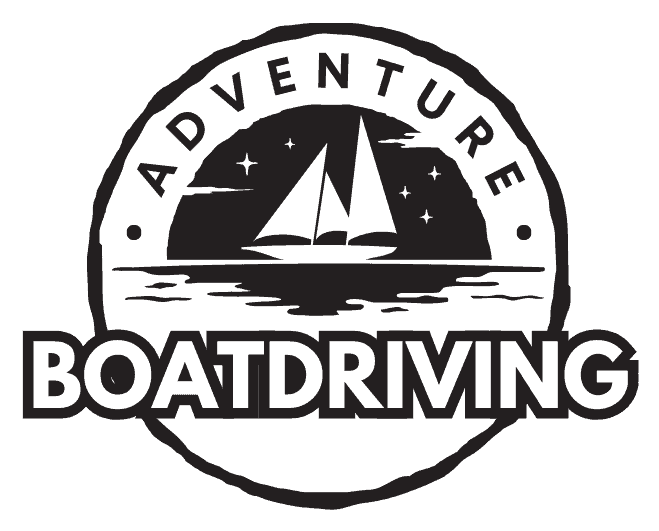

How Much Does It Cost to Dock a Boat? (Price Chart)
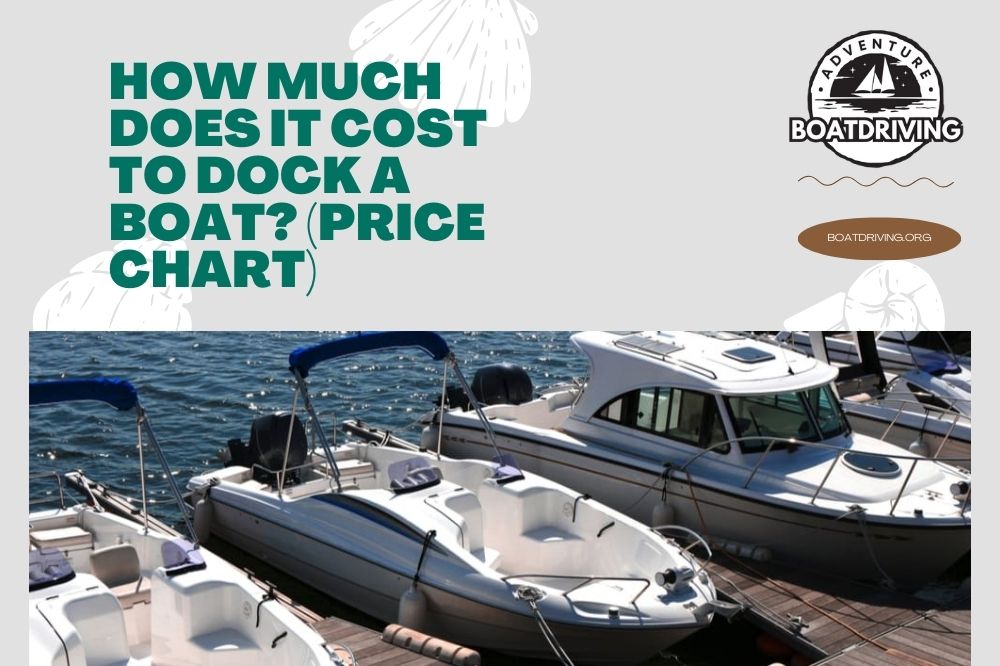
When you have a vessel, you probably wonder how much does it cost to dock a boat. Renting a slip (berth) in a US marina typically costs $12 to $240 per 1 foot (0.3 m) of the boat’s length a year. Roughly, most marinas will rent a spot for $50/ft a year on average.
In most cases, you will probably need to pay $800 to $1,800 per year for an average sailboat. Remember that this number can significantly vary depending on a boat’s length, location, and season. However, you can find alternative berth types that can save you money. Let’s see.
Table of Contents
Factors Affecting Docking Price
Berths types, slip cost in the us and canada, slips costs in europe, docking length, things to consider before docking.
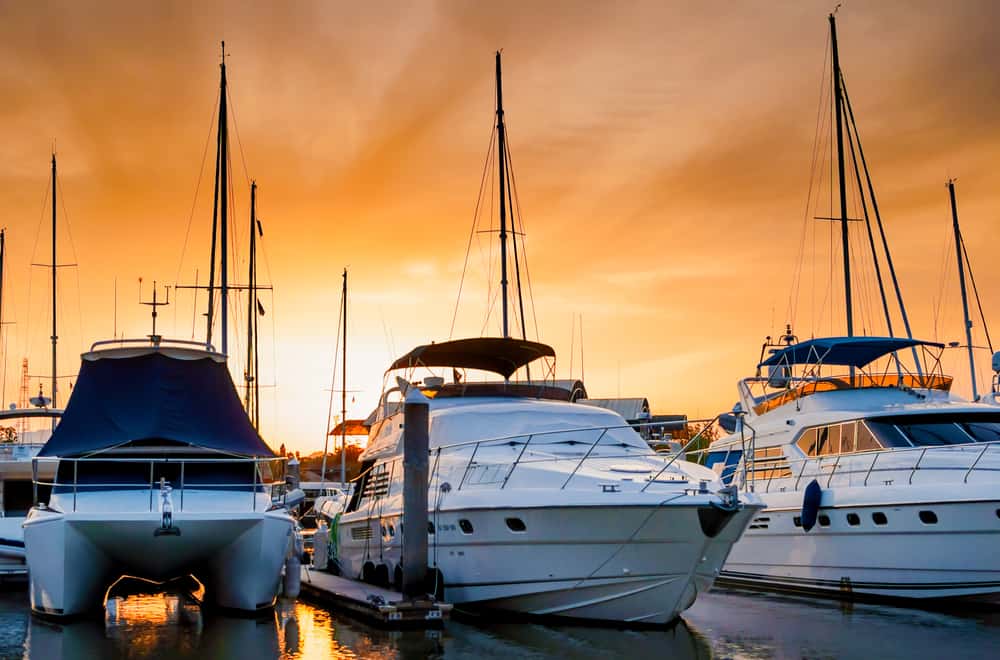
Believe it or not, you can secure your boat in a fixed spot in a few ways. This service price will differ depending on the berth type you choose.
Anchorage – It is a place where you can drop the boat anchor without access to the shore. In this case, you need to provide your own anchor .
Mooring – It is a permanent spot for your boat in the water. In this case, you need to use an anchor fixed to a buoy or seafloor to pin the vessel without direct connection to the land.
Docking – It is tying the boat with slips or berths to a particular spot in a marina. The primary advantage of this method is access to the land with a slip or berth to secure your boat.
In all cases, you need to pay the required fees for keeping the boat at the place . It is possible to take:
- Transient moorings when booking a docking place per day
- Permanent moorings when booking a docking for the entire season
As you can guess, annual berths are less expensive options, and you will typically pay three to four times less than for renting a berth daily. You can also have an opportunity to buy a berth in some marinas, and prices will vary depending on location.
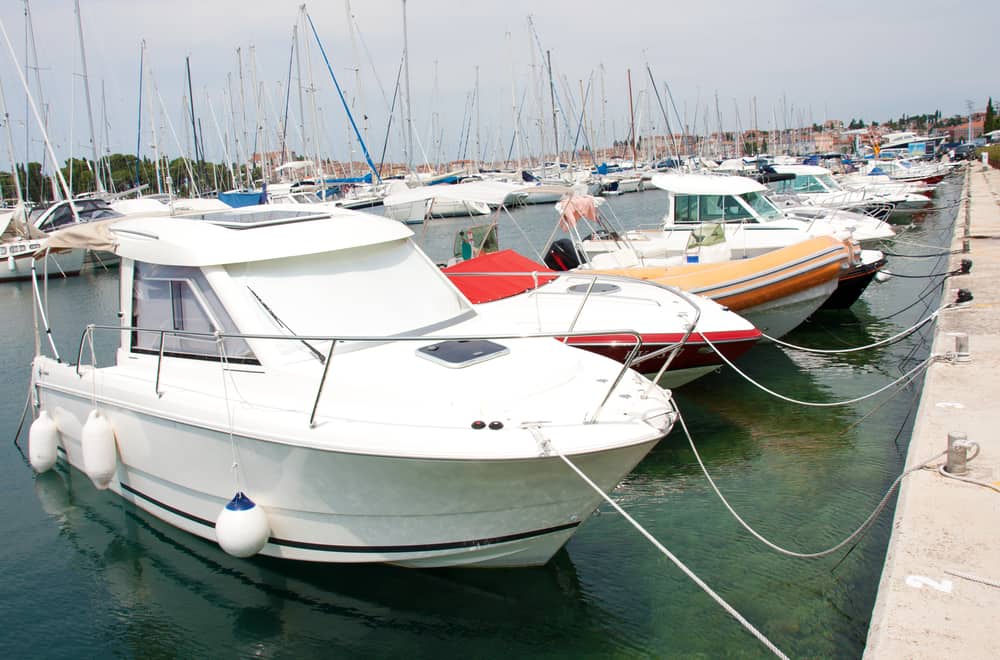
Location will always significantly affect docking price and depend on standards in the particular region. Typically, prices will be higher in city marinas than in small-town docks .
For instance, a budget-friendly Fort Lauderdale will charge $1.50/ft monthly, while you need to pay $23 for the same boat and period in Miami.
| Marina Village | Palm Beach, Florida | $2.9/ft to $3.9 | $25/ft to $29/ft | $32/ft |
| Miamarina at Bayside | Miami, Florida | $5/ft | $23/ft | $42/ft |
| Dinner Key Marina | Miami, Florida | $5/ft | $23 to $24/ft | $42/ft |
Even docks in the same city have different fees. For example, docking a boat in Yacht Haven Marina in Los Angeles is $10.50 to $12.95/ft a year. On the other hand, Marina del Rey in the same city will charge $192 and $240/ft per year.
The same is overseas. The highly desirable Mediterranean has high slip fees, while marinas in the Middle East, Asia, South America, and Africa will be more affordable. However, you can expect that Tokyo, Hong Kong, and Singapore as key cities are expensive.
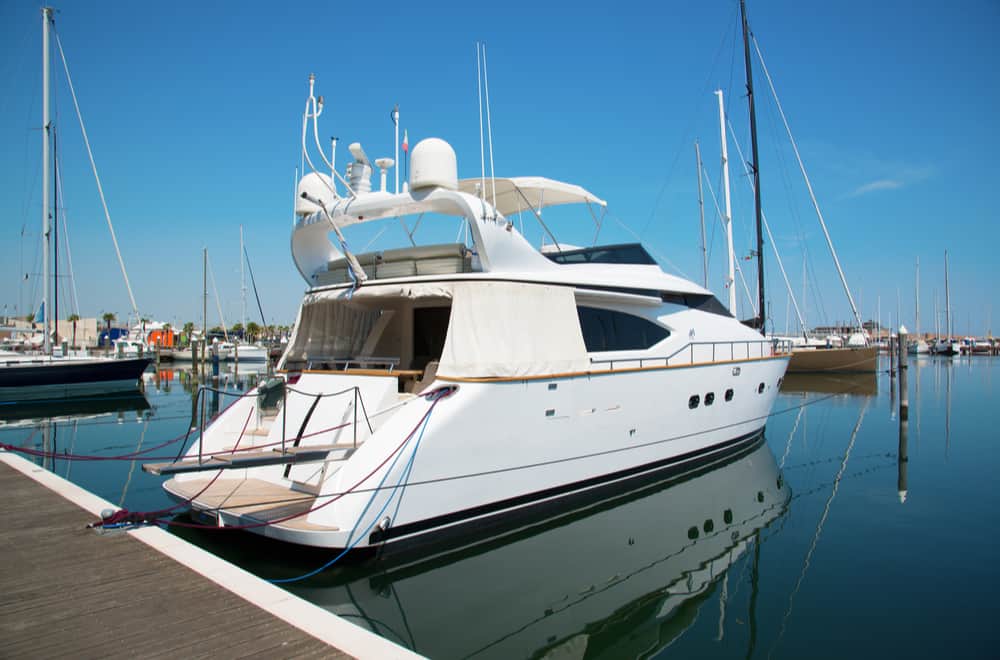
Most boat owners look for seasonal or annual slips. You can pick out:
Regular docking slip
It is a berth in a small marina located in local towns along the coastline. An average boat slips rental cost in such a place is typically $2 to $3 per hour.
If you want to stay overnight, you should pay $4 to $6 for this service. On the other hand, it is necessary to set aside $20 to $25/ft for a monthly bill or $23 or $24/ft when you need a spot for a year.
In this case, you will have a spot for your boat but without premium services available or direct access to the most famous sailing waters. However, it is an excellent solution when you don’t plan to stay long.
Prime location
These marinas are located in cities and famous bays in Florida, San Francisco, San Diego, and Los Angeles. They are more costly but typically offer premium services and quick access to popular sailing waters. Premium services include:
- Boat maintenance and necessary repairs
- Fuel station
- On-site restaurants, cafes, and shops
- Laundry service
- Wi-Fi and TV
- Docking assistance
- Wintering cleaning and storage
Winterizing a boat can cost you a few hundred dollars, but the most expensive marinas can charge even $2,000 for this service.
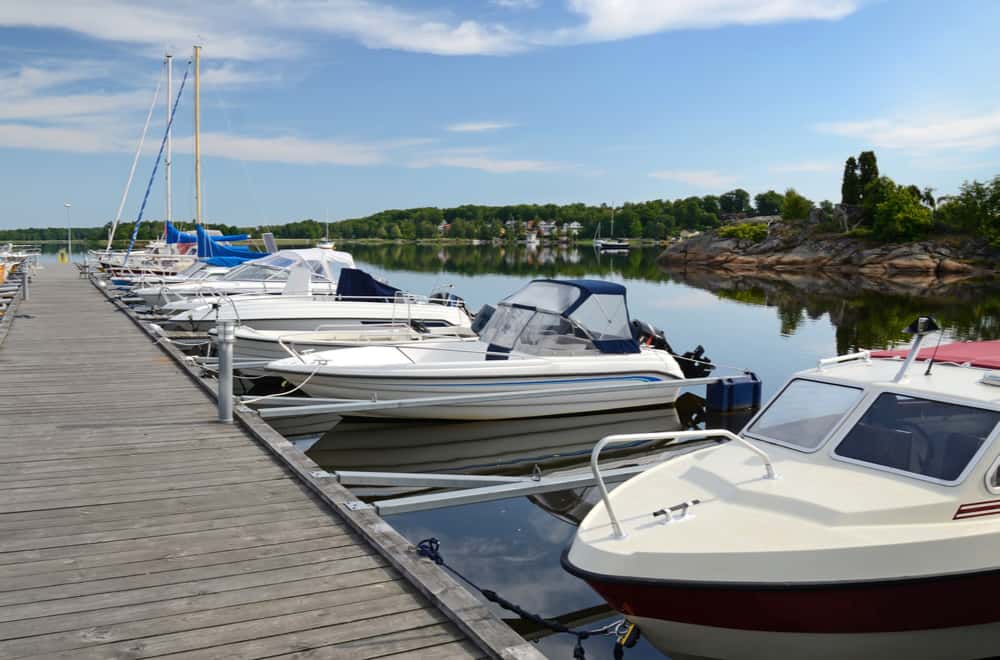
Since the Mediterranean is a popular destination, you should count on high slips costs. Depending on location, you will need to pay annual fees of:
- $50 to $450/ft (€135 – €1,350 per meter) per year in France
- $75 to $175/ft (€225 – €525 per meter) per year in Greece
- $100 to $440/ft (€285 – €1,350 per meter) per year in Italy
- $160 to $350/ft (€435 – €1,050 per meter) per year in Croatia
| Italy (Capri) | Marina Grande | €4.5 per m2 ($0.5 per sq ft) |
| France | Port Saint Tropez | €3.5 per m2 ($0.4 per sq ft) |
| Spain | Marina Ibiza | €3.5 per m2 ($0.4 per sq ft) |
| Croatia | Marina Rovinj | €3.1 per m2 ($0.35 per sq ft) |
| Montenegro | Porto Montenegro | €2 per m2 ($0.2 per sq ft) |
| Greece | Gouvia Marina | €1.2 per m2 ($0.1 per sq ft) |
Greece has not many marinas since Greeks prefer free or cheap moorings and anchorages. On the other hand, you should count on a $4,500 annual fee in Italy and France on average if you have a 32 feet (9.75 m) long yacht.
Remember that prices will vary depending on the marina in the same country. For instance, the most costly port in France is the Old Port of Saint Tropez. It is double in price than the Port of Cannes.
The most expensive marinas worldwide are in Monaco, so you will need to pay $9,000 to $43,500 for a slip monthly. However, a rate can reach up to $100,000 per month during the Grand Prix.
| Italy (Capri) | Marina Grande | €200 ($225.5) daily | €130 ($145) daily |
| Croatia | Marina Rovinj | €150 ($170) daily | €115 ($130) daily |
| France | Port Saint Tropez | €135 ($150) daily | €25 ($28) daily |
| Spain | Marina Ibiza | €105 ($120) daily | €28 ($30) daily |
| Monaco | Port Hercule | €90 ($100) daily | €53 ($60) daily |
| Montenegro | Porto Montenegro | €65 ($75) daily | €30 ($35) daily |
| Greece | Gouvia Marina | €45 ($50) daily | €25 ($28) daily |
Most marinas in Europe have high and low seasons because of harsh weather in winter. In this case, renting a mooring can cost you 70% less in the low season.
The peak season in this destination is from July to the beginning of September, making this period the most expensive in the year.
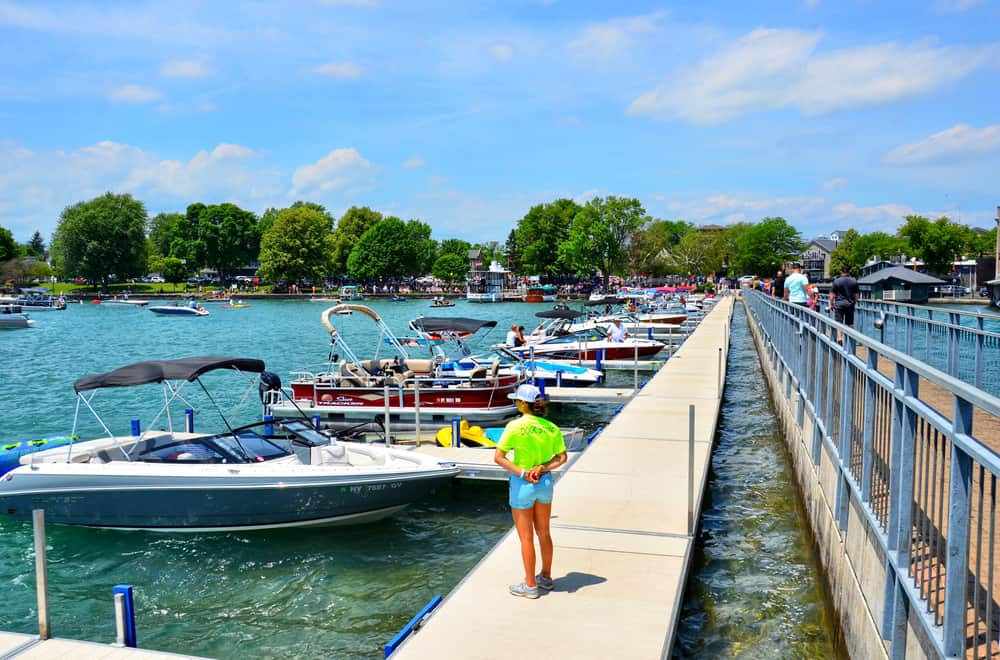
Be prepared that boat size is everything when it comes to docking prices, and most marinas will charge their fees by your boat length in feet/meters.
Be prepared that marinas measure your boat differently, so you should be careful when calculating. You can recognize four measurements by feet:
- LOA (length over all/over air)
- LOH (hull length)
- LOD (deck length)
- LWL (the loaded length at the waterline)
LOH is a documented boat size without extended non-living spaces, like the swim platform or bow pulpit. However, it is not the same as the space your boat will take up in the marina, so you will typically pay a fee regarding LOA.
To make things more complicated, there are a few LOA variances. That is the boat length from the bow spirit tip to the swim platform in most cases. However, some marinas also include dinghy length.
Keep in mind that a marina can charge a higher rate for wider boats like Catamaran. An average width for a slip is 16 to 20 feet (5 – 6 m), and you will pay an additional fee for a wider vessel.
Average prices in the US per boat length
Typically, you will pay more for a longer boat. For instance, the dockage fee in the US can be only $150 a year for regular anchorage if you have a 30 feet (9 m) long boat. The price will be $800 at a standard dock and $5,120 in prime locations.
On the other hand, the annual price of regular anchorage will be $250 for a 40 feet (12 m) long vessel. You will need to pay $1,280 a year for a standard dock, while prime locations charge about $7,200 annually.
| Boat length | 24 feet (7.5 m) | 32 feet (9.75 m) | 40 feet (12 m) | 48 feet (14.5 m) | 72 feet (22 m) |
| Regular anchorage | $150 | $150 | $250 | $250 | $250 |
| Regular dock | $290 | $800 | $1,280 | $1,900 | $3,600 |
| Prime-location dock | $2,900 | $5,100 | $7,200 | $9,600 | $17,300 |
Remember that marinas always offer a discount on slips for docking a boat during the year . If you want to get a permanent spot for an average 24 to 72 feet (7.5 – 22 m) long boat, you should count on an average slips that will cost you:
- $12 to $50/ft per year for regular docking slip
- $120 to $240/ft per year for prime locations like Florida and Los Angeles
- $102/ft per year for a prime Toronto dock location
- $192 to $384/ft per year in Marina del Rey, one of the most expensive marinas
You should also set aside an additional $25 to $50 deposit for a car parking card and security key. Remember that docking a Catamaran is always about 20% more costly because this boat type takes up more space.
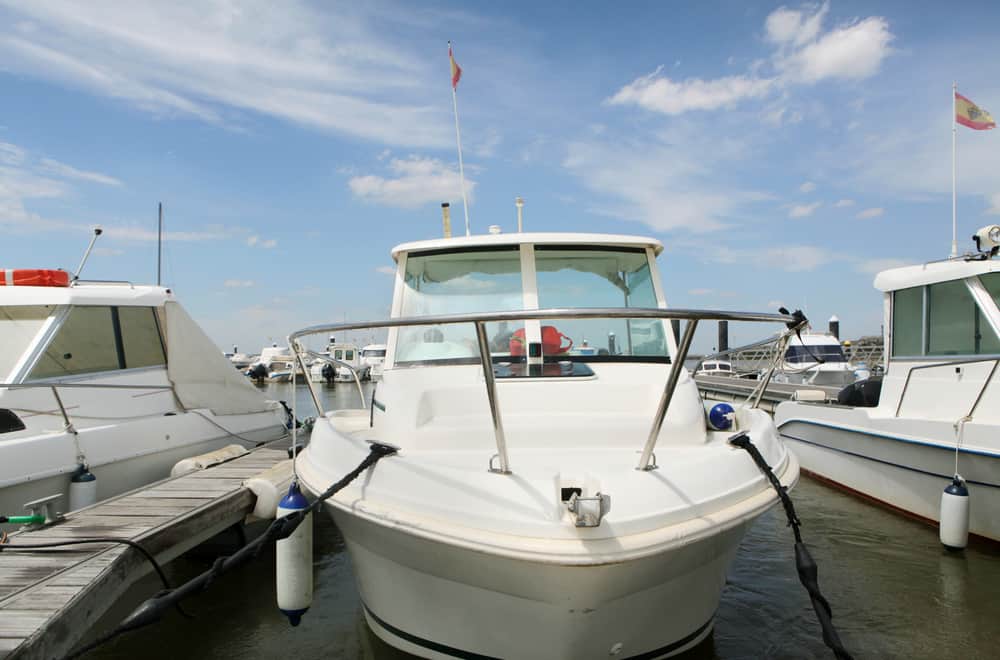
Night vs. month docking
Marina costs are typically two to even five times the cost of an average RV campground when you need overnight docking. However, marinas and local RV parks have similar monthly prices.
In most cases, you will need to pay $20 to $45 for transient moorings per night in the US, regardless of the boat’s length.
Marinas are often cooperative when staying a few days more than a paid week or month. They will charge you a daily rate based on the previous rate in most cases.
Unfortunately, some marinas will charge a higher rate for an extended period, so you need to be informed to avoid unpleasant surprises.
Long term docking
Many marinas are liveaboard friendly , and you can ask for long-term storage for discounted rates. There is no rule about pricing, and savings can be considerable or only a few percent.
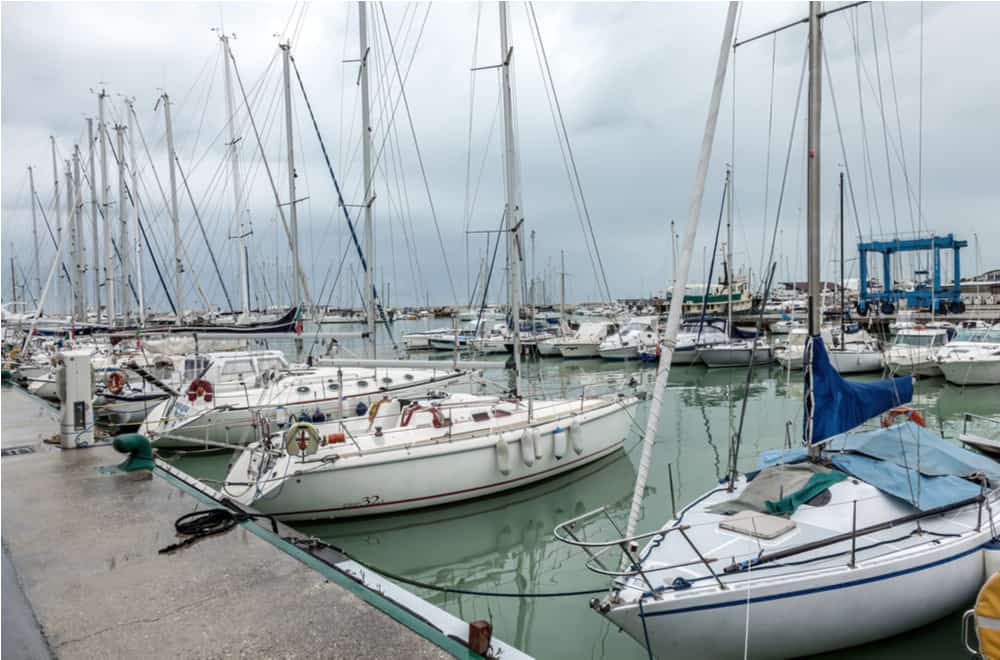
Once you start looking for a slip for docking in a marina, you should calculate a few things, like:
Docking or mooring – A mooring and anchorage are excellent options for you if you prefer getting privacy. On the other hand, docking is a more secure option.
Availability – Be aware that a few top-rated marinas have waiting lists, particularly at peak season. Therefore, you need to pay a waiting list deposit to get in. For instance, the famous Marina del Rey will charge $150 for that service.
Travel time – You should know in advance how long you want to travel. That will determine a marina location, significantly affecting the final price you should pay.
Marina accessibility – You should check on time whether a mooring is accessible at any time or at a particular tide time. The second option will significantly reduce costs.
Marina security – A marina should provide a security guard and controlled access to the docks to keep your boat safe.
Marina condition – It is crucial to check how secure is a marina you want to use. Therefore, you should know about large tidal waves or possible strong currents nearby.
Work policy – Many marinas won’t allow access to unknown people for possible professional service. You need to pick out one of their professionals to help you maintain or repair a boat.
Yacht club marinas – Always check whether a marina is within the yacht club. In this case, you need to become a member, which is typically expensive.
Additional charges – Besides regular marina fees, you need to pay a tax in some countries when using it for less than seven months.
Electricity will cost you $10 to $50 per day, and you should add $5 for the pump-out fee. Finally, you should pay a tip of $5 or $10 to a person who will catch the line and help you plug the boat.
Once you decide to purchase a boat, you should consider docking coast beside the vessel price. Berthing fees will depend on the berthing type, boat type and length, location, and season. The price range is wide, and you should expect to pay $80 or even $17,500 for this purpose annually.
Related posts:
- How to Find Free or Cheap Boats For Sale? (Step-By-Step Guides)
- How Much Does It Cost to Re-Gelcoat a Boat? (5 Facts)
- 7 Types of Boat Lights
- 42 Main Parts of Boat (Name & Terminology)
Similar Posts

7 Ways to Remove Mildew From Boat Seats
Despite our hundreds of efforts to maintain and keep our boat seats as new as possible, mildew always finds a way to destroy our boat aesthetics, don’t they? Panicky and in search of solutions to remove the mildew – the struggle is real! Given constant moisture exposure, even the slightest of carelessness can result in…

3 Simple Steps to Paint Boat Docks
Painting your boat dock helps to keep it protected from weather and other elements. And with the right product, you will prevent yourself and others from falling under slippery conditions. To ensure quality results, I have prepared a guide that details each step of the process for you. In addition, this article will help you…

21 Types of Recreational Boat
A boat is a generic term for any craft that travels on water. Some are used for commercial work, like fishing or paid transport, where the aim is to get from one shore to the other. Others aren’t trying to get anywhere – you ride them for the pleasure of being on the water. It’s…

Can You Take a Baby on a Boat? (11 Tips)
Are you planning on a short trip with your baby? Or do you live on a boat with your infant? Whatever the case is, you must educate yourself regarding tips, dos and don’ts, and disciplines that should be followed while handling a baby on a boat. For instance, how old should the baby be for…

Kelly Blue Book Boat Values (3 Types)
Are you planning to buy a boat or sell your used one? Knowing the value of a new or used boat ensures that you get a deal you are happy with. Like a car or a house, a lot goes into determining a boat’s value. What makes it even more complicated is that numerous online…

10 Best Small Boats with Bathrooms
fWhen buying a small boat for a long trip, do you know that a bathroom is one of the key specs to consider? Many crafts will give you fun with different specs, but which ones come with a bathroom? Read on to find out. Here, we’ll talk about the 10 small boats with bathrooms. These…
Leave a Reply Cancel reply
Your email address will not be published. Required fields are marked *
Save my name, email, and website in this browser for the next time I comment.

Docking and Mooring Fees in the World

Mooring fees meaning
One of the things you’ll have to pay for during your charter or sailing holiday is mooring fees or berthing fees.
What is a mooring fee? A Mooring Fee represents a time based charge applied to all vessels for staying in a marina or harbour overnight, and connecting to their facilities such as electricity or using their water supplies, toilet facilities, ropes and pontoons.
How Much Does It Cost to Dock a Boat?
How much does it cost to dock a boat in a marina? The answer is: it depends. It depends on different factors such as the place you want to dock. Mooring fees depend also on the type of vessel you have and how much time you want to dock. We are going to clarify these aspects and give you a quick overview of how much you have to pay for docking.
To dock a boat, you need an allotted place where you can secure it. This place can be found on a pier and it is called a slip (in USA) or a berth (in Europe). Berthing or mooring a boat allows you to easily embark and disembark. Slips or berths can be found on different types of piers: main piers, finger piers or floating piers.
How much does it cost to keep a boat in a marina? The Mediterranean can be expensive because of how popular it is. The French, Italian Rivieras and Croatia are the most expensive areas.
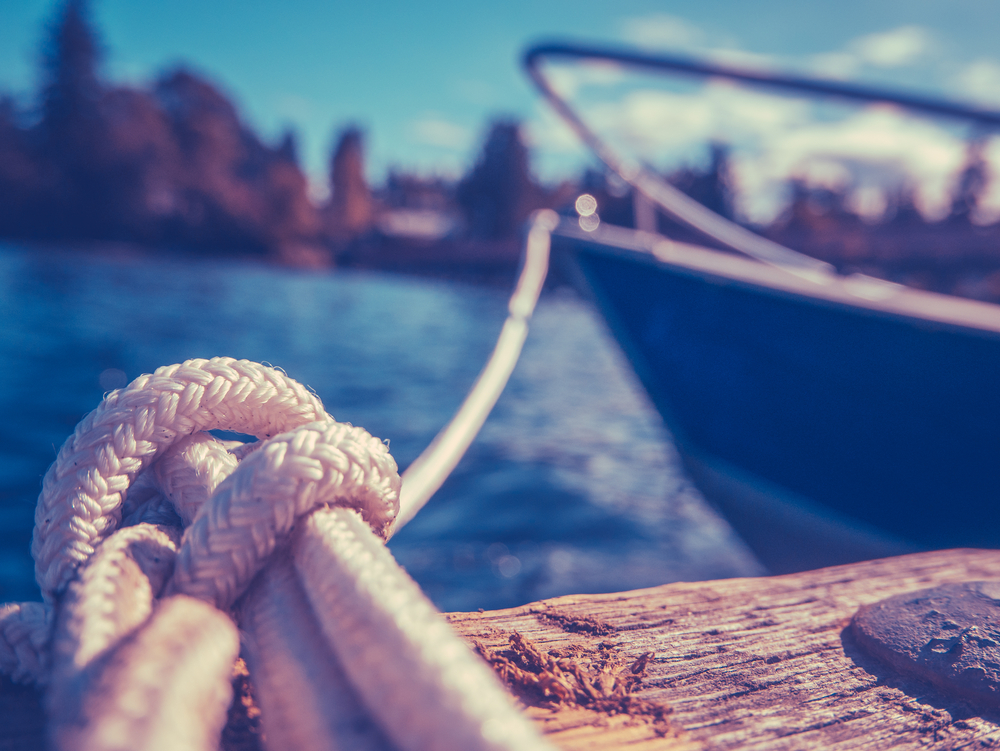
Mooring Fees
Mooring fees in the mediterranean.
Mooring fees vary a lot in the Mediterranean based on the location you choose and the time of the year you travel. The peak season is the most expensive period and it ranges from July to the beginning of September. Besides the season, the length of the boat is a factor that will always influence docking fees for boats. If you rent a docking place for the whole season or for the whole year, you will get discounts.
The busiest period in the Med is between June and the end of September – the summer season.
Southern Europe is generally expensive because the Mediterranean is one of the most popular sailing destinations. Moreover, in the high season, most locations are crowded with tourists and so are the marinas where you can rent a slip or a berth.
The western countries such as France, Italy, Spain are more expensive than Greece for example. The annual mooring costs in France vary between €135 and €1350 / m per year (€45 to €450 per ft), the most expensive port being Old Port of Saint Tropez, which is double in price compared to Port of Cannes.
The prices in Italy range between €285 – €1350 / m per year (€95 to €450 per ft).
The mooring fees in Croatia are substantially higher than in Greece. In Croatia, yacht berthing or mooring fees range between €435 – €1050 / m per year (€145 to €350 per ft.) for a high season contract.
Greece annual fees are between €225 – €525 / m per year (€75 to €175 per ft.).
Monaco is one of the most expensive destinations. A berth in Monaco costs about €1500/ m per year .
| Country | The max. price per sq. m (€) | The Most Expensive Marina |
| Italy | 4.5 | |
| France | 3.5 | |
| Spain | 3.5 | |
| Croatia | 3.1 | |
| Montenegro | 2 | |
| Greece | 1.2 |
Check below the most expensive marina mooring fees in the following popular Mediterranean destinations for a 10 m boat . Some of them (Marina Capri, Port of Saint Tropez, Port Hercule, Ibiza Magna) are the most expensive marinas in Europe .
So, these are the marinas with the highest mooring fees for each country .
| Marina | Daily price (€) in High Season | Daily price (€) in Low Season |
| 200 | 130 | |
| 148.77 | 115.4 | |
| 135.9 | 24.9 | |
| 104.4 | 27.6 | |
| 90 | 52.8 | |
| 66 | 30 | |
| 44 | 25 |
Mooring Fees in USA
In the USA, mooring and slip costs for regular docks vary between 12$ to 50$/ft per year. Popular locations such as Los Angeles, or Florida have higher yearly rates which start from 120$/ft and may reach up to 240$/ft. For transient mooring, the docking fees are not calculated based on the boat’s length and are 30$ on average.
Things to Consider When Picking a Mooring
When picking a mooring, there are different aspects you should take into account:
– the time of the year you want to go on holidays as prices vary accordingly
– the time of the day when your docking place is available based on the tide
– how much intimacy you want: a water mooring or anchorage enables you to enjoy the sea and the surroundings, on the other hand, a slip in a marina grants you access to many facilities
– each marina’s policy; some only allow you to dock if you pay a membership fee.
Types of Berths
Some of the basic terms you will hear in the nautical field are mooring, docking, anchorage and berth. They all refer to the same act of securing your boat in a fixed place, but let’s see the differences.
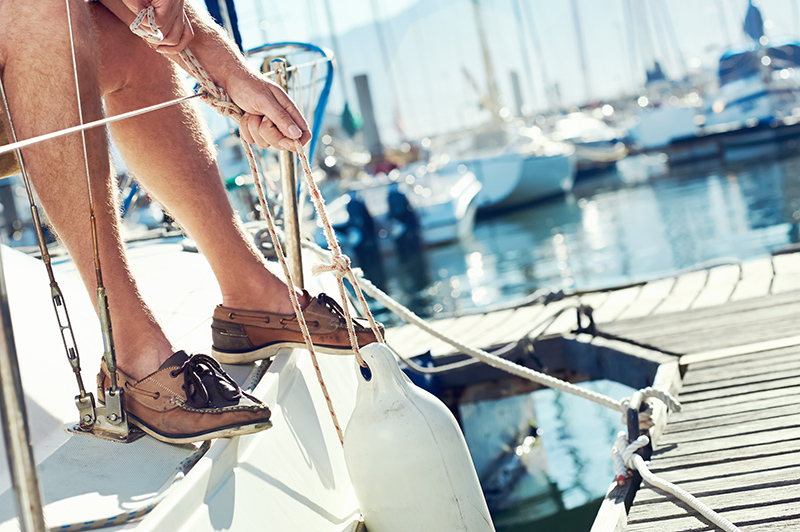
When you moor your boat, you can use an anchor to secure it against the seafloor or buoy. A mooring is a permanent place where you do this. This method allows you to keep your boat steady in one place but doesn’t enable you to access the land directly. To do this, you’ll need a dinghy.
Anchorages are places where boats may drop their anchors. Just like moorings, they don’t provide direct access to the land. but they don’t provide a permanent anchorage point either. Each boat uses its own anchor. Check out the best boat anchors .
Docking ensures direct access to the land. When you dock, you secure your boat to a fixed spot on the land. To dock, you need docking lines. The designated place where you secure your boat in a dock is a slip or berth. By analogy, docking a boat into a slip is like parking a car in a car parking.
Permanent mooring and transient mooring
If you book a docking place for the entire season, you get permanent mooring. If you book a berth per day, you get transient mooring. As you now know, there are different methods of keeping your boat steady in the water. With a little bit of practice, in no time you will be able to make the difference between mooring, docking and berthing and to maneuver your boat according to each scenario.
Berths are probably the best option if you want the maximum degree of safety and comfort. In a marina or harbour, you can find berths for any exigencies and people who are ready to assist you while mooring.
Advantages of Annual Berths
Annual berths mean that you pay an annual fee to dock your boat. The advantage is that you will pay 3 to 4 times less than you would if you rented a berth per day. Depending on the type of vacation you are planning, you might want to opt for an annual berth or not. If you plan on spending the whole time in one place, this is the best and cheapest option. Nonetheless, if you want to sail from place to place, the costs of turning back to the same docking place might be too high. In this case, transient mooring is the only choice.
Premium services
Premium services are available at different marinas. Some examples of such services are maintenance, repairs, fuel station, on-site cafés/restaurants, laundry service, Tv, Wi-Fi, wintering storage etc. If you opt for the latter, the marina will take care of your boat in the cold season, by pulling it out of the water, cleaning and storing it.
The more services are included in a marina’s ‘menu’, the higher its rates will be. However, docking at a well-provide marina might cover all your needs during your holiday
Buying a Berth
Yes, it is possible. If you want to make a berth yours, you can buy it. Not all marinas provide this opportunity, but many do. The prices vary of course based on the location of the marina and the services it provides. Buying a berth can tackle forever the problem of keeping your boat safe. Then again, this might only be an option if you like to spend a lot of time in the same area.
If you want to reduce your docking costs so that you can spend more time at sea, go in the off-season. In this period, mooring fees are up to 70% lower.
In case you own a catamaran, note that these boats may be even 20% more expensive when it comes to docking. This is due to their larger size.
Many marinas offer additional services except for the basic package: slip, water, electricity. Of course, all the additional facilities imply extra costs. In many marinas, you are also asked to pay a deposit. Also, it’s important to note that availability in the peak season is problematic especially in the Mediterranean. Therefore, you should book a berth in time to make sure your place is secured.
Docking and mooring fees are something you must definitely consider before buying a boat because together with it come more responsibilities. There are plenty other details to discuss regarding mooring costs. But it’s easier to contact us directly once you chose the location you want to sail to. Based on it, we will offer you customized advice.
Leave a Comment Cancel Reply
Your email address will not be published. Required fields are marked *
- Yachting for beginners
- Owning a yacht
- Motor Yachts
- Sailing Yacht
- Indian Ocean
- Mediterranean
- Buying or Selling a Yacht
- Yachting Events
- FAQ – Luxury Yacht Charter
- FAQ – Buying a Yacht
- FAQ – Sell your Yacht
- How Much Does It Cost To Charter A Luxury Yacht?
- All our Blog Post & News

How Much Does it (Really) Cost to Own a Yacht?
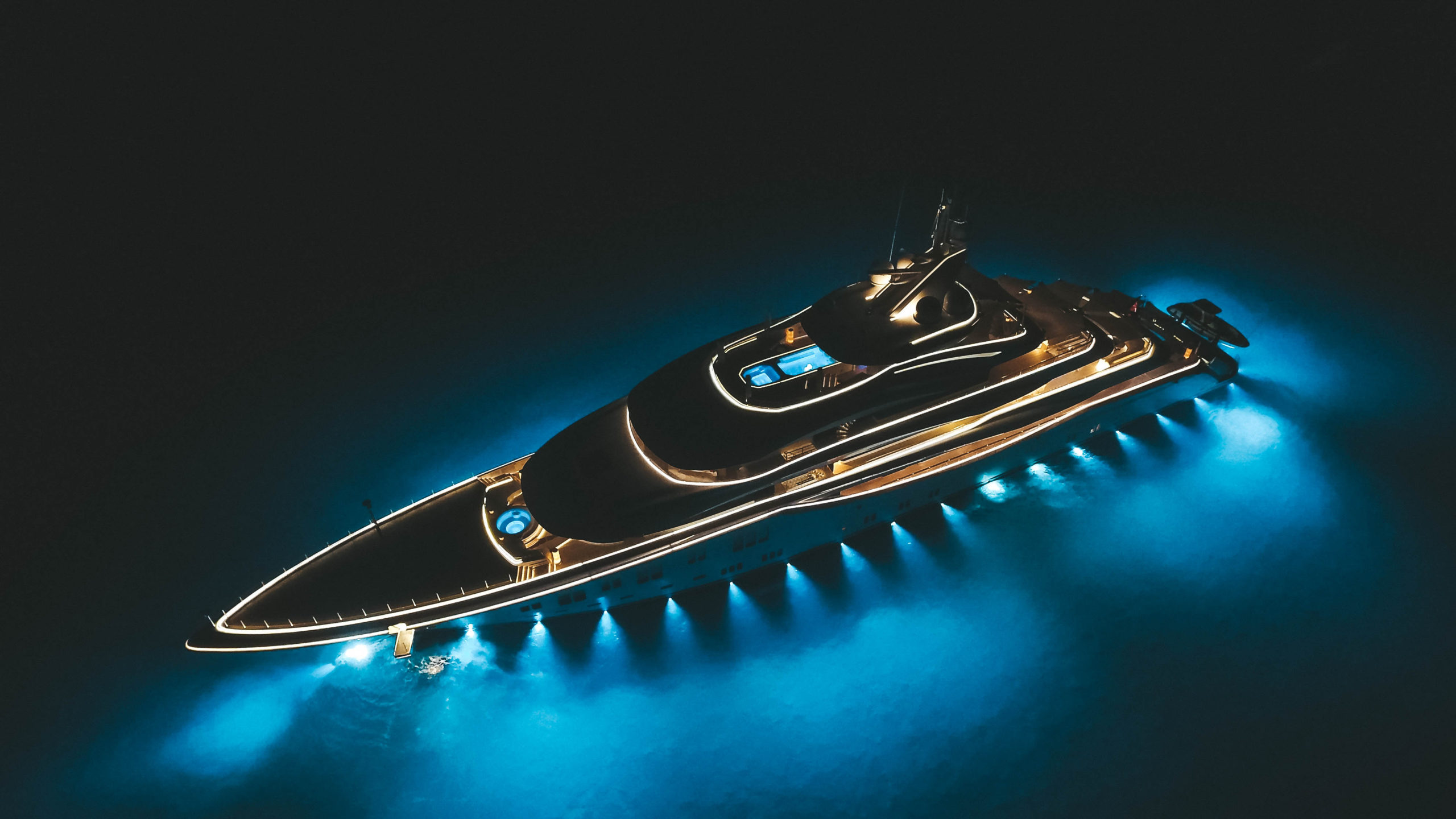
The true cost to own a yacht is an area of concern for many prospects of yacht ownership. And it should be.
Maintenance costs, exploitation costs, total cost compared to yacht charter, we detail in this article the expenses (especially the hidden ones) you have to consider before buying your first yacht !
We also provide you several solutions to lighten your investment and reduce the cost to own your yacht.
If you are looking for the price of a yacht charter (rental), please read this article instead .
How much is a yacht?
Before diving into the expenses that comes monthly, yearly or every decades once you own a yacht, let’s answer the elephant in the room: How much is a yacht (alone) in the first place? The short answer is… it depends, of course. But in most cases, the longer the yacht, the higher is her selling price.
Generally speaking, you can expect to find yachts for sale in the following price ranges:
- Below 50ft (15m): between 500K – 2,500,000 € / USD
- Between 50-70ft (15-21m): between 2 millions and 6 millions € / USD ( See our 9 catamarans for sale under 6 millions here )
- Between 70-100ft (20-30m): between 6 millions and 20 millions € / USD
- Superyachts over 100ft (30m): minimum 10 millions € / USD
You can always find exceptions to the rule and find cheaper or more expensive yachts for sale outside of these price brackets.
A lot of factors come into the selling price of a yacht: supply and demand, brand / model reputation, age and condition of the vessel, urgency or lack of for the sale and so on.
What are the main hidden costs that come with yacht ownership?
You probably already guessed it, the cost of owning a yacht doesn’t stop at its purchase price . In some cases, the price you bought your yacht at can seem like a bargain, but it really isn’t once you start adding all the hidden costs, and many of them come yearly.
Here are the main ones you should be wary of.
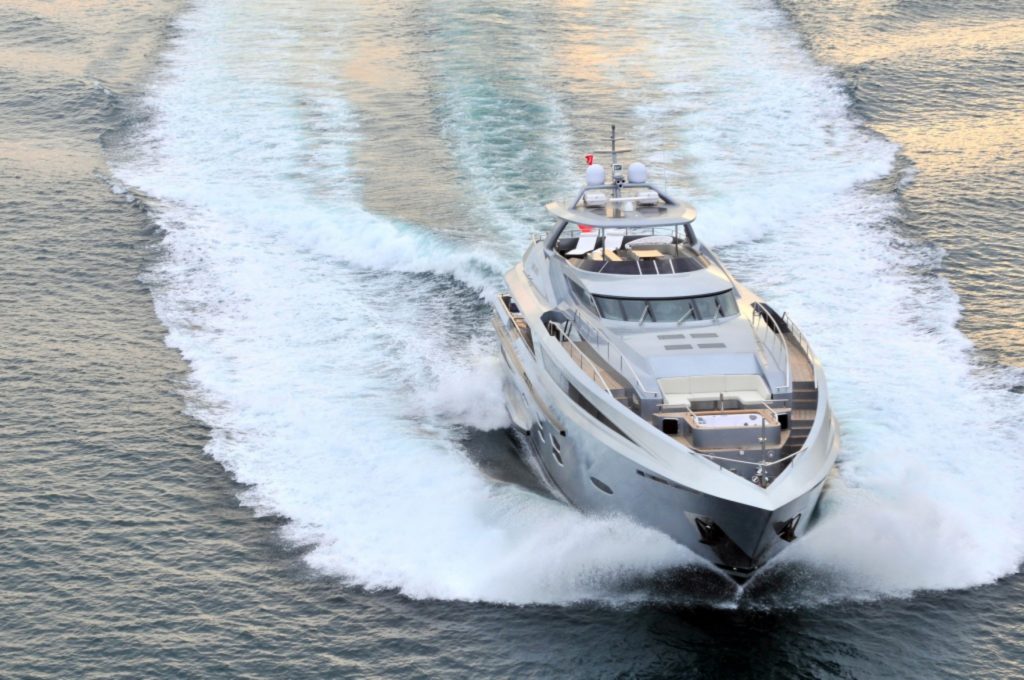
Yacht exploitation and running costs : always calculate them carefully before buying your yacht
It always cost you money to exploit your yacht.
When you are chartering a yacht, a part of these operation costs is included in your APA (Advanced Provisionning Allowance) .
When you own a yacht, these costs still apply , but you will have to pay directly for them.
Among the main operation costs, the most important are usually the following:
- The fuel: its cost will depend on the type of boat, her fuel consumption, the region, and the distances traveled;
- The mooring fees which depends on the area but also on the boat size;
- The crew, if you need it. The cost will depend on the frequency and the crew’s size;
- The communication fees;
- The food and beverages supplies;
- All the expenses related to your leisure activities.
Yachts maintenance: a cost that you should definitely not overlook
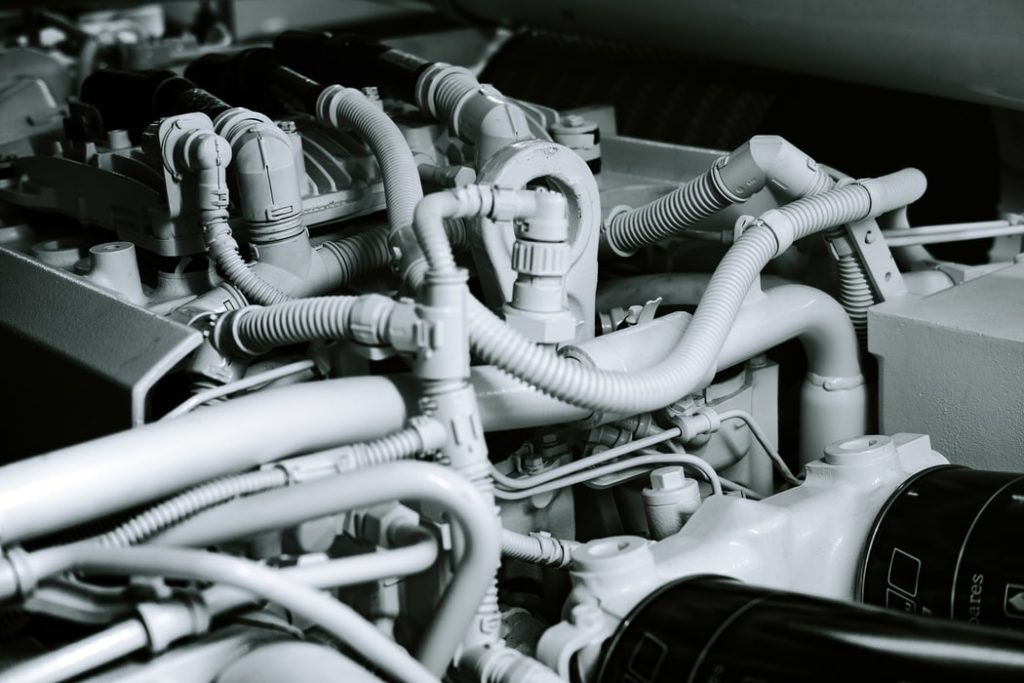
Even outside of its operating period, it still costs you money to own your yacht!
Maintenance of your boat isn’t an option and must be done on an ongoing basis. The price vary depending on the type of yacht you are owning (motor, sail, etc…), the size of the vessel, but also how old she is.
The maintenance costs include :
- The regular maintenance of certain equipment, like engines, thrusters, sails, rigging, safety equipment, hull(s) (fairing)…;
- The occasional maintenance operations in case of breakdown or damage;
- The painting;
- The cleaning and the specialized maintenance products (for teak, leather, …).
The costs of maintenance and upkeep will obviously not be the same if you do it yourself or if you call in specialists. But regardless, you should have a budget buffer dedicated to maintenance costs when you plan on buying a yacht, especially if she already had a long sailing life.
The taxes and insurance premiums of a yacht: a cost that most forget
Consider the different taxes (at the purchase and annual) and the yearly yacht insurance that you have to pay. A specialized insurance policy is generally estimated at between 0.8% and 1.2% of the boat’s purchase price per year.
Must Read : Yacht Insurance : The Definitive Owner’s Guide
Yearly harbor fees : a very important hidden cost of yacht ownership
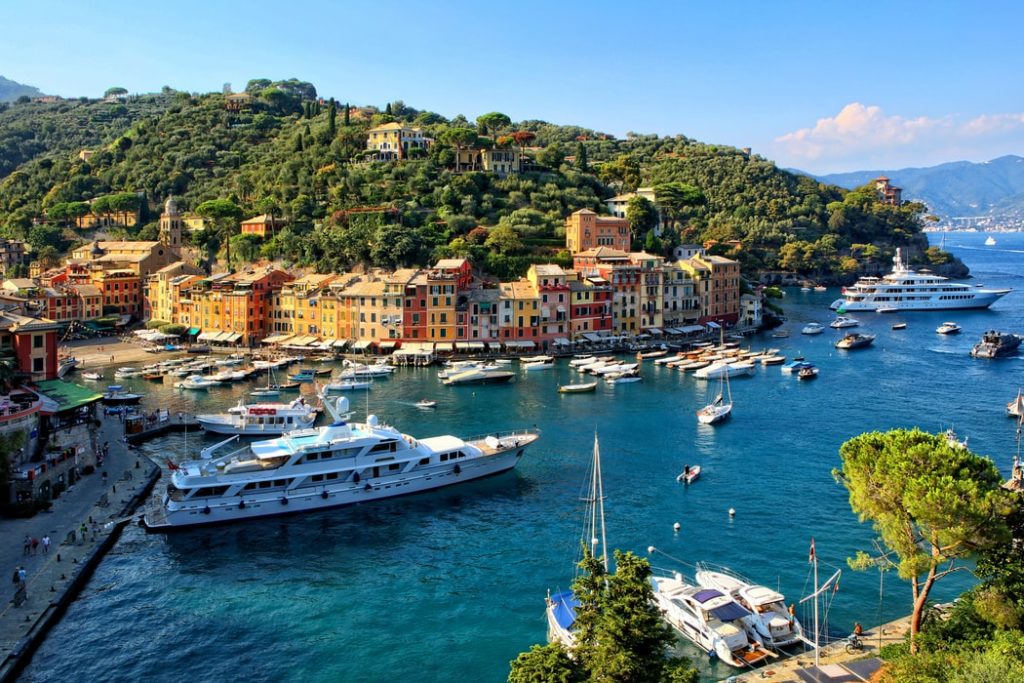
The port and/or winterization fees are also a big part of yacht ownership costs that you should carefuly estimate.
Depending on your region, you may need to consider “dry-docking” your boat, which involves handling, transport, and storage which can be really expensive.
If you can leave your yacht in the water all year round, you will need to go for a harbor ring concession.
Depending on the marina and its infrastructure, the region, and your boat’s size, the costs may considerably vary from a few hundred dollars to thousands of dollars a month . However, it is easy to obtain this information from marinas once you have chosen which yacht to purchase.
The depreciation’s price of a yacht
A yacht, like a car, will depreciate . It is difficult to estimate the depreciation, as it depends on economic conditions, exchange rates, price inflation when new, the type of boat, and the shipyard.
However, it is reasonable to estimate a minimum depreciation of 10% in the first year, then 7% in the following years. From the fifth year on, the depreciation tends to slow down. On the other hand, the operating costs increase.
Summary of the main operating and maintenance costs of owning a yacht
So, to sum up, how much does it cost to own a yacht? It largely depends on your type of yacht and your location.
But in general, owning a yacht will cost you between 10-25% of its value annualy . The longer the yacht, the likelier you are to be at the end of the spectrum.
Here are the reasonable costs you could consider:
- 10% of its value annually for a 60ft (18m) / 1 million USD yacht and below (=max 100K / year)
- 20% of its value annually for a 100ft (30m) / 10 millions USD yacht and above (=min 2 millions / year)
These brackets of total costs include everything: usual yacht maintenance, upkeep and operating costs that will be distribued as follow:
- Communication
- Maintenance
- Insurance premiums
- Harbour fees
- Cost of depreciation
Are you worried? Do not. Luckily, there are numerous ways to decrease the overall cost of yacht ownership and still enjoy yachting as it should be. Read the next paragraphs to know these valuable tricks.
If you liked this article you will also like : HOW MUCH DOES IT COST TO CHARTER A YACHT?
How to reduce the cost of yacht ownership?
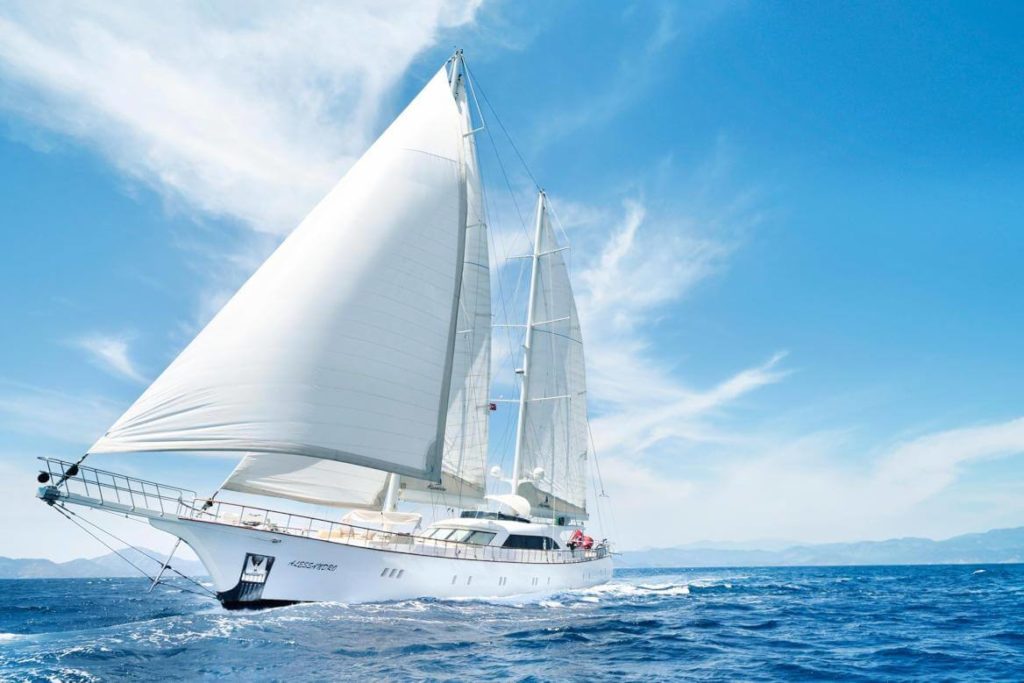
A yacht keeps on costing money even when not in use, so the best way to make it a more profitable investment is to increase its exploitation.
Renting your own yacht : a good way to reduce the costs of owning a boat
When you are not using the boat, you can earn income by renting it out. The rental price depends on the type and size of the boat, but also its location. While making money from renting is possible, don’t expect to pay back all your expenses. Nevertheless, it will help you in avoiding your yacht becoming a financial burden.
The easiest way to do this is to hire a professional charter company to help you. If you go for a reputable and experienced company, you will benefit from their expertise and contacts. It will also save you from legal, insurance, and withdrawal issues and avoid red tape.
On the topic : Yacht to Charter : Can It Be Profitable?
Fractional yacht ownership: share the cost of owning a yacht with co-owners
Another solution to own a yacht at lower cost is fractional ownership of a boat , which means that you own a fraction of it. It can be half, a quarter, or even less. For a long time, boaters have been opting for this option of partial ownership with friends or family. These days some companies create formalized fractional ownership arrangements for more guarantees.
For example, in partnership with the Windward Islands, SAILING RESORT proposes fractional boat ownership on the fabulous trimaran, the LEEN 72’. So you can become a co-owner of the new hybrid-powered multihull which can accommodate up to 10 passengers and 4 crew members. You will enjoy private use of the trimaran (depending on the period) from 6 to 12 weeks during the first 5 years.
This program proposes a profitable commercial operation with 24/7 premium service. It is a tailor-made solution for all those who want to feel like owners of a prestigious yacht for a few days a year while limiting their investment and responsibilities. WI manages the operation of the yacht for you out of your personal use, like the charter’s organization, maintenance, insurance, annual mooring, and all other administrative tasks.
Once you have weighed the pros and cons and have the means to finance both the purchase and the annual costs (maintenance, operation, …) of your yacht, you should go for it! Indeed, if you can evaluate the hidden costs and expenses of owning a boat, the freedom and unforgettable memories are priceless.
Yacht Charter remains a cheaper alternative than yacht ownership in many cases
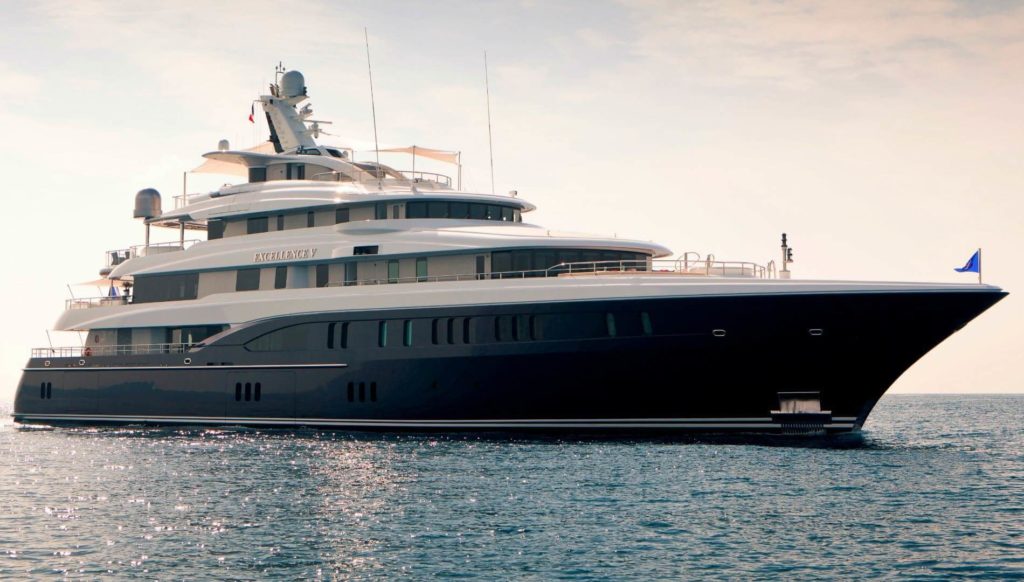
If you can’t enjoy your yacht frequently or are still unsure about whether it’s worth the cost or not to own a yacht, you might consider chartering instead. This will allow you to try out different models , from various shipyards, and see which ones you prefer.
Therefore, the cost of renting a yacht will save you from having to worry about all those hidden costs of owning one. All you have to do is pay for your charter, your cancellation insurance and set your APA during your stay. This way, you only pay money, time, and effort when you use the boat.
What is the (true) cost of chartering the yacht you've seen? 💰⛵
The advertised prices of all charter companies do not include APA, VAT & other variable costs.
Use our calculator to get a 100% FREE estimate of the REAL total cost of your next yacht charter! ⬇
Read also : SUSTAINABLE YACHTING: HOW IS THE BOAT INDUSTRY BECOMING MORE ECO-FRIENDLY?

Frequently asked question
For a 60-foot or million-dollar yacht, the cost per year will be about 10% of its value or $100,000 per year.
You should expect to pay about 20% or more of the original price of your boat to run it annually. So, for a $10 million yacht, the cost to operate will be about $2 million per year, including fuel, insurance, dock fees, maintenance and repairs, crew, etc.
A 180-foot superyacht and/or mega yacht costs a minimum of $4.75 million per year to operate and maintain. Kitty McGowan of the US Superyacht Association estimates an annual budget of $1 million for maintenance and repairs, $350,000 for dockage, $240,000 for insurance, $400,000 for fuel, and $1.4 million for the crew. Add another 15-25% of the vessel’s value for V.A.T.
Once you have weighed the pro and cons, if you can afford the purchase and all the hidden annual expenses, have found your dreamed yacht, and have time to enjoy it, you should go for yacht ownership!
It is not the best way to make money, but you can minimize your annual expenses by renting it or opting for fractional boat ownership.
It’s hard to tell. As long as you have the money and enough time to enjoy it, it is worth owning a yacht! Everything cannot be estimated. For example, it will bring you invaluable freedom and happiness.
One of the easiest way to reduce the maintenance cost of a yacht is to fractional yacht ownership. That way, the maintenance expenses are spread among co-owners according to their shares.
It varies greatly depending on the size of the yacht. For a yacht of 60ft (18m), you will likely spend around 10% of its purchase value each year in maintenance and exploitation costs.
Luxury yachts have maintenance and operation costs that are around 10% of their value yearly. So if a yacht value is 2 millions USD, its maintenance and operations costs should be around 200K / year.
Operating a sailboat is usually 20-40% cheaper than the same size motoryacht. Motoryachts tend to be more expensive to operate than sailboats as the fuel consumption can become an important expenditure fast.
A small yacht below 50ft is usually for sale between 500K and 2,5 millions USD / €. A mid-size yacht between 50ft and 100ft is usually for sale between 2-15 millions USD / €. Above 100ft, the selling price is rarely below 10 millions USD / €.

What is a Yacht Club? Benefits & Features Explained
Buying a yacht : the frequently asked questions, you might also like.
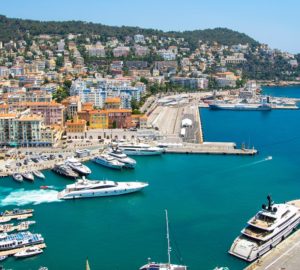
What differentiates a yacht from a superyacht or a mega yacht?
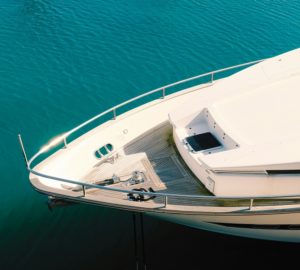
Chartering Requirements and Regulations: A Guide for Boat Owners
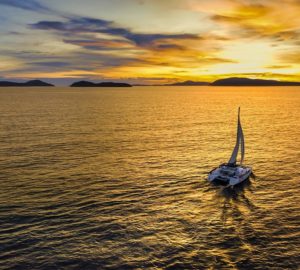
What are the Fastest Cruising Catamaran on the Market?
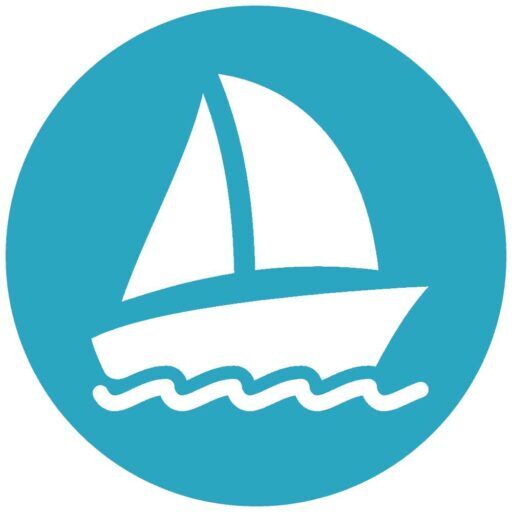
WaterCraft 101
Your guide to fun on the water!
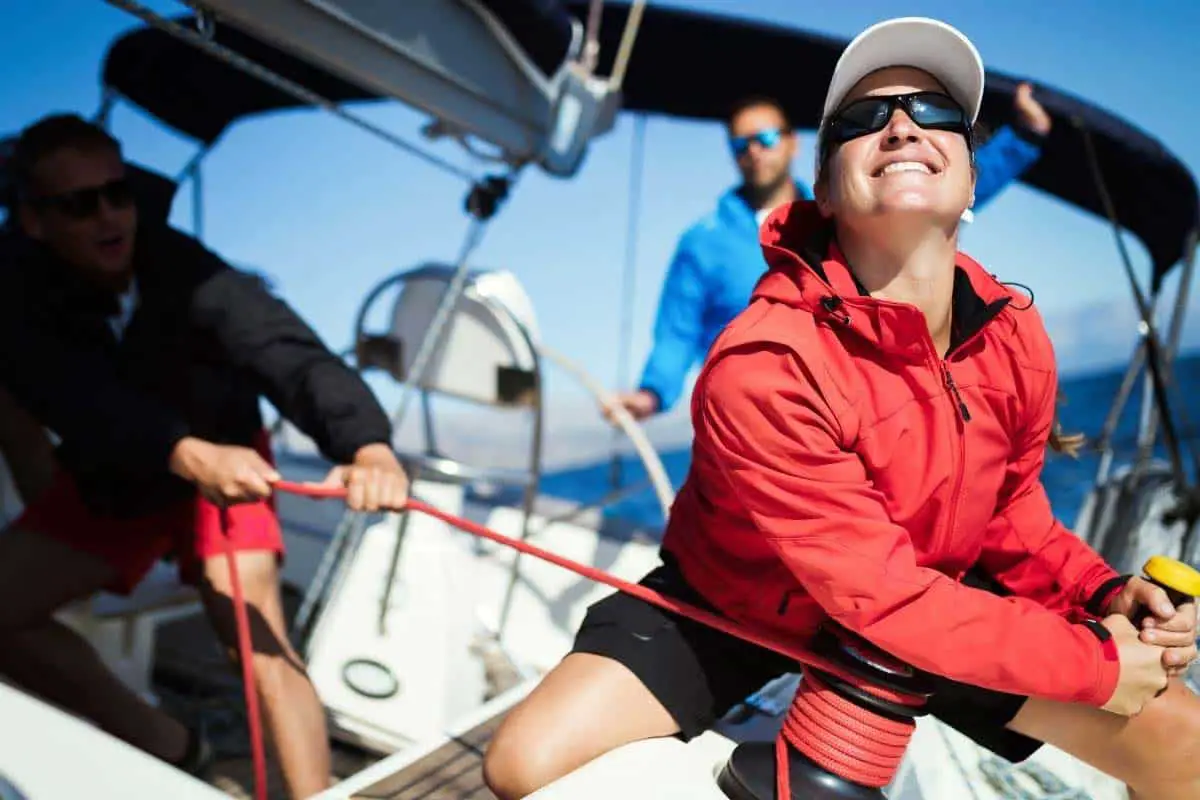
Boat Ownership Costs And Expenses (Read This Before You Buy!)
Are you a new boat owner, or plan to be one soon? If yes, then great! First things first though, there will be some significant boat ownership costs involved and you’ll need to know what to expect. Not to freak you out, but the last thing you want is for you to be that guy who leaves his boat docked for months on end just wearing away because you didn’t anticipate the ongoing costs of owning and operating your boat.
So, how much does owning a boat really cost?
You can expect that a $20,000 boat will cost between $2,656 – $3,000 dollars a year or more in ongoing expenses. These boat ownership costs include maintenance, insurance, registration fees, docking fees, and gear necessary for the operation and safety of the vessel and its passengers.
Anticipating boat costs is a smart way to avoid a sinking debt driven ship (pun intended!). Do not become boat poor. It’s not a good look.
This article will provide information about boating expenses and the so-called hidden costs of boat ownership. It tries to assist mainly first-time buyers in preparing for and reducing financial burdens where possible.
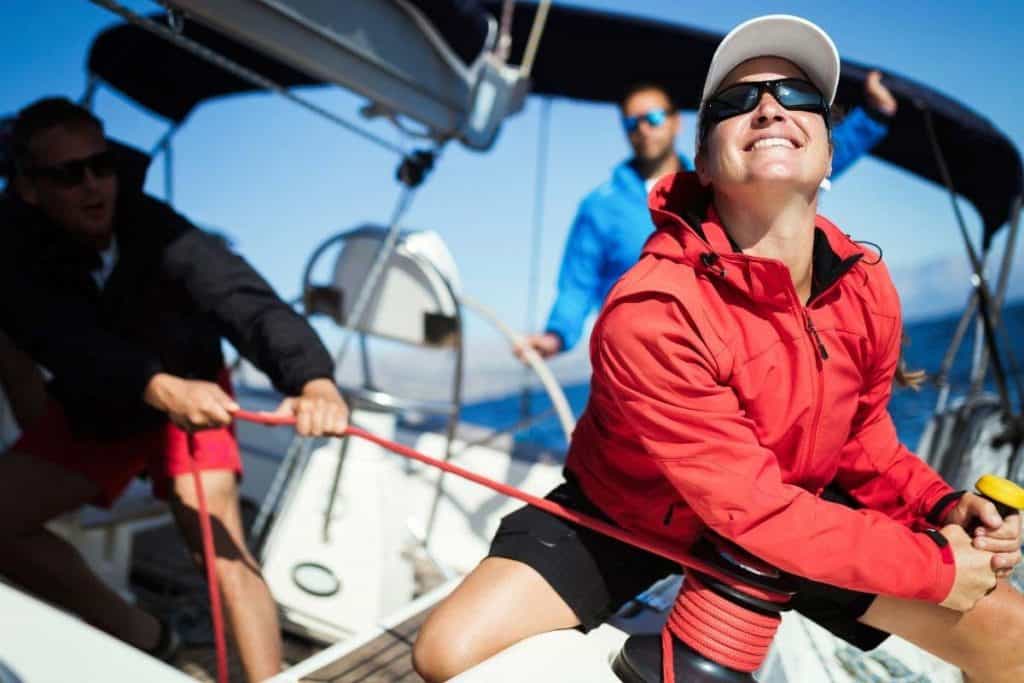
The average age of boat owners is 60 for sailors and slightly younger (55) for power boaters. Younger boat users haven’t always been keen on buying, and this is something organizations such as the National Marine Manufacturers Organization ( NMMA ) are working desperately to change.
But not many organizations are successfully promoting recreational boating, especially in this economy, and the boating lifestyle still appears out of reach for many people. But is boating that expensive, or is it just our perception of it?
Discover Boating published their findings from a recent study where they indicated that first-time buyers had significant concerns over what they called “hidden boating fees,” which tend to show up right at the end of the purchasing process. It shows how seriously the industry needs to take the issue of transparency.
Table of Contents
Comprehensive List of Boat Ownership Expenses
Here’s some straight talk about the expenses you can expect to pay for once you purchase a boat. Later we’ll see how these expenses compare between a sailboat and a motorboat.
1. The Purchase Price
On average, a mid-sized boat measuring around 25ft in length will set you back about $40,000. Of course, you could compromise a little on the size or go for a used boat, and in that case, the purchase price reduces significantly. Check out Bloomberg or NadaGuides to get a clear picture of how these boats are priced.
So for our example, let’s set the buying price at a lower range of $20,000. That way we can base our expenses off this initial purchase price, and it will make it easier for you to calculate your expenses if your boat costs more or less than this amount.
2. Boat Insurance
Most insurers will offer boat insurance at the rate of 1.5 – 2.0% of the boat’s value (also known as hull value) per year. So if your ship is valued at $20,000, then insurance would be around $400 a year on the higher side. Remember that insurance rates differ based on location, so prices will typically be higher in hurricane-prone regions for instance.
Insurance prices also vary greatly depending on whose operating the boat, whether you are occasionally using it for fishing or if you’re a regular water skier / wakeborder. Boating insurance also has a direct correlation with your driving record. Better drivers get better boat insurance rates.
Average Annual Insurance Cost: $400
3. Boat Registration
Your boat requires registration, much like any other vehicle. The boat registration process is managed at the state level so expect some variations in cost. We’ll set the average registration cost at $225 per year.
Licensing for the Boating Safety Education Certificate may also apply here. Still, the good news is once you get certified, which can cost anywhere from $150 to $300, it’s good for life (but again, check state licensing rules to be sure).
This certificate licenses you to operate a personal watercraft (PWC), powered by a 25hp motor or higher. The National Association of State Boating Law Administrators ( NASBLA ) is an excellent place to find more information.
Average Registration Cost: $225
4. Property Taxes For a Boat
Some states like Florida and California require a personal property boat tax. This tax is different from sales tax or use tax. Boat property taxes (if any) vary wildly depending on the state and county you live.
You’ll need to check with your local county offices to see if this tax will apply to you or not. If it does, your boat’s value will be assessed as tangible property (just like a house) and you will pay annual property taxes on the assessed value.
Taxes Cost: Varies
5. Mooring (Keeping Your Boat in The Water)
Mooring costs fluctuate fundamentally based on geographic location, the size of your boat, specialized boat care, proximity to restaurants and other facilities, etc. If you want a premium marina with round the clock security and incredible scenery, then you’re going to pay something in the range of $1,000 to $2,000 annually for a larger boat.
But you don’t always have to pay for a mooring: A decent boat yard can serve as a mooring for your boat when you’re not sailing, and they only charge a flat seasonal fee. Alternatively, if your boat is smaller, you may just store it on its trailer at home for free in between outings.
Mooring Cost: Varies
6. Row Boat, Dinghy
If you pay for mooring, you will potentially need to purchase a smaller boat for traveling to and from your primary vessel. Small rowboats cost about $1,000, and you can always go for a used one for half the price or find a far cheaper option online. Cheaper ones will be visibly old, but they get the job done.
Row Boat Cost: $500 to $1,000
7. Winter Boat Storage
If you live in colder climates, there will be an annual cost of about $1000 – $2,000 for winter boat storage, which involves someone hauling your boat and placing it on a set of blocks. The charge covers this service plus a cover wrapping that is thrown over the boat all winter.
Again the other alternative here is to move your boat to your property, assuming there’s plenty of space in your driveway or backyard.
Storage Cost: $1,500
8. Trailer
Trailers vary in price based on their size and material, so if you’re buying an aluminum trailer for a 20-foot boat, it may set you back anywhere from $1,000 to $2,000, with cheaper options online in the used section. There is also a DMV registration fee for boat trailers, which costs around $5 (may vary in your area).
Aluminum trailers are the preferred choice for their lighter weight and the fact that they don’t wear from rust and or break easily. However, there are other models made from steel or iron that will serve the purpose. They weigh more but are generally more affordable.
Trailer Cost: $1,000
9. Routine Maintenance Cost
Most most routine maintenance estimates are around 10% of the boat value annually. So basically, the more expensive your boat, the more money it will cost to maintain. Maintenance typically involves servicing the engine, anti-fouling, sail and rig, electrical equipment, upholstery, repainting the hull, fixing hull damage, upgrades, replacements, and so on. Some owners carry out the essential maintenance themselves, but they always set aside a budget for professional maintenance.
Maintenance Cost: $2,000
10. Fuel Cost
There will be the added cost of gas, oil changes, and regular engine maintenance for anybody using a motorboat. More significant engines like 4-stroke motors will use up more gas, and also the number of times you take your boat out will determine the cost of gas.
Cost: varies
11. Must-have Safety Items/Boating Accessories
The following is a list of 15 crucial boating accessories that you must purchase and renew to stay safe out on the water. We haven’t included the cost for each item; however, it is worth pointing out that these items don’t come with the boat and require additional spending.
1. First-Aid kit
You must be able to treat minor injuries or ailments, and this is possible with a range of neat medical kits that can cost as little as $10 or as much as $1,000. It depends on what medical emergencies you’re planning for or how far you plan to cruise. Here’s an inexpensive first aid kit (Amazon) that’s got everything you’ll need.
2. Solutions for Motion Sickness
First-timers may find that motion sickness is pretty strong, and in that case, it helps to have devices or treatments that prevent or help manage it. Motion sickness strips and unique wrist bands are everyday items used for motion sickness.
3. Depth Finders
A depth finder from companies like Hummingbird or Faria Beede will tell you how deep the water is so that you never run the risk of damaging your hull or, worse, getting stuck somewhere out in the water. Portable ones like the Garmin Striker Plus 4 (Amazon) are cheaper and will give you the same readouts, so there are different options here.
4. Life jackets
A single, quality life jacket will often cost you over $50, and you need to have at least one life jacket for every person aboard. The Stearns Classic Series Vest (Amazon) will provide the right protection and save you some money in the process.
The life jacket should also have a whistle installed if it doesn’t come with one. The Fox 40 whistle comes with a break away lanyard and will get the job done. It is also wise to have a small flare and pockets to store any relevant survival item in your life jacket or vest.
The cost of the life vests alone can set you back several hundred dollars in order to outfit your boat safely to carry several people.
5. A Beach Anchor
These are particularly useful for people with smaller boats that can dock anywhere. A beach anchor will stake into different types of ground so that your ship doesn’t slowly drift away. Where there’s firm ground, you can hammer one of those spike varieties into the ground. The Slide Anchor Spike (Amazon) works well in shallow water or on the shore.
6. Dry Storage Box
You must have several of these and have them packed with spare tools, GPS, smartphones, and other electronics that may be useful. Ensure that your storage boxes can float, and don’t load too much equipment into a single box. Spread out your gear among several of them, some carrying the same or similar equipment.
- Large dry box for bigger tools and equipment (Amazon)
- Smaller floating dry boxes for phone, keys and electronics (Amazon)
7. Device Chargers
Solar-powered chargers are considered essential for larger boats. Ideally, your boat should have available USB sockets attached to solar panels; but if this isn’t the case, portable solar panels also have power ports that you can use. Plus portable panels like this one at Amazon can also be used for camping or RVing.
8. Navigation Equipment
When taking the boat out to sea or on a large lake when you are likely to cruise away from familiar routes, navigation equipment is needed. A simple marine GPS (Amazon) will suffice; however, for the more complex and sensitive GPS equipment, expect to spend thousands of dollars.
Overall Cost of Safety Equipment
It’s hard to estimate because, ultimately, the total cost fluctuates with brand and quantity, but at the very least, you should expect to end up spending at least another $1,000 on some essential items for your boat. Many of these items once purchased don’t require replacement, so that’s a relief.
Example Estimate of First Year Boat Ownership Costs
This table shows the expenses you will most likely incur during your first year of boat ownership. Some of these costs will be one-time-only purchases, while others will be ongoing expenses.
| Expense | Cost | Notes |
|---|---|---|
| Purchase Price | 1x cost | |
| Registration | $225 | Annual cost |
| Insurance | $400 | Annual cost |
| Mooring, dock fees | Varies | May or may not be required |
| Trailer | $1000 | 1x cost |
| Winter Storage | $1500 | May not be required. |
| Dinghy | $500 | May not be required. |
| Maintenance | $2000 | Annual cost / much more or less depending on boat |
| Safety Equipment | $1000 (varies) | 1x cost |
| Total | $26,625 | Total 1st year of ownership |
This is a rough outline of costs, and the intent is to give you an idea of where the money goes . Your costs may be higher or lower depending on if you have a boat loan and many other factors, but this should give you a good starting place for determining just how much a boat is going to cost to own and operate based on a $20,000 purchase price.
The first year of boat ownership will invariably cost more as you have to purchase a whole range of safety equipment – some of which you probably won’t use, but it’s always a good idea to have available.
If you remove all of the one-time costs, you can expect your ongoing cost for owning the boat in this example to be around $2,625 annually if you don’t require long-term mooring or winter storage fees. Adding the cost of fuel and boat launch fees, it’s probably safe to say you’re looking around $3,000 or more in annual expenses.
Sailboats vs. Motorboats Annual Ownership Costs
The table below compares operating costs for a moderately sized sailboat and a similar-sized motorboat, estimating what the costs of owning the two different boats would cost on average. The figures are on the higher side.
| 30 – Foot Sailboat | 30 Foot Motorboat | |
|---|---|---|
| Boat and Safety Equipment | $111,000 | $129,000 |
| Value Depreciation | $13,000 | $15,500 |
| Fees, Mooring, Maintenance | $10,000 | $10,500 |
| Total Annual Cost | $23,000 | $26,000 |
As you can see, there is not much difference in ongoing costs. While the motor boat has more engine maintenance costs, the sailboat has more costs associated with the sails and rigging.
Do I Have Any Alternatives?
If these costs seem outrageous, the only other real option you have is to rent a boat or become a boat club member; this way, you can receive regular discounts on premium services. These boat clubs are beneficial for newbies who want to try out the water and learn all about sailing or boating without committing long-term to the high cost of owning.
Look for memberships that include the services you would generally pay for from owning a boat, such as mooring and maintenance, but at a fraction of the cost. You may also be able to access a broader range of vessels that you can try out to find your fit, and some clubs offer excellent training – which you will need before you take your family or friends out on the water.
If the idea of a boat club membership interests you, check out the memberships and or rental options either in your area or near the body of water you want to enjoy!
In Conclusion
These are general estimates, but they do give the reader an idea of the expenses that come with a boating lifestyle, so feel free to look for new ways to economize: And by all means, speak to experienced boat owners about some of the ways they keep costs down. Good luck!
- “International Certificate for Operators of Pleasure Craft – Resolution No. 40, Revision 1” (PDF)
- Online Sailing Certification https://en.m.wikipedia.org/wiki/Boating
- The Boat U.S. Foundation https://www.boatus.org/free/
- State of New Jersey Jet Ski Licensing https://www.state.nj.us/mvc/vehicles/boating.htm
- The Marine Retailers Association https://www.mraa.com/news/518811/NMMA-MRAA-Form-Strategic-Partnership-to-Expand-Discover-Boating.htm
Bryan is a Las Vegas resident who loves spending his free time out on the water. Boating on Lake Mohave or Lake Havasu is his favorite way to unwind and escape the hustle and bustle of the city. More about Bryan.
Similar Posts
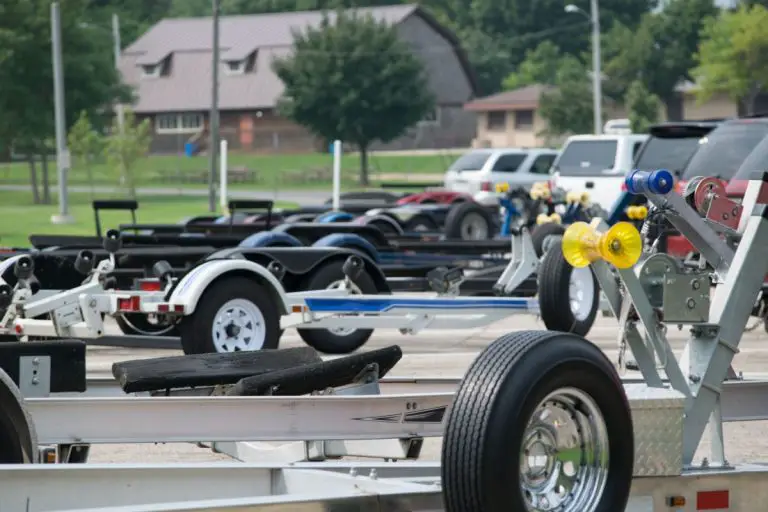
Tips For Building Boat Trailer Bunks With Composite Decking
Nowadays, composite decks are an alternative to wooden decks. They prove to be far more valuable and efficient. One of the growing uses of composite decks is in building boat trailer bunks. So what do you need to know to help you create a boat trailer bunk with composite decks? Let me give you some…
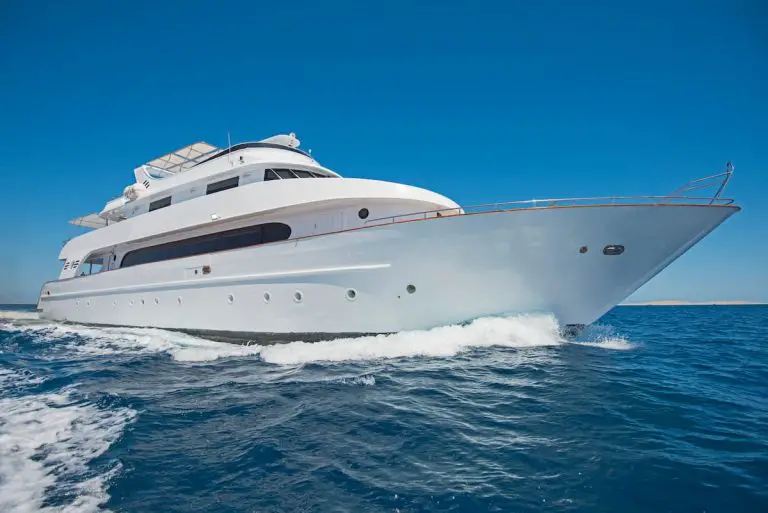
The 12 Safest Types of Boats Revealed (with Examples)
The safety of a boat is tested when it hits rough water. If you can steer it straight without bow steering when you hit the waves, then you can be confident you are using a safe boat. Not all boats come with this capability, so you need to choose one that’s specially designed to withstand…
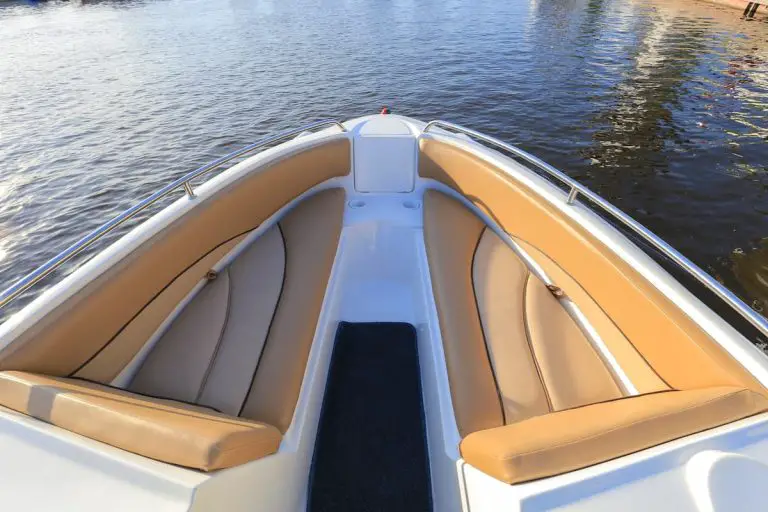
7 Best Products To Protect Vinyl Boat Seats
Vinyl boat seats get exposed to UV damage and are prone to mold, mildew, and dirt build-up. So, which are the best products to protect your vinyl boat seats? The best product to protect vinyl boat seats is Meguiar’s M5716SP Vinyl Cleaner. This product is multi-purpose and cleans, protects, and restores vinyl. It doesn’t leave…
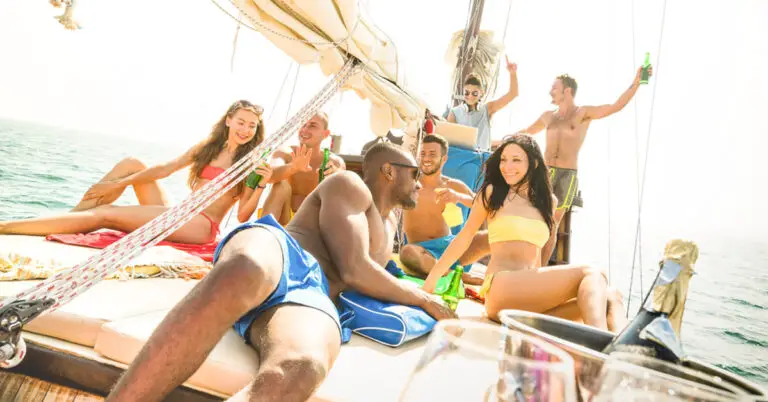
Can You Drink on a Boat If You’re Not Driving? Navigating Alcohol Consumption Laws on Boats
Spending a day on a boat with friends or family can be a fun and relaxing way to enjoy the outdoors. However, if you plan on having a few drinks while on the boat, it’s important to know the laws surrounding alcohol consumption on the water. Many people wonder if they can drink on a…
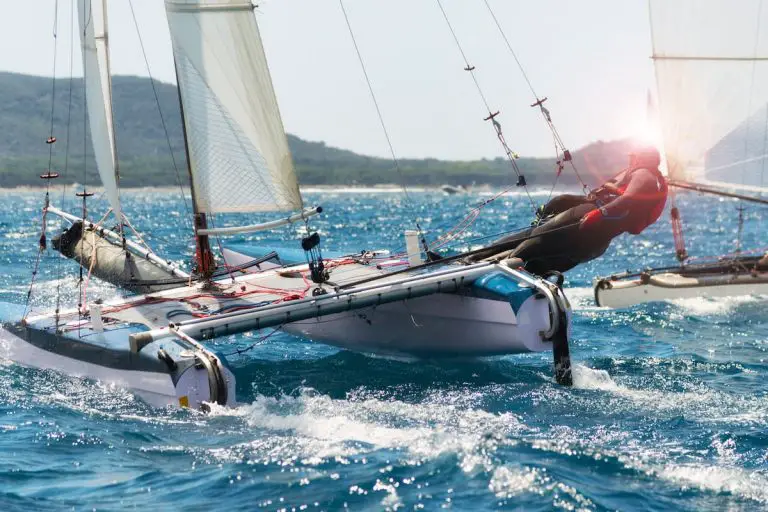
Do Catamarans Flip Over Easily? (5 Things To Know)
Catamarans are popular boats for enjoying a vacation or a day out on the water. If you’re interested in investing in a catamaran, you may be wondering if they flip over easily. Catamarans don’t flip over easily as they have two watertight hulls, are naturally buoyant, and have fast-draining cabins should they become waterlogged. They…
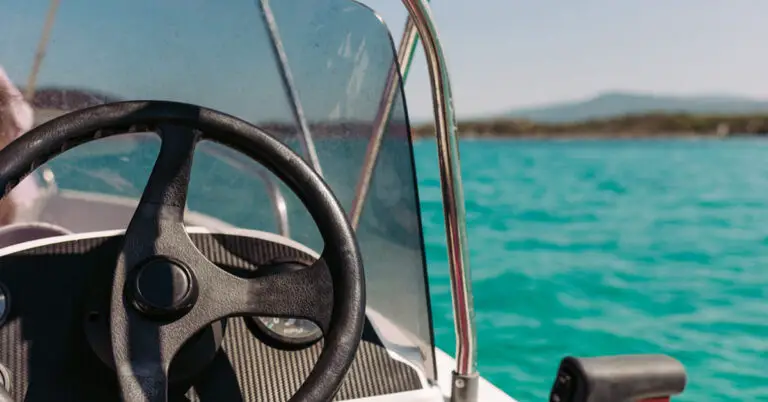
Is It Correct to Say ‘Drive a Boat’ or ‘Sail a Boat’? The Answer Depends on Your Craft
When operating a watercraft, the language used to describe the act can be a source of confusion. Some may say they “drive a boat,” while others say they “sail a boat.” The truth is the correct term to use depends on the type of vessel being operated and the method of propulsion. For larger vessels,…

How to Moor a Boat: A Clear and Confident Guide
Mooring a boat can be a daunting task, especially for new boat owners. However, it is an essential skill that every boat owner must master how to moor a boat and ensure the safety of their vessel.
Mooring involves securing a boat to a fixed structure such as a wharf, buoy, or jetty. It is essential to understand the basics of mooring and the different techniques and types of anchors to use.
Choosing the right mooring spot is crucial to ensure the safety of the boat. Factors such as water depth, wind, and current should be considered when selecting a mooring spot.
Preparing the boat for mooring is also an important step that should not be overlooked. This includes ensuring that all equipment is in good working condition and that all crew members are aware of their roles during the mooring process.
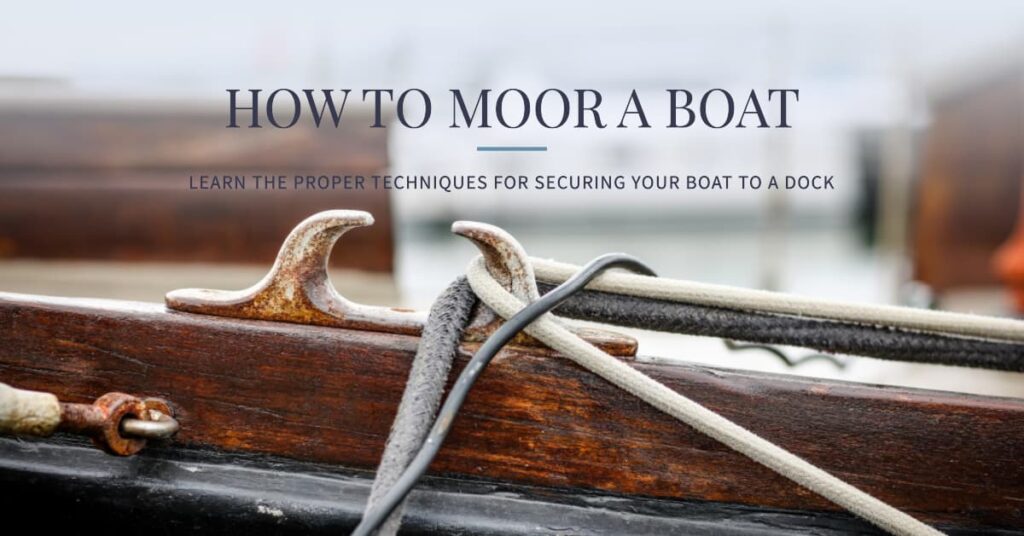
Key Takeaways
- Understanding the basics of mooring is essential for every boat owner.
- Choosing the right mooring spot and preparing the boat for mooring are crucial steps in the process.
- Knowledge of different mooring techniques and types of anchors is necessary for safe and secure boat mooring.
Understanding Mooring Basics
Mooring a boat is the process of securing it to a fixed structure like a dock or a buoy. It is essential to understand the basics of the mooring system to ensure that the boat is safely secured.
Mooring System Components
The mooring system consists of several components that work together to keep the boat in place. Here are the essential components of a mooring system:
Mooring Buoy
A mooring buoy is a floating device that is attached to an anchor on the seabed. It is used to secure the boat to the mooring system. The buoy is usually made of plastic or hard foam and is designed to float on the water’s surface.
Mooring Anchor
The mooring anchor is a heavy weight that is attached to the mooring buoy with a chain. It is designed to hold the buoy and the boat in place. The anchor is usually made of steel and is designed to withstand the forces of the wind and the waves.
Mooring Lines
Mooring lines are ropes that are used to secure the boat to the mooring system. They are attached to the mooring buoy and the boat. The mooring lines should be strong enough to hold the boat in place and should be long enough to allow the boat to move with the tide.
Chains are used to connect the mooring buoy to the mooring anchor. They are designed to withstand the forces of the wind and the waves and are usually made of steel.
Swivel Shackle
A swivel shackle is a device that is used to connect the mooring lines to the mooring buoy and the boat. It is designed to rotate and prevent the mooring lines from getting twisted.
Mooring Pennant
A mooring pennant is a rope that is used to connect the mooring buoy to the mooring lines. It is designed to absorb the shock of the waves and prevent the mooring lines from getting damaged.
Chafe-Resistant Coating
A chafe-resistant coating is a protective layer that is applied to the mooring lines to prevent them from getting damaged by rubbing against the mooring buoy or the boat.
Understanding the components of the mooring system is essential to ensure that the boat is safely secured. It is important to inspect the mooring system regularly to ensure that all the components are in good condition and are working properly.
Choosing the Right Mooring Spot
Mooring a boat is a crucial skill for any boater. It involves securing your boat to a fixed object, such as a buoy, dock, or pier, to prevent it from drifting away. However, choosing the right mooring spot can be challenging, especially for novice boaters. In this section, we’ll discuss the factors to consider when choosing a mooring spot.
Factors to Consider
When choosing a mooring spot, several factors should be considered to ensure the safety of your boat and everyone on board. These factors include:
The location of the mooring spot is critical. It should be in a sheltered area that offers protection from strong winds, waves, and currents. A protected harbor, bay, or lake is an ideal location for mooring. In addition, the depth of the water should be sufficient to prevent the boat from hitting the bottom during low tide.
Infrastructure
The infrastructure of the mooring spot is also essential. The availability of docks, piers, and jetties can make it easier to secure your boat. A well-maintained marina with ample facilities can offer a more comfortable and convenient mooring experience.
Accessibility
The accessibility of the mooring spot is another critical factor. It should be easy to access, especially during high traffic periods. A mooring spot that is too far from shore or requires a long walk to reach can be inconvenient and time-consuming.
Other Boats
The presence of other boats in the area should also be considered. A crowded mooring spot can make it difficult to maneuver your boat and secure it properly. It’s best to choose a mooring spot that offers ample space and is not too close to other boats.
Regulations
Lastly, it’s important to consider any regulations that may apply to the mooring spot. Some areas may have restrictions on the size and type of boats that can be moored. It’s essential to check with local authorities to ensure that you are complying with all regulations.
In conclusion, choosing the right mooring spot is critical to ensure the safety of your boat and everyone on board. By considering factors such as location, infrastructure, accessibility, other boats, and regulations, you can find the ideal mooring spot for your needs.
Preparing Your Boat for Mooring
Before mooring a boat, it is important to prepare the boat to ensure safe and secure docking. This section will cover the three essential sub-sections for preparing a boat for mooring: Checking the Weather, Securing the Gear, and Setting the Fenders.
Checking the Weather
One of the first things to do before mooring a boat is to check the weather conditions. The weather can affect the safety of the boat and the mooring process. Boaters should check the wind, waves, tides, and any approaching storms or inclement weather. The National Oceanic and Atmospheric Administration (NOAA) provides weather forecasts for boaters on its website.
Securing the Gear
Securing the gear on the boat is crucial before mooring. All loose equipment, such as chairs, fishing gear, and coolers, should be stowed away to prevent them from falling overboard or damaging the boat. The boat’s lines and bumpers should also be prepared and ready for use.
Boaters should check that the lines are strong enough to withstand the wind and waves and that the bumpers are properly inflated and positioned to protect the boat.
Setting the Fenders
Boat fenders or bumpers are used to protect the boat from damage while mooring. Boaters should set the fenders in the correct position before approaching the dock or buoy.
The fenders should be placed on the side of the boat that will be facing the dock or buoy. The number of fenders used will depend on the size of the boat and the mooring location. Boaters should also ensure that the fenders are properly secured and positioned to avoid any damage to the boat. Follow the link to read more about boat fenders or bumpers .
By following these three essential steps, boaters can prepare their boats for mooring and ensure safe and secure docking.
Mooring Techniques
Mooring a boat can be a challenging task, but with practice and the right technique, it can be done safely and efficiently. This section will cover the essential steps for mooring a boat, including approaching the mooring spot, securing the boat, and leaving the mooring spot.
Approaching the Mooring Spot
When approaching the mooring spot, it’s important to do so at a slow and steady speed to avoid damaging the boat or the mooring. The crew should be ready to secure the boat with lines as soon as it comes to a stop.
To approach the mooring spot, the boat should be put in neutral, and the engine should be idling. The boat should then be maneuvered into position using the bow and stern lines.
Securing the Boat
Once the boat is in position, it’s time to secure it to the mooring. The crew should use bow, stern, and spring lines to keep the boat in place.
The bow line should be secured to the mooring first, followed by the stern line. The spring lines should be secured last, and they should be used to prevent the boat from moving forward or backward.
To secure the lines, the crew should use a cleat hitch. This knot is easy to tie and untie and provides a secure hold on the line.
Leaving the Mooring Spot
When leaving the mooring spot, it’s important to do so slowly and carefully. The crew should untie the lines in the reverse order that they were secured, starting with the spring lines, followed by the stern line, and then the bow line.
The boat should be put in reverse, and the engine should be idling. The boat should then be maneuvered away from the mooring spot using the bow and stern lines.
In conclusion, mooring a boat requires practice and the right technique. By approaching the mooring spot at a slow and steady speed, securing the boat with the right lines and knots, and leaving the mooring spot carefully, boaters can ensure a safe and efficient mooring experience.
Types of Anchors and Their Uses
When it comes to anchoring a boat, choosing the right anchor for the specific conditions is essential. There are several types of anchors available, each with its own set of advantages and disadvantages. In this section, we will discuss the most common types of anchors and their uses.
Choosing the Right Anchor
When choosing an anchor, it is important to consider the type of boat, the size and weight of the boat, and the conditions in which it will be anchored. The most common types of anchors include fluke anchors, plow-style anchors, mushroom anchors, navy anchors, and helical anchors.
Fluke Anchor
The most common type of anchor is the fluke anchor , also known as the Danforth anchor or lightweight anchor. Fluke anchors have wide, flat flukes that allow them to hold fast in a variety of bottom types, including sand and mud. They are lightweight and easy to handle, making them popular among boaters.
Plow-Style Anchors
Plow-style anchors are designed to dig into the bottom and hold fast in a variety of conditions, including grass, rock, and coral. They are ideal for larger boats and can provide excellent holding power in strong currents.
Mushroom Anchors
Mushroom anchors are designed to sink into the bottom and provide a large surface area to hold the boat. They are ideal for soft bottoms, such as mud or sand, and are often used for mooring.
Navy Anchors
Navy anchors, also known as stockless anchors, are designed for larger boats and ships. They are heavy and provide excellent holding power in strong currents and rough conditions.
Helical Anchors
Helical anchors are screw-like anchors that are driven into the bottom with a motor. They are ideal for soft bottoms, such as mud or sand, and can provide excellent holding power in a variety of conditions.
In addition to choosing the right type of anchor, it is also important to consider the weight and material of the anchor. A heavier anchor will provide better holding power, while a lighter anchor will be easier to handle. Galvanized chain and double-braid polyester rope are popular choices for anchor rode, as they are strong and durable.
Overall, choosing the right anchor for the specific conditions is essential for safe and secure mooring. Boaters should always consult the manufacturer’s recommendations and be prepared to adjust their anchoring strategy as conditions change.
Safety Measures and Precautions
When it comes to mooring a boat, safety should always be the top priority. There are various risks and potential damages that can occur during the process, so taking the necessary precautions is crucial. Below are some safety measures that should be taken into account:

Dealing with Rocky Bottoms
One of the risks that can occur during mooring is dealing with rocky bottoms. When the bottom is rocky, it can damage the gelcoat of the boat and cause other potential risks. To avoid this, boaters should use a mooring buoy or anchor in a sandy area. If there is no other option but to moor in a rocky area, boaters should use a heavy-duty anchor and ensure that it is set securely.
Night Mooring
Mooring at night can be challenging, especially if the boater is not familiar with the area. To avoid potential risks, boaters should use navigation lights and be aware of any currents or obstacles that may be present. It is also recommended to moor at a safe distance from other boats to avoid any potential damage.
Overall, taking the necessary safety measures and precautions when mooring a boat is essential to avoid any potential risks or damages. Boaters should always be knowledgeable and confident in their abilities to ensure a safe and successful mooring experience.
Cost Considerations
When it comes to mooring a boat, there are several cost considerations that boat owners should keep in mind. The cost of mooring a boat can vary significantly depending on a number of factors, including the size of the boat, the location of the mooring, and the type of mooring equipment that is used.
One of the primary cost considerations for boat owners is the cost of the mooring equipment itself. Depending on the size of the boat, the type of mooring equipment that is required can vary significantly.
For smaller boats, a simple anchor or mooring buoy may be sufficient, while larger boats may require more complex mooring systems that include multiple anchors and chains. The cost of this equipment can range from a few hundred dollars to several thousand dollars, depending on the size and complexity of the system.
In addition to the cost of the mooring equipment, boat owners should also consider the ongoing cost of maintaining and replacing this equipment. Over time, mooring equipment can become damaged or worn, and it may need to be replaced in order to ensure the safety of the boat. Boat owners should factor in these ongoing maintenance costs when considering the overall cost of mooring their boat.
Another cost consideration for boat owners is the cost of the mooring location itself. Depending on the location, mooring fees can vary significantly.
For example, mooring in a popular marina in a major city can be significantly more expensive than mooring in a small, quiet harbor in a rural area. Boat owners should research the cost of mooring in different locations and factor this into their overall budget.
Overall, the cost of mooring a boat can be significant, particularly for larger boats or for those mooring in popular locations. However, by carefully considering the cost of mooring equipment and location, boat owners can make informed decisions about how to best moor their boat while staying within their budget.
Frequently Asked Questions
What is the best way to moor a boat.
The best way to moor a boat depends on the specific conditions and the type of boat being moored. However, some general tips for safe and effective mooring include choosing a sheltered spot, using appropriate mooring lines and fenders, and ensuring the boat is secured to the mooring point in a way that allows for changes in tide and weather conditions.
What are the 3 methods of mooring?
The three main methods of mooring a boat are anchoring, tying to a dock or pier, and using a mooring buoy. Anchoring involves dropping an anchor to the seabed and securing the boat to it with a line. Tying to a dock or pier involves securing the boat to a fixed structure using mooring lines. Using a mooring buoy involves attaching the boat to a buoy that is anchored to the seabed.
How to make a boat mooring?
To make a boat mooring, one needs to choose a suitable location and anchor point, and then install a mooring buoy, anchor, or dock cleat. The mooring point should be strong enough to hold the weight of the boat and withstand changes in tide and weather conditions. It is also important to use appropriate mooring lines and fenders to protect the boat and ensure it is secured safely.
What is the difference between a marina and a mooring?
A marina is a facility that provides docking, storage, and other services to boat owners, while a mooring is a single point to which a boat can be secured. Marinas typically offer more amenities, such as fuel, electricity, and water hookups, while moorings are often simpler and less expensive. However, mooring may be more suitable for boats that are not used frequently or are only used seasonally.
How to moor a boat to a buoy?
To moor a boat to a buoy, one needs to approach the buoy slowly and carefully, taking into account wind and current conditions. Once the boat is in position, attach a mooring line to the buoy using a bowline knot or similar secure knot. The line should be long enough to allow for changes in tide and weather conditions but not so long that it drags on the seabed.
How to moor a boat to a dock?
To moor a boat to a dock, one needs to approach the dock slowly and carefully, taking into account wind and current conditions. Once the boat is in position, secure it to the dock using appropriate mooring lines and fenders. The lines should be tied securely to dock cleats or bollards and should be long enough to allow for changes in tide and weather conditions.
- Recent Posts
- Responsibilities of a Fourth Engineer on Cargo Ships – September 10, 2024
- The Role of Cargo Ships in Global Trade – August 22, 2024
- Report: Yang Ming’s YM Mobility Explosion at Ningbo-Zhoushan Port – August 9, 2024
Latest posts
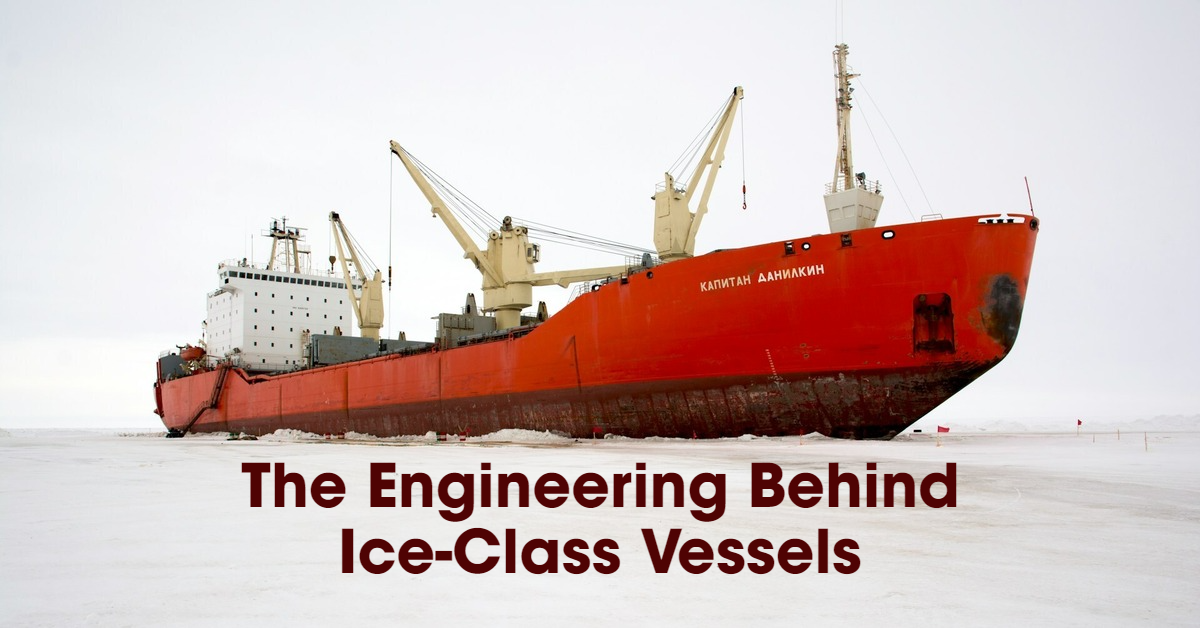
The Engineering Behind Ice-Class Vessels
Contents show What Does Ice-Class Mean? Categorization of Ice-Class Ships Ice-Class 1A Ice-Class 1B Ice-Class 1C What Are Ice-Class Vessels Made Of? The Design of Ice-Class Vessels Other Additions to […]

Is Maritime Security Necessary on Modern Ships?
It’s vital for ships to stay vigilant. Isolation from land means having no backup or protection for miles, making them vulnerable to attacks and other threats. Equip modern ships using modern maritime security methods.
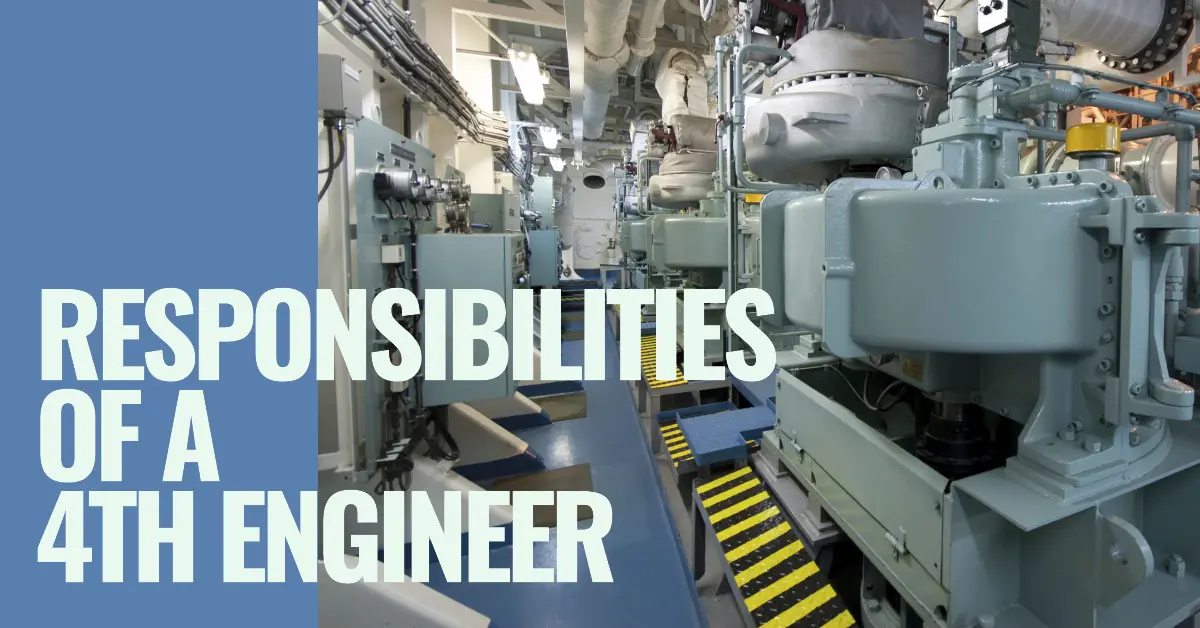
Responsibilities of a Fourth Engineer on Cargo Ships
A Fourth Engineer on cargo ships oversees engine room operations, machinery maintenance, and ensures compliance with regulations like MARPOL.
Did You Know That We Offer Contract to Closing Services? Click Here to Find Out More.
Need Marine Financing? Apply Here With Our Partner, First Approval Source
- Catamaran Interviews
- Catamaran Reviews
- Buying Advice
- Selling Advice
- Woods Design Advice
- Admiral 38
- Admiral 40
- Admiral 50
- Americat 3014
- Antares 44
- Aquila 44
- Aquila 48 Power Catamaran
- Aventura 37
- Balance 442
- Balance 482
- Balance 526
- Bali 4.0
- Bali 4.1
- Bali 4.2
- Bali 4.3
- Bali 4.4
- Bali 4.5
- Bali 4.6
- Bali 4.8
- Bali 40 Catspace
- Bali 5.4
- Bali Catsmart
- Beneteau Blue II
- Broadblue 346
- Broadblue 38 Prestige
- Broadblue 385
- Broadblue 435
- Broadblue 46
- Rapier 400
- Rapier 550
- Catalac 10M
- Catalac 11M
- Catalac 12M
- Catalac 8M
- Catalac 900
- Catalac 9M
- Catana 381
- Catana 39
- Catana 401
- Catana 40S
- Catana 411
- Catana 42
- Catana 42 S
- Catana 431
- Catana 44
- Catana 471
- Catana 50
- Catana 521
- Catana 531
- Catana 55
- Catana 581
- Catana 65
- Catathai 44
- Chris White
- Chris White 48 Voyager
- Chris White 55
- Condor 40
- Contour 34
- Corsair F28 R
- De Villiers
- Dean 365
- Dean 400
- Dean 440
- Dean 500
- Dix DH550
- Dolphin 380
- Dolphin 460
- Edel 35
- Endeavour 30
- Endeavour 35 Victory
- Endeavour 36
- Endeavour 44
- Endeavour 44 TrawlerCat
- Endeavour 50 Pilothouse Trawler
- Excess 11
- Excess 15
- F-41
- Fastback 43
- Fastcat 445
- Fisher 28
- Fisher 32
- Fortuna 36 Island Spirit
- Fortuna 401 Island Spirit
- Fountaine Pajot
- FP 32 Maldives
- FP 35 Tobago
- FP 36 Mahe
- FP 37 Antigua
- FP 38 Athena
- FP 39 Fidji
- FP 40 Isla
- FP 40 Lavezzi
- FP 40 Lucia
- FP 40 MY
- FP 40 Summerland MY
- FP 41 Lipari
- FP 42 Astrea
- FP 42 Venezia
- FP 43 Belize
- FP 44 Helia
- FP 44 Orana
- FP 45 Elba
- FP 46 Bahia
- FP 46 Casamance
- FP 48 Salina
- FP 50 Saba
- FP 56 Marquises
- FP 57 Sanya
- FP 58 Ipanema
- FP 60 Eleuthera
- FP Saona 47
- Fusion 40
- Gemini 105
- Gemini 3000
- Gemini 3200
- Gemini 3400
- Gemini Freestyle 37
- Gemini Freestyle 399 Power
- Gemini Legacy 35
- Grainger 420 Mystery Cove
- Gunboat 55
- Hirondelle 7M
- HopYacht 30
- Island Packet
- Island Packet Cat 35
- Kennex 420
- Knysna 440
- Knysna 480
- Knysna 500
- Knysna 550
- Lagoon 35
- Lagoon 37 TPI
- Lagoon 380
- Lagoon 39
- Lagoon 40
- Lagoon 400
- Lagoon 410
- Lagoon 42
- Lagoon 42 TPI
- Lagoon 420
- Lagoon 421
- Lagoon 43 PC
- Lagoon 44 Power Cat
- Lagoon 440
- Lagoon 450
- Lagoon 46
- Lagoon 470
- Lagoon 50
- Lagoon 500
- Lagoon 52F
- Lagoon 55
- Lagoon 560
- Lagoon 570
- Lagoon 620
- Lagoon Seventy 8
- Lagoon Sixty 7
- Leeuwin 42
- Leopard 38
- Leopard 39
- Leopard 39 PowerCat
- Leopard 40
- Leopard 42
- Leopard 43
- Leopard 44
- Leopard 45
- Leopard 45 Classic
- Leopard 46
- Leopard 46 Lion PowerCat
- Leopard 47
- Leopard 47 PowerCat
- Leopard 48
- Leopard 50
- Leopard 51 PowerCat
- Leopard 53 PowerCat
- Leopard 58
- Lidgard 73 Executive
- Looping 50
- Maine Cat 30
- Maine Cat 38
- Maine Cat 41
- Manta 40
- Manta 42
- Matrix 450 Vision
- Matrix 760 Silhouette
- Maverick 400
- Maverick 420
- Maverick 440
- Moxie 61
- Nautitech 40
- Nautitech 40 Open
- Nautitech 44 Open
- Nautitech 442
- Nautitech 46 Open
- Nautitech 47
- Nautitech 47 Power
- Nautitech 475
- Nautitech 65
- Neel 45
- Neel 47
- Outremer 40
- Outremer 45
- Outremer 50 Standard
- Outremer 55
- Outremer 5X
- PDQ 32
- PDQ 36
- PDQ 42 Antares
- Privilege 37
- Privilege 39
- Privilege 42
- Privilege 43
- Privilege 435
- Privilege 45
- Privilege 465
- Privilege 48 Transcat
- Privilege 482
- Privilege 495
- Privilege 510
- Privilege 65
- Privilege Serie 5
- Prout 31 Quest
- Prout 33 Quest
- Prout 34 Event
- Prout 35 Snowgoose
- Prout 37 Snowgoose
- Prout 37 Snowgoose Elite
- Prout 38
- Prout 38 Manta
- Prout 39 Escale
- Prout 45
- Prout 46
- Royal Cape 45
- Royal Cape 500 Majestic
- Royal Cape 530 Majestic
- Sailcraft 30 Iroquois
- Sailcraft 32 Comanche
- Sailcraft 35 Cherokee
- Sailcraft 41 Apache
- Sailcraft 44 Apache
- Scape 39
- Wildcat 350
- Seacart 30
- Seawind 1000
- Seawind 1160
- Seawind 1190
- Seawind 1200
- Seawind 1260
- Seawind 1600
- Simpson 48
- Solaris 36 Sunrise
- Solaris 36 Sunstar
- Solaris 42
- St Francis 44
- St Francis 48
- St Francis 50
- Stealth 11.8
- Sunreef 60
- Sunreef 62
- Sunreef 70
- Sunreef 74C
- Sunreef 82 DD
- Sunreef 88 DD
- Switch 51
- Switch 55
- TRT 1200
- Heavenly Twins 26
- Ocean Twins 38
- Vaan R5
- Vision 444
- Voyage 380 Maxim
- Voyage 400 Norseman
- Voyage 430 Norseman
- Voyage 440
- Voyage 450 Cabriolet
- Voyage 47 Mayotte
- Voyage 480
- Voyage 500
- Voyage 580
- Voyage 590
- Kronos 45
- Wharram 38 Tiki
- AMI 320 Renaissance
- Woods 22 Wizard
- Woods 35 Banshee
- Woods 35 Flica
- Woods 36 Scylla
- Woods 36 Vardo
- Woods 38 Transit
- Woods 40 Meander
- Xquisite X5
- Xquisite X5+
How much does it cost to dock a catamaran?
- Post author By Patrick Davin
- Post date October 12, 2020
- 1 Comment on How much does it cost to dock a catamaran?

A big consideration when purchasing a catamaran is how much it will cost to moor or dock it. The cost to dock a catamaran will usually be higher than a monohull since their greater beam means they take up a lot more room than a monohull. The cost of moorage can vary greatly between different areas of the world however. Rates can also vary depending on the season (winter vs summer) if peak season is much more popular than the off-season.
Besides just the cost, the availability of moorage in your desired area is something to consider as well. Since most marinas are designed primarily with monohulls in mind, they may not have much room available for catamarans. In some places, marina moorage is in such high demand that there are waiting lists to get in.
If you’re looking for transient (nightly) moorage while out cruising, it will likely be easier to find that than permanent moorage. However not all marinas can accommodate large catamarans, so your options for transient moorage may be slightly less than that of a monohull.
Types of Moorage: Marinas, Private Docks, Mooring Balls
Marinas are the most common form of moorage, and also the most expensive – though the cost can vary wildly depending on location within the US or internationally. Marinas are often the easiest to find, having a large presence in boating guide books and apps – as well as having their own website, typically, where they list their rates, amenities and policies. In Fort Lauderdale, Florida, marina rates for a 45’ catamaran can be in the $1600 to $2000 range. In a more rural area such as Fort Pierce, Florida lower rates between $1200 to $1600 can be found.
Private slips can be rented directly from owners of a slip or association, and are generally less expensive than a marina – while possibly providing fewer amenities like showers, restrooms, laundry and marina staff. Private docks in Fort Lauderdale for a 45’ catamaran will typically run $800 to $1000. In Fort Pierce the rates are more likely $600 to $800.
Mooring balls are typically the lowest cost option – in the ballpark of $200 to $300 per month. A mooring ball with adequate swing room can usually fit a monohull, catamaran or powerboat equally well, so the cost is equivalent. They provide less convenience however, as you’ll have to dinghy out to the boat with supplies and provisions. It’s also important to make sure you have a very secure, chafe-free connection to the mooring ball, since it’s the only point securing your boat from being driven aground in a storm. There is a large inexpensive mooring field in Riviera Beach, Florida off Rybovich for example that has many catamarans.
Marina Cost: Generally 2x Monohull Cost
The cost to dock a catamaran in a marina will usually be about twice the cost of a comparable length monohull, since the catamaran’s larger beam will generally take up two slips. However, in marinas that have end ties available for catamarans, those docks will usually be only 25-50% more than a standard slip. End ties are the outer end of a pier and allow large boats to avoid having to take up two slips – however, there are only so many of these spaces available and often they will be allocated already.
Smaller catamarans like a PDQ 36 or Gemini 105 with a relatively narrow beam may be able to fit into a standard slip and pay the same price as a monohull. Marina costs and configurations can vary a lot from one area to the other, or even within the same area, so it pays to look at several options.
Moorage Costs By Region
Costs will vary a great deal throughout the world, but there are a few ballpark guidelines for areas that are known for being more expensive or less expensive. Within the US, popular boating areas such as Florida, the Chesapeake Bay, Pacific Northwest and California will generally be more expensive than other areas such as Texas and the Great Lakes. Even so, within the more expensive areas it’s usually possible to find cheaper moorage by traveling to a less popular area.
In the Caribbean, many of the options will be mooring ball fields rather than marinas. There are marinas as well, though much of the Caribbean is in hurricane zones so special care must be taken during hurricane season. Anchoring of course, is always a popular and free option.
In the Mediterranean, med moorings are common with an anchor or mooring ball for the bow and the stern backed up to a wall or walkway. In the Med, moorage prices can be very expensive since this is a popular boating area and moorage is limited. Greece is known to have lower costs than most other countries in the Med.
Availability of dockage
In some areas, finding permanent moorage for a catamaran can be very challenging. Areas such as California or the Pacific Northwest often have marinas near 100% capacity and years-long waiting lists. When the wait for a monohull slip can be that long, having the additional constraints of a catamaran’s beam requirements can make the wait even longer.
For this reason it’s often advisable to secure permanent moorage before purchasing a catamaran. In other areas, where catamarans are very common, finding moorage may not be as difficult.
Private docks or mooring balls may be advertised through Craigslist or Facebook Marketplace, as well as word-of-mouth. Since fewer boat owners search for and reach out to private moorage owners, sometimes you can get lucky with finding a well-priced opportunity at the right time.
The cost to dock a catamaran will generally be higher than a monohull, but it’s possible to find better deals if you’re flexible in considering multiple locations and options. If you plan to go cruising long-term, then setting out as soon as possible (and doing a good deal of anchoring) may be the most economical option – but it’s good to have a plan for mooring the boat while you’re preparing to set off cruising.
- Tags Buying Advice

By Patrick Davin
Patrick is a full-time cruiser in the Pacific Northwest, sailing the waters from Seattle to Alaska.
1 reply on “How much does it cost to dock a catamaran?”
Thanks for discussing what would be the expenses to dock a catamaran, especially how you can adjust it to work within your budget depending on the location and material options. It would also be nice to know what would be the dock supplies needed. I hope a good contractor can work within my budget for this project.
Leave a Reply Cancel reply
Your email address will not be published. Required fields are marked *
Save my name, email, and website in this browser for the next time I comment.
- Mastering the Art of Boat Mooring: A Comprehensive Guide
Navigating the open waters demands more than just the thrill of the journey; it requires the mastery of a fundamental skill—boat mooring . Whether you find yourself at the helm of a sleek yacht, a versatile pontoon boat, or any other watercraft, the art of securing your vessel isn't just about tying knots; it's about ensuring safety and cultivating peace of mind amidst the undulating waves. This comprehensive guide invites you on a journey to explore the intricate facets of boat mooring, encompassing the foundational basics to advanced techniques that elevate your maritime competence. Join us as we unveil the secrets to a secure and confident mooring experience, regardless of your seafaring expertise.
Understanding the Basics
A process that goes beyond a simple act of tying knots , mooring is the art of securing a boat firmly to a fixed structure, a vital maneuver preventing the vessel from untethered drifts and unwarranted movements. Whether it's a mooring buoy bobbing in open waters, a stable pontoon awaiting a boat's embrace, or the reassuring solidity of a dock, each scenario demands a nuanced approach. Before setting sail into the realm of advanced techniques, it is paramount to grasp the foundational basics of mooring. In this section, we embark on a journey to unravel the essence of boat mooring, where every knot and every connection is a declaration of maritime control and expertise.
Types of Mooring Points
Embarking on a journey across the seas requires more than just a navigational compass—it demands a nuanced understanding of the diverse mooring points that await seafarers. Here, we explore three quintessential mooring points that stand as sentinels against the capricious tides:
Mooring Buoys
In the vast expanse of open waters, mooring buoys emerge as steadfast allies. These floating devices, firmly anchored to the sea floor, beckon boats to secure their mooring lines, offering stability in the midst of the fluid and unpredictable nature of the sea.
Mooring Pontoons
Harboring both convenience and reliability, mooring pontoons present a floating sanctuary for boats. These platforms, seamlessly connected to the shore or anchored to the seabed, serve as stable foundations for mooring endeavors. As vessels approach, pontoons extend a welcoming embrace, facilitating secure connections and ensuring a smooth docking experience.
Dock Cleats
Along bustling docks and harbors, the unsung heroes of mooring are the sturdy dock cleats. These fittings, strategically placed on docks, stand ready to shoulder the responsibility of securing boats. Designed with durability in mind, dock cleats become steadfast partners in the delicate dance between boat and shore, offering a reliable point of connection in the bustling domain of marine activity.
In unraveling the tapestry of mooring points, we discover that each holds a unique role in the maritime narrative, beckoning sailors to navigate their vessels with precision and confidence.
Essential Equipment
Setting sail into the realm of boat mooring necessitates more than just maritime know-how; it demands a keen understanding of the essential equipment that transforms the act into a seamless and secure endeavor. Here, we introduce the trio of indispensable tools that form the backbone of every successful mooring operation:
Mooring Lines
Consider mooring lines as the lifelines connecting your vessel to stability. These robust ropes play a pivotal role in the mooring process, serving as the literal ties that bind your boat to the chosen mooring point—be it a buoy, pontoon, or dock. Crafted from materials designed to withstand the rigors of the sea, mooring lines are the first and last defense against the whims of the waves.
In the intricate ballet of boat mooring, cleats take center stage as the performers facilitating the choreography. These fittings, strategically placed on both boat and dock, serve as anchor points for mooring lines. By providing a secure and reliable grip, cleats transform the potential chaos of unbridled movement into a synchronized dance between vessel and mooring point.
Enter the unsung heroes of boat mooring—the protective guardians known as fenders. As cushions strategically positioned along the sides of the boat, fenders act as a defensive barrier against the potential impact with the mooring structure. By absorbing shock and preventing unsightly dings and scratches, fenders contribute to the longevity and aesthetics of both boat and mooring point.
In the symphony of boat mooring, these essential equipment components harmonize to create a seamless and secure maritime experience. As you embark on your mooring journey, ensure that your arsenal includes these tools, each playing a distinct role in the safety and success of your seafaring endeavors.
Read our top notch articles on topics such as sailing, sailing tips and destinations in our Magazine.
Techniques for Boat Mooring
As the sea beckons and vessels traverse the waterways, the mastery of boat mooring techniques becomes a captain's artistry. Navigating the nuances of securing your vessel is a skill set that goes beyond the horizon. Let's delve into the techniques that elevate mooring from a task to a finely tuned maritime performance:
Approaching the Mooring Point
The prelude to a successful mooring begins with a measured approach. Slow and controlled navigation is the key symphony conductor, allowing the captain to assess the mooring point and make adjustments with precision. As the boat gracefully glides towards its destination, this deliberate approach sets the stage for a seamless mooring experience.
Preparing Mooring Lines
In the overture of boat mooring, the importance of preparation cannot be overstated. Have your mooring lines ready and properly coiled, akin to a musician tuning their instrument before a performance. This ensures efficient deployment and eliminates the risk of tangled lines, enabling a swift and secure connection to the chosen mooring point.
Choosing the Right Knots
The artistry of boat mooring extends to the choice of knots —a sailor's repertoire of secure ties. Learn and master knots such as the cleat hitch and bowline, each serving a specific purpose in the delicate dance between boat and mooring point. The right knot is not just a means of connection; it's a testament to seamanship and expertise.
Accounting for Wind and Current
Nature's interlude in the mooring performance comes in the form of wind and current. A skilled captain understands the environmental factors at play and adjusts their approach accordingly. Accounting for the invisible forces that shape the sea ensures that the mooring process unfolds with grace and control, even in the face of challenging conditions.
In the grand composition of boat mooring, these techniques harmonize to orchestrate a safe, efficient, and controlled connection between vessel and mooring point. As you navigate the waters, let these techniques be your compass, guiding you through the intricate steps of securing your maritime companion.
Mooring Safety Considerations
As the captain orchestrates the mooring ballet, safety takes center stage in this maritime performance. The sea, while enchanting, can be unpredictable, demanding a vigilant conductor. Here are the key safety considerations to ensure a harmonious and secure mooring experience:
Weather Conditions
Nature's temperament plays a pivotal role in the success of any mooring endeavor. Stay attuned to the weather forecast , for winds and storms can transform the serene seascape into a challenging stage. Adjust mooring techniques in anticipation of adverse weather conditions, ensuring that your vessel remains steadfast against the elements.
Checking Equipment
The reliability of your mooring operation hinges on the integrity of your equipment. Regular inspections are the overture to safety. Take the time to meticulously examine and maintain mooring lines, cleats, and other essential gear. A well-maintained ensemble ensures that every element performs its role seamlessly, reducing the risk of unexpected mishaps.
Boat Size and Type
In the maritime symphony, not all vessels dance to the same rhythm. Recognize that different boats have distinct mooring requirements. Adapt your techniques to accommodate the size and type of your vessel. From the nimble sailboat to the majestic yacht, tailor your approach to ensure that your mooring practices are finely tuned to the nuances of your maritime companion.
In the intricate choreography of mooring safety, these considerations form the melody that guides the dance between vessel and mooring point. Prioritize safety, be it in the face of changing weather or the routine check of equipment, and let these considerations be your compass on the journey to secure and confident boat mooring.
Read more useful sailing tips:
Mooring yachts.
Navigating the seas aboard a yacht adds a layer of sophistication to the art of mooring. As larger vessels command the waters, it's crucial to consider special considerations and employ specialized equipment. Delve into the nuances of mooring yachts with these focused insights:
Special Considerations
The grandeur of yachts demands an extra measure of attention to detail during the mooring ballet. Larger vessels, with their increased size and weight, may respond differently to environmental forces. Navigate with heightened awareness, considering factors such as wind, current, and the spatial requirements unique to yachts. A captain's discerning eye and a thorough understanding of the vessel's dynamics are paramount for a graceful mooring performance.
Yacht Lines and Cleats
Yachts, being the crown jewels of the maritime world, require a bespoke ensemble of mooring equipment. Familiarize yourself with yacht lines—robust, purpose-built ropes designed to bear the weight and dimensions of these majestic vessels. Explore the intricacies of yacht cleats, specialized fittings strategically placed to handle the forces exerted by large yachts during mooring. Mastery of yacht-specific lines and cleats is the key to a secure and confident mooring experience for vessels of grand stature.
In the realm of yacht mooring, precision and understanding are the compass points guiding the captain. Embrace the challenge of mooring larger vessels with the grace and finesse befitting their stature, ensuring that every connection to the mooring point is a testament to seamanship and mastery of the seas.
Legal and Environmental Considerations
As stewards of the seas, boat owners and sailors bear the responsibility of preserving the marine environment and adhering to local regulations. In the final act of our mooring guide, let's explore the legal and environmental considerations that underscore the importance of responsible seafaring:
Local Regulations
Before casting off into the waves, familiarize yourself with the maritime laws and mooring regulations governing your area. Different regions may have specific guidelines regarding mooring distances, permitted locations, and time restrictions. Adhering to these regulations not only ensures compliance but also fosters a harmonious coexistence with other seafarers and the coastal community.
Environmental Impact
The footprint left by boat mooring extends beyond the vessel itself. Practice responsible mooring to minimize environmental impact and protect delicate marine ecosystems. Avoid dropping anchor in sensitive areas such as coral reefs or seagrass beds. Opt for designated mooring zones when available, and be mindful of the potential repercussions of careless mooring practices. By embracing eco-friendly mooring, you contribute to the preservation of the diverse and fragile underwater world.
In the vast tapestry of maritime adventures, mastering the art of boat mooring emerges as a beacon of skill and responsibility. This guide, spanning the spectrum from fundamental basics to specialized techniques, equips seafarers with the knowledge to navigate the waters with confidence.
Understanding the nuances of boat mooring, employing the right equipment, and applying proper techniques become not just a skill set but a commitment to safety and environmental stewardship. Whether you're setting sail as a novice or as an experienced captain, may this guide serve as your compass, empowering you to embark on every journey with the assurance that your vessel is securely moored, and your impact on the seas is one of respect and care. Safe travels, and may the seas welcome you with open waves.
So what are you waiting for? Take a look at our range of charter boats and head to some of our favourite sailing destinations .

- October 29, 2022
Everything You Need to Know About Mooring Fees
Are you puzzled about how Mooring fees are calculated? Do you need help unraveling what appears to be a mystery regarding mooring fees? This article is for you. We understand that sometimes boaters get confused when told what to pay for mooring; therefore, in this post, the steps and factors that lead to the pricing will be discussed in clear terms.
You can save the page to return to it later if busy but make sure to read till the end because every section is important.
Are you looking for information about private mooring fees?
Search no more. Corleone Marinas will update you with all the answers you have been looking for about mooring fees.
Corleone Marinas provides various top-quality yacht services to ensure your boating trip is as pleasurable as possible. Our facilities are first-rate, and our dedication to customer service is unparalleled. Visit us now and see why we are Sydney’s most excellent marina.
Corleone Marinas will provide you with Everything you need to make the most of your time on the water.
Book your mooring needs at Corleone Marinas in Sydney Harbour!
Corleone marinas with private mooring licenses.
If you plan to moor your yacht on navigable waters in NSW, you must acquire an annual private mooring license. The rules concerning these licenses can be tasking in several ways, but they must be adhered to. Noncompliance with the requirements may result in the termination of your license, which will not be pleasant.
You may moor your boat at Corleone Marinas while exploring Sydney’s beautiful waterways. Because of our convenient locations, affordable pricing, and round-the-clock security, your visit will be peaceful and pleasurable.
Marina Berths or Mooring Site: What is it?
What exactly is a marina berth.
Marina Berths allow leisure or recreational craft owners to get on and off their vessels. They are frequently designed with modular features to adjust the berth size for different shapes and sizes of recreational vessels.
What exactly is mooring?
Any permanent structure to which a vessel may be fastened is called mooring. Some examples are quays, wharfs, jetties, piers, anchor buoys, and mooring buoys. A ship is moored to prevent it from moving freely on the water.
Find top-quality mooring and marina berth at Corleone Marina.
The Types of Moorings available at NSW
Private moorings.
This type of mooring allows you to anchor your boat in navigable waters as an individual or as a family. Permission to moor privately must be acquired from the landowner or harbor authorities. It is renewed every year. It cannot be transferred. There is no assurance of tenure, and the permit does not constitute a lease of the seabed. The buoy is frequently yellow in color.
Commercial and club moorings
Commercial and club mooring licenses are only provided to businesses that conduct business or provide marine-related services. Commercial moorings are used by businesses such as charter firms for their ships. Boating services can be provided to members of the general public or to a recognized organization, such as a boating club. It is renewed yearly, the same as the private mooring license. Commercial vessels frequently use orange buoys, whereas club vessels use red buoys.
Emergency moorings
It is used in emergencies to retain, store, or keep vessels. To be qualified to moor your boat in an emergency, you must first obtain permission from the appropriate authorities. Blue buoys are used for emergency moorings.
Public or courtesy moorings
This is a temporary mooring, and it is open to the public. The NSW government or the Sydney Harbor Authority is in charge of it. NSW Transport provides free courtesy moorings. This kind enables anybody to temporarily dock boats in popular boating areas. This kind of moorings can be used or occupied without permission; however, an establishment charge may apply. It may also be used by domestic and commercial watercraft; however, it must not be left unattended. Even though it is free, just one vessel may be moored at a courtesy mooring. Pink buoys are used for courtesy or public moorings.
Hybrid environmentally-friendly moorings
This is relatively new and still in the beta phase. It is a type of mooring that is designed to be more environmentally friendly. Currently, four Hybrid-Environmentally Friendly Moorings have been constructed at strategic sites around Shoal Bay. Hopefully, in the future, they’ll be available everywhere.
Services Provided by Corleone Marinas
Corleone Marinas is the most trusted and reliable marina in Sydney. We are a one-stop brand that stays committed to providing the best for every boat owner. Services available at our different marinas include wet berths, moorings, and slipways for boats up to 60 feet deep water.
With our service, your yacht can be moored at any time of the day because we are open every day of the week. If your vessel has any fault that needs professional hands, at our marina, experienced and results-producing shipwrights and mechanics are available on-site just for you.
Other services provided by Corleone Marinas are:
- Managing Berth Rental Services
- Providing quality daily assistance to clients
- Professional consulting and on-site staffing
- Marketing and promotional activities
- Government legislation & Environmental regulations
- Accounting and Reporting
Bring your boat to our marina and enjoy your exploration.
Facts You Should Know About Mooring Fees:
The cost of mooring varies from location to location, and boat mooring rates are determined by the facility, amongst other factors. The prices of these moorings are determined by various charges. Such charges include license fees, mandatory insurance payments, mooring fees, and additional costs. Maintenance and service expenses are also crucial aspects.
Major factors that influence mooring fees
In general, there are several packages to pick from, each of them differing in price. In addition, the length of the boat and the amount of protection demanded by the boat’s owner are factors. A marina with fewer amenities may be less expensive than one with full-service amenities. Insurance costs are included in the fixed cost of moorings. This is necessary to defend against any unforeseeable occurrences.
Mooring fees are also majorly affected by the cost of engine fuel, the facility’s location, size, and ownership status. A high cost of engine fuel implies a rise in cost and vice versa.
Everything you need to know about private mooring license
A yearly private mooring license permits you to anchor your vessel in navigable waterways. A charge is associated with the application, and your request may be placed on a priority waiting list based on availability.
You must meet the following criteria to qualify for a private mooring license.
- You must have a boat.
- Your boat’s registration must be valid
- You must be the registered owner of the boat to be attached to the mooring
Information and documents you must have for a flawless private mooring license registration.
- Valid full proof of identity
- Your bio, including personal and contact details
- The mooring location
- A recent photo of the vessel
- The specifics of your vessel
- Credit card details for payment
What makes Corleone Marinas Sydney worth visiting?
Excellent security: One of the most significant advantages of mooring your boat at Corleone Marina is that we provide impenetrable security, ensuring peace of mind for all boaters. This includes strong and strict security measures such as closed gates, video cameras, and alarm systems to keep boats safe and secure.
Less wear and tear: Another significant benefit of mooring your boat at Corleone Marina is that it can save wear and tear on your vessel by providing better shelter from the weather throughout the fall and winter months. Instead of leaving your boat floating in the sea, anchoring it with us protects the surface and engine components from exposure to severe temperatures, which can reduce performance and cause repair concerns.
Convenience: Our location is conveniently accessible and stress-free. Boat owners will find mooring at Corleone Marina a highly convenient choice. You may access your boat whenever you want while it is moored at our marina. We use cutting-edge technology to make it simple for boat owners to get to their boats and get out on the lake without the effort of loading up a boat, driving it to a ramp, and lowering it into the water before taking it out.
Service: At Corleone Marina, we offer a full range of boating services to ensure that boat owners have all they need to enjoy their time on the water. When you park your boat at our marina, you can be certain that you will have access to all of the services you require at all times, including boat maintenance and repairs.
For longer stays, we provide discounts and rates that are competitive. So why are you still waiting? Visit us right away! We are eager to have you visit Corleone Marinas.
6 Activities You Can Do At Corleone Marinas Sydney
There is always plenty to do at Corleone Marinas, whether you are a seasoned sailor or a first-time visitor.
Here are our top six recommendations for having a wonderful time in Sydney.
- Explore Sydney from the waters by taking a ferry ride around the port.
- Visit the Look Out Cafe and treat yourself to a nice cup of coffee and a sumptuous meal.
- If you want something recreational and relaxing, head to Palm Beach for swimming, surfing, and sunbathing.
- You can treat yourself to a picnic at the Royal National Park, located just south of Sydney.
- The Royal National Park is also a great place to hike; if you are up for it, go there without delay.
- Explore Long Island if you are seeking adventure.
Whatever you want to do, Corleone Marinas is the ideal starting point for your Sydney journey. Visit us right away! We can’t wait to meet you.
Frequently Asked Questions
Q: does fuel price affect mooring.
A: Yes, it does. If it’s low, you’ll be required to pay lesser fees and vice-versa
Q: What is the maximum vessel length allowed at your marina office?
A: The maximum vessel length allowed at our marina office is 15 meters.
Q: When do you close?
A: Corleone Marinas is available every day round the clock. Come anytime, and we will get your vessel safely and securely moored.
Final Thoughts
Mooring fees are not just arrived at by mere head calculations. A variety of factors are involved. Also, all marinas don’t charge the same. Some charge less and provide poor-quality mooring service.
To get the most professional, trusted, and affordable mooring in the whole of Sydney, The Corleone Marinas is your go-to spot. Our service is fast and flawless. With on-site shipwrights and mechanics, you have access to quality repairs and maintenance.
Our marina services include wet berths, moorings, and slipways for yachts up to 60 feet.
Contact us for more information. We will be glad to assist.
Latest Posts

The Ultimate Guide to NSW Boating Rules
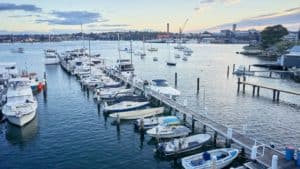
Barbecue On A Boat? Yes, It Can Be Done
Our marinas, elizabeth bay, long island, don’t stop here, more to explore.
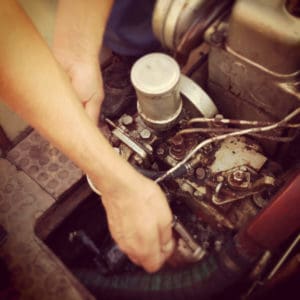
My Boat Engine Won’t Start, What’s The Problem?
Whether you’re out for an afternoon of leisure with family in the marina, or you’re in the great open ocean and ready to head back after a long day, no one wants to turn the ignition key to be met with nothing but a churning noise, or even worse, nothing at all! Here are some
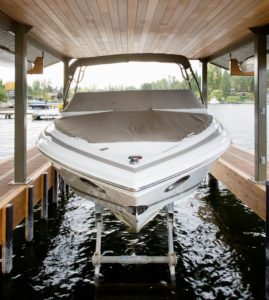
What Exactly Is Deadrise And How Does It Affect My Boat?
In general, most boat hulls are constructed in a V-shape. These angled hulls allow the ship to drop below the surface and cut through water and waves at speed. The sharper the angle, the more a ship can slice through the water and keep the ride buttery smooth. The general idea is that Deadrise is
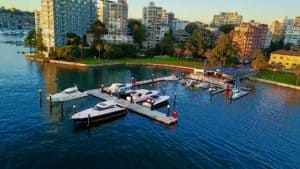
Boat Propellor Maintenance, What you Need to Know
Whether you have a motor yacht or a sailing yacht, you probably have an engine that drives a propellor. You know that your boat and boat engine need regular maintenance, still, many yacht owners and even yacht charterers are unaware of how and why to maintain a propellor. Whether you have an inboard diesel engine
LET'S GET YOU OUT ON THE WATER
Sydney's premium harbour locations.

Corleone Marne Services Acknowledges Aboriginal And Torres Strait Islander Peoples As The Traditional Custodians Of The Land, Rivers And Sea. We Acknowledge And Pay Our Respects To The Elders Past, Present
All of our marinas are a safe spaces free of discrimination or fear; a space, free of bullying and harassment of any kind. we will work together honouring our differences and celebrating our strengths, individual qualities and contributions; upholding the values of trust, respect and confidentiality..
CMS Is Dedicated To Providing A Harassment-Free Environment For All Employees, Regardless Of Gender, Gender Identity And Expression, Sexual Orientation, Intersex Status, Disability, Ethnicity, Or Religion. We Do Not Tolerate Bullying And Harassment In Any Form. We Are Committed To Building A Diverse And Inclusive Workplace. We Pledge To Cultivate A Workplace Culture That Is Safe, Accessible, Fosters Inclusiveness, Promotes Diversity And Celebrates The Unique Skills And Qualities Of All Our Employees.
At Corleone Marinas, We Recognize Our Responsibility To Help Protect The Planet. We Are Committed To Minimizing Our Impact On The Environment And Supporting Those Who Are Working To Improve Global Environmental Sustainability. W-E’re Committed To Reducing The Impact Our Company Has On The Environment. We Care About Sustainability, And Are Continually Working To Improve Our Environmental Performance Through The Introduction And Advancement Of Policies, Procedures, And Work Practices That Allow Us To Deliver A Brilliant Service With Limited Environmental Impact. Introduction And Advancement Of Policies, Procedures, And Work Practices That Allow Us To Deliver A Brilliant Service With Limited Environmental Impact.
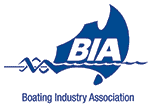
© 2024 Corleone Marinas. All Rights Reserved. Site by Creative Clarity

How Much Does It Cost To Moor a Boat in the Caribbean?
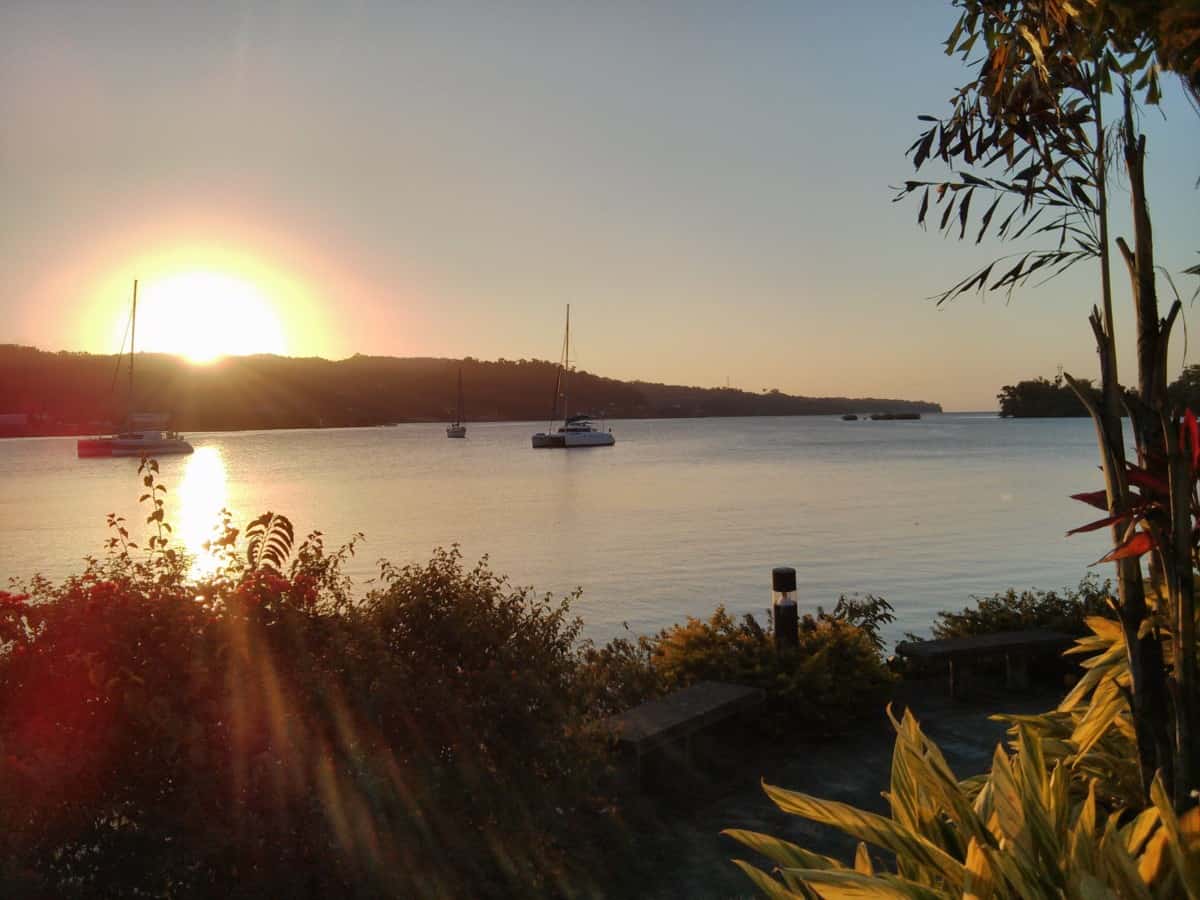
As an Amazon Associate, we earn from qualifying purchases. We may also earn commissions if you purchase products from other retailers after clicking on a link from our site.
Sailing in the Caribbean was one of my best experiences. The weather is usually perfect for sailing, the beaches are beautiful, and the locals are friendly. There are many different islands to visit, each with its own glamor and charm, and mooring a boat there can be a magical experience.
The costs of mooring a boat in the Caribbean vary depending on the island, location, size, and type of boat. The cost ranges from $0.65 to $4 per foot per day. A 40ft boat will cost between $26 and $160 per day and between $780 and $4800 per month without any discounts. On the other hand, anchoring is in most places free of charge.
In this post, I want to give you a taste of what it’s like sailing in the Caribbean. I’ll discuss typical costs associated with mooring sailboats, tips for living on a sailboat, and additional information you should know before you plan your trip.
Table of Contents
Cost To Moor a Boat in the Caribbean
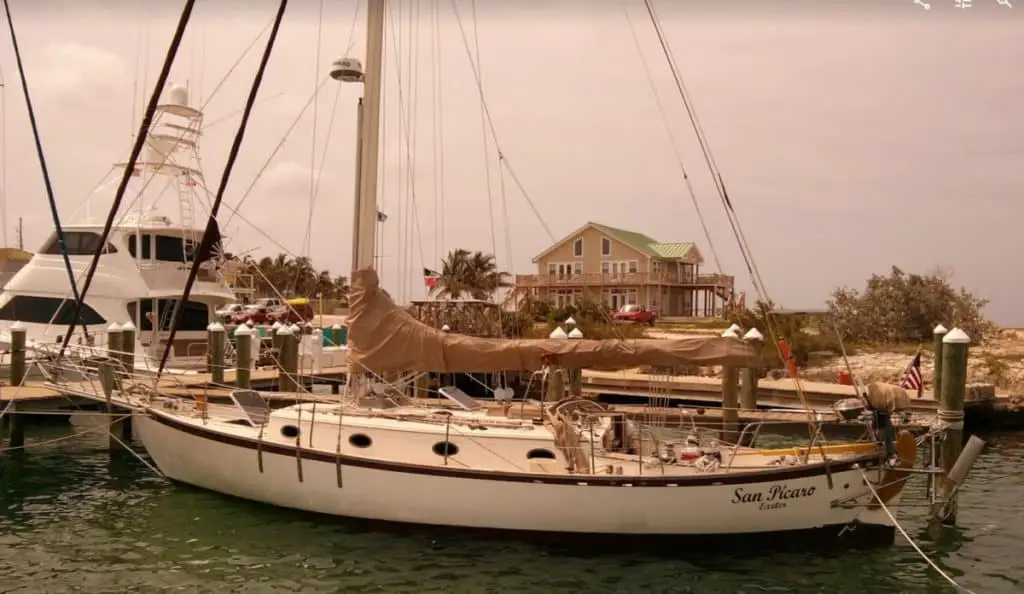
There are several things to consider when budgeting for a boat mooring in the Caribbean. The cost of the mooring itself will be one of your primary expenses, and this vary depending on the location .
The cost of mooring a boat in the Caribbean can end up being relatively expensive, especially when considering other costs such as repair fees and monthly expenses. However, there are a few places that are cheaper than others, so you’ll be sure to find something within your budget.
In addition, you will need to budget for the following:
- Boat insurance
- Dockage fees
It is also essential to consider the time of year that you will be visiting. The high season for boating in the Caribbean is from December to April, and prices will be higher during these months.
Generally speaking, the cost of mooring a boat in the Caribbean ranges from $100 to $300 per day , depending on the location and other factors. Some marinas offer lower rates for longer-term parking, while others charge more for prime locations.
| Antigua Yacht Club Marina, Antigua and Barbuda | $2.00 – $3.50/ft | Hotel Lodging Fuel Provisions Restaurants/Bars WiFi |
| Davis Harbor Marina, Bahamas | $1.90/ft | Fuel Provisions Laundry/Bathhouse WiFi |
| Romero Bay Resort and Marina, Bahamas | $4.00/ft | Hotel Lodging Health Club Fuel Provisions Restaurants/Bars WiFi |
| Bimini Cove Resort and Marina, Bahamas | $2.25/ft | Hotel Lodging Transportation Laundry/Bathhouse Beaches Floating Docks Fuel Provisions Restaurants/Bars WiFi |
| Little Farmer’s Cay Yacht Club and Marina, Bahamas | $2.00 – $3.50/ft | Security Hotel Lodging Transportation Laundry/Bathhouse Beaches Fuel Provisions Restaurants/Bars WiFi |
| Palm Cay Marina, Bahamas | $2.00 – $3.00/ft | Town Nearby Currency Exchange Disability Access Hotel Lodging Transportation Rental Laundry/Bathhouse Beaches Fuel Provisions Restaurants/Bars WiFi |
| LightHouse Marina – BVI, British Virgin Islands | $1.50 – $2.50/ft | Restrooms Fuel Provisions Restaurants/Bars WiFi |
| Nassau Yacht Haven, Bahamas | $2.50/ft | Town Nearby Medical Facilities Hotel Lodging Fuel Provisions Restaurants/Bars WiFi |
| Marina Puerto Bahia, Dominican Republic | $1.25 – $1.75/ft | Town Nearby Currency Exchange Disability Access Hotel Lodging Transportation Rental Laundry/Bathhouse Beaches Fuel Provisions Restaurants/Bars WiFi |
| Inner Harbor Marina, British Virgin Islands | $1.50/ft | Town Nearby Boat Service Hotel Lodging Fuel Provisions Restaurants/Bars WiFi |
| K11 Private Dock – La Marina – Casa de Campo, Dominican Republic | $225 per night (fixed price) | Town Nearby Security Medical Facilities Beaches Restaurants/Bars |
| Bahamas Private Boat Slip, Bahamas | $4.00/ft | Town Nearby Hotel Lodging Disability Access Security Medical Facilities Beaches Restaurants/Bars |
| Antigua Slipway, Antigua | $0.65/ft | Shuttle to beach bar Low cost contractors |
What Size Should a Boat Be When Sailing in the Caribbean?
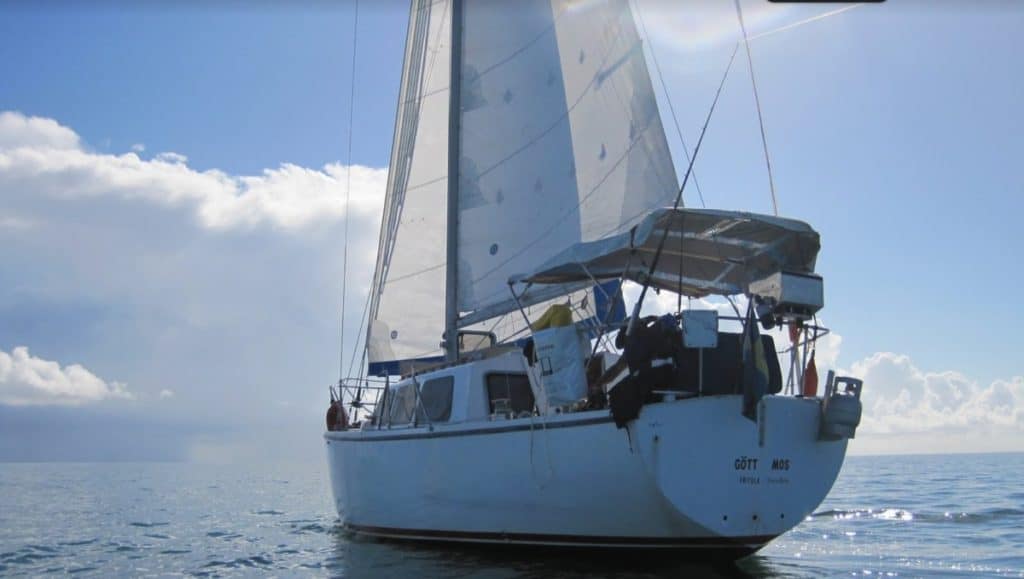
For sailing the Caribbean you need a boat that is 35 – 45ft in length. Due to the close proximity between safe harbors, the main reason to get a bigger boat would be for the comfort of the crew. 35 -45ft is enough to handle the seas, bring adequate supplies and be reasonably comfortable.
Of course, you can travel the Caribbean on something way smaller, there are even people who go from Miami to bimini by Hobie cats that are 16ft long. this is nothing that I recommend, but it is possible. on the other hand, if you are looking for a pleasant experience 35-45ft will do the trick.
The size of your boat also depends on your budget and how much experience you have sailing . If you’re a beginner, it might be a good idea to start out with a smaller boat and once you gain enough experience you can transition beyond the 45ft.
In general, most sailors would agree that a bigger boat is not always better. In fact, a smaller boat can often be more maneuverable and provide a more intimate sailing experience. It’s also important to remember that the Caribbean is a vast area with a variety of different sailing conditions so a small boat with a small draft can be very beneficial in some areas.
How Much Does It Cost To Live on a Sailboat in the Caribbean?
It costs between $600 and $2000 to live on a sailboat in the Caribbean, depending on the boat and its location.
The cost of living on a sailboat in the Caribbean varies depending on the size and type of boat, the location, and the monthly expenses of the person sailing it.
Additional costs due to the following can quickly rack up, costing a few thousand bucks.
- Ship maintenance
- Other provisions
To fully understand how much it costs to maintain and live on a boat, I suggest you read one of these posts:
- How much does it cost to maintain a boat?
- Catamaran insurance costs with real numbers
- The cost of chartering a catamaran
Things You Should Know About Sailing in the Caribbean

The Caribbean is a popular sailing destination, and for a good reason. The waters are calm, and the scenery is beautiful. However, there are a few things you need to know before you set sail in the Caribbean.
- Risk of hurricanes. The hurricane season runs from June to November, and it’s essential to keep an eye on the weather forecast during that time. If a storm is headed your way, you need to be prepared to evacuate.
- Risk of piracy. There have been several cases of piracy in the Caribbean. Theft is also a problem in some areas, so it’s essential to be aware of the dangers and take precautions. Thieves often target boats that are moored or anchored in harbors with few security measures.
In this article, I’ve compiled a list of average rates from some of the most popular destinations. So, whether you’re already planning your trip or just dreaming about it, hopefully, this article has given you a better idea of how much it will cost you to moor your boat in the Caribbean.
Owner of CatamaranFreedom.com. A minimalist that has lived in a caravan in Sweden, 35ft Monohull in the Bahamas, and right now in his self-built Van. He just started the next adventure, to circumnavigate the world on a Catamaran!
Leave a Reply Cancel reply
Your email address will not be published. Required fields are marked *
Save my name and email in this browser for the next time I comment.
Recent Posts
Must-Have Boat Gear for Catamaran Sailors!
Sailing is probably the most gear-intensive activity I've ever done; there are so many decisions to be made about what gear to buy now, for tomorrow, and what to definitely never buy. The gear on...
6 Best Trailerable Trimarans For Bluewater and Coastal Sailing
Having a boat costs a lot of money, even when you are not using it, marina fees, etc. And once it is in the water most sailors never go very far from their "home marina" and sailing will be somewhat...

Boating Basics Online is reader-supported. When you buy via our links, we may earn a commission at no cost to you. Learn more
How Much Does It Cost to Dock a Boat? – The Average Cost
Written by J. Harvey / Fact checked by S. Numbers
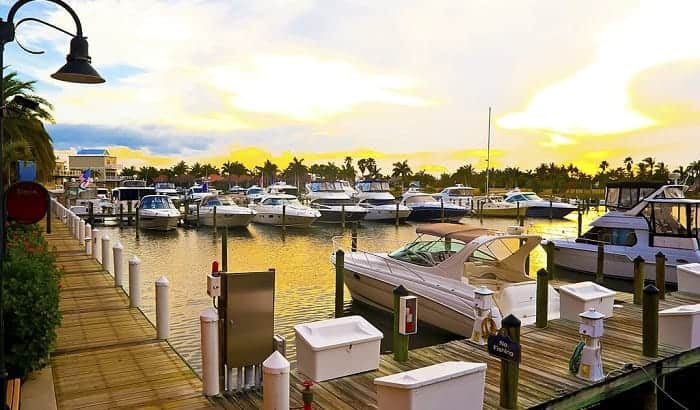
If you’re buying your first ever boat, one of the questions you may have in mind is, How much does it cost to dock a boat? It is one of the vital things for boat owners, as they need a place to keep their crafts safe and secured.
When docking at the right place, you can also comfortably and conveniently step aboard. But all these benefits come with a price tag. The yearly cost of docking for regular sailboats starts from $800 to $1 800.
A dock slip can cost from $12 to $240 per foot every year. The average is around $50. Docking fees for boats vary due to their length, location, and season. Learn more of the crucial details by reading this article.
Table of Contents
1. Regular docking slips
2. prime-location docking slips, 3. mooring vs anchoring, 1. availability, 2. security, 3. wet slip or dry slip, 4. minimum length, 5. the condition of the marina, 6. work policy, 1. electric, 3. pump-out fee, 5. membership fee, final words, how much does it cost to dock a boat – the cost of renting a boat slip.
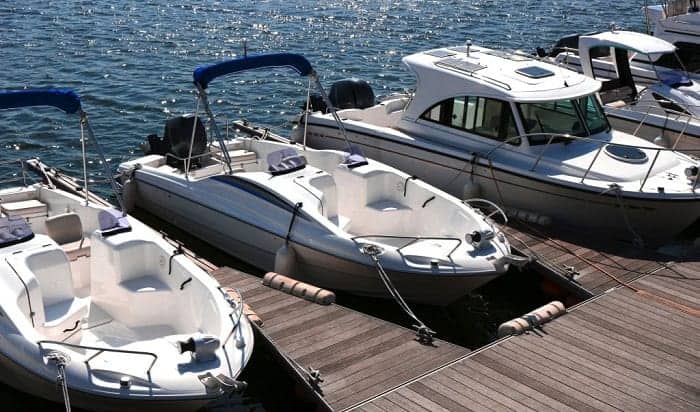
Just like everything else, the charge of boat slip depends on supply and demand. An increase in the price happens due to some situations.Usually, waterfront real estate is high-priced.
This estate does not only develop into marines and docks. They have another potential to be turned into a more profitable establishment. Some of these estates may not be ideal for docking in regards to local ordinances and ecological sensitivity.
There’s a hike in the cost of boat slips when the number of boaters increased. With these factors, the following details will be more specific. So, jot them down as notes and pay close attention.
These are simple berths found in marinas, situated in remote places like the coastline of small towns. Affordability is what makes these areas attractive.
However, they don’t offer easy access to popular sailing waters, unlike premium areas. The boat slip rental cost per hour can be $2 to $3. This is preferred by those who only drop by and do not stay for a long time.
Overnight stay can be from $4 to $6. You may also avail of this service monthly for $20 to $25 per foot, and annually for $23 or $24 per foot.
The charges vary depending on amenities, reservation time, and location. Electricity, dock box, freshwater, and tenant lounges are some of the things you can find in a boat slip.
The charge associated with regular docking slip multiplies when it comes to prime-location docking slip. It ranges from $120 to $240 per foot for yearly cost. Some areas even have a rate of $192 to $384.
The nightly rate for transient moorings starts at $20 and goes up to $45. The average boat slip cost is around $80 to $250 annually for any length of the boat. Vessels are usually from 24 feet to 72 feet. Here’s a chart that does the math for you:
| Boat Length | Regular Anchorage | Regular Dock | Prime – Location Dock |
| 24’ | $150 | $288 | $2 880 |
| 32’ | $150 | $800 | $5 120 |
| 40’ | $250 | $1 280 | $7 200 |
| 48’ | $250 | $1 920 | $9 600 |
| 72’ | $250 | $3 600 | $17 280 |
Apart from docking costs, expected extra charges in prime-location dock slips. Due to popularity, a marina’s price multiplies because of these charges. When you put yourself on a waiting list, you have to pay a $150 deposit to be in the queue.
You will need another $25 or $50 for a car parking card and security key. You should know that catamarans take up a lot of space. Thus, they charge an extra 20%.
As you can see, it all depends on the spot that you’ve chosen to rent. You may also buy a small boat to avoid paying a high cost for docking. Some small vessels will be fine with simple anchorage, which can be affordable even in a popular location.
There’s a time of the year that you can save some money when mooring. It’s the low season, and you can enjoy as much as a 70% discount. However, not all locations have this offer every year.
What Are The Types Of Berth?
In this part, we will talk about the differences between mooring and docking as well as the types of the berth.
It refers to the permanent spot of the vessel in the water. The anchor that you use to pin your boat in a certain location is linked to a single section on the seafloor. It means that the anchor stays behind when you leave.
There’s no direct connection to the land. So, this setup requires a small boat like a dinghy to get on your sailboat. On the other hand, an anchorage is a place where you anchor a vessel using your anchor, and you can’t access the land.
To relieve you from the hassle of walking back and forth when retrieving and deploying your anchor, you can get the MinnKota Deckhand Remote Switch. It can be installed with ease and use with no trouble because of its plug-and-play design.
When you tie your boat on an assigned spot at the shore, it’s called docking . Anchors are not required and what you need are fenders and lines. This is done on a marina with slips or berths. Simply, you can call it a parking space for your boats.
There are good fenders that you can find like Taylor Made Super Gard Fender, SWELL Big Bumper Ball, Taylor Made Freeboard Fender, and X-Haibei Boat Fenders.
Transient mooring means daily rent, and if you sum it up, it’s more expensive than permanent mooring, which is the reservation of slips for the entire season.
Mooring and anchoring differ in the anchorage’s location. The former is always offshore while the latter is beside the shore, which makes land accessible.
What sets each of them apart is the means of anchoring. Mooring uses the anchor provided in the location. In the case of anchoring, infrastructure is not present. You’ll have to use your anchor.
Considerations When Choosing A Slip For Docking A Boat
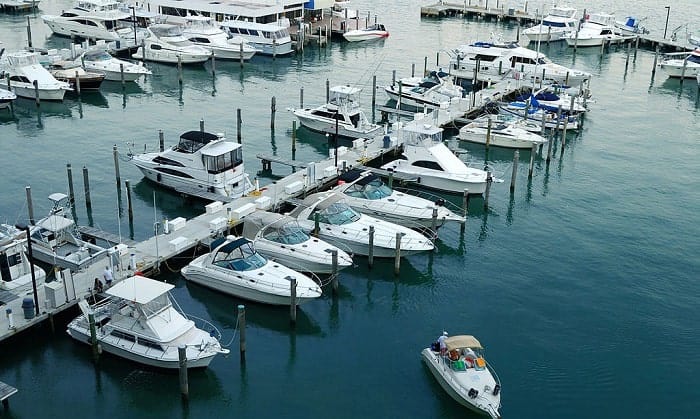
Choosing a marina or slip for docking is not as easy as you may think. Most marinas are known for their versatility in providing service, but dockage fees vary dramatically according to your choice.
Here are some considerations before deciding which slip you’ll take.
This is the fundamental thing you have to look at when hiring a service. You may need to arrange to be on the waiting list for popular marinas for peak season. Foresee shortage of slips as it can always happen.
The boats should be secured while at the slip. Marinas know this concern, and they’ve already prepared for it. Thus, controlled access to the docks and security guards should be present.
Wet slip is the main topic in this article. It’s how every boater can take their vessels in and out of the slip. Compared to dry slip, it costs higher. If you don’t use your boat regularly, dry slip is fine.
Efficiently renting out their spaces is the goal of marinas. A boat that is too small to occupy a slip; may not be desirable for marina owners. They would think it’s just a waste of money.
It’s the reason why the minimum length for boats is imposed. You’ll end up paying the entire slip even though your boat doesn’t use up the whole space. For instance, you’re obliged to pay the charge for a 20-foot boat slip despite having a smaller craft.
Be resourceful and ask around about the prevalent condition of the marina that you’re eyeing to dock your boat. Strong currents, large tidal waves, and exposure to the dock are some of the things you want to know.
Some marinas don’t allow outsiders to conduct professional service. They may have a list of recognized professionals who can make repairs and maintenance on your boat while being docked in their properties.
Other Charges
It can either be metered or with a flat fee. You may pay $10 to $50 per day. Variations take place due to your consumption or the gadgets and appliances that you use.
Some states put a tax on less than seven months’ stay at the marina.
Daily and weekly stays on the dock both need pump-outs. In some cases, the monthly stay would include this service in its price. But it can be an extra fee in some cases. A $5 charge may be added if public funding is involved in building the pump-up station.
You sometimes need to pay for someone who catches the line for you to plug your boat in. It’s termed as dockhand meet, and a tip of $5 or $10 is usually given in exchange.
Yacht club or resort membership fee is an additional charge if you’re not a member of the said organization.
Numerous factors should be weighed in for the right answer to ‘How much does it cost to dock a boat. It may depend on the marina where you’d like to dock your boat. The boat’s length is not the only basis as the slip size matters too.
Aside from paying the rent of the slip, you sometimes avail other services. These incur fees on top of the charge of renting a dock slip.

“I am James Harvey – founder of Boating Basics Online. It is established with the drive to help out first-time boaters, which are those desiring to explore their way through the water. So if you are new to boating, start from here with me. “
What Are the Cheapest Mooring Fees in the UK? (& Where)
Boat mooring fees in the UK often vary depending on factors such as boat length, location, and market demand. If you're looking for the cheapest options, we're here to help you find the most budget-friendly mooring spots that still offer fantastic amenities and picturesque locations. In some popular areas, like London and the South of England, there may be waiting lists, but with a bit of patience and research, you'll be able to find the perfect spot for your boat at an affordable price.
The cheapest mooring fee starts at £1,000 and can be found in the Leeds and Liverpool Canal, Rochdale Canal, Huddersfield Narrow Canal, Caledonian Canal, Forth and Clyde Canal, Union Canal, River Thames, Grand Union Canal, Monmouthshire and Brecon Canal, Portsmouth Moorings, Littlehampton Marina, and municipal harbors.
Be prepared to shop around and join waiting lists if necessary. Popular locations, such as London and the southern Midlands, tend to have higher demand and longer waitlists.
- You may want to check out online forums, like the YBW Forum, to gather information and insights from fellow boaters regarding affordable marina options in the UK.
- To find the cheapest mooring fees, consider your requirements and prioritize the facilities and services you need.
- You might save on mooring costs by choosing a marina with fewer amenities or services if it meets your basic needs.
- Consider the type of mooring you need, the duration of your stay, and the services you require, so you'll be able to find the most cost-effective solution that suits your needs.
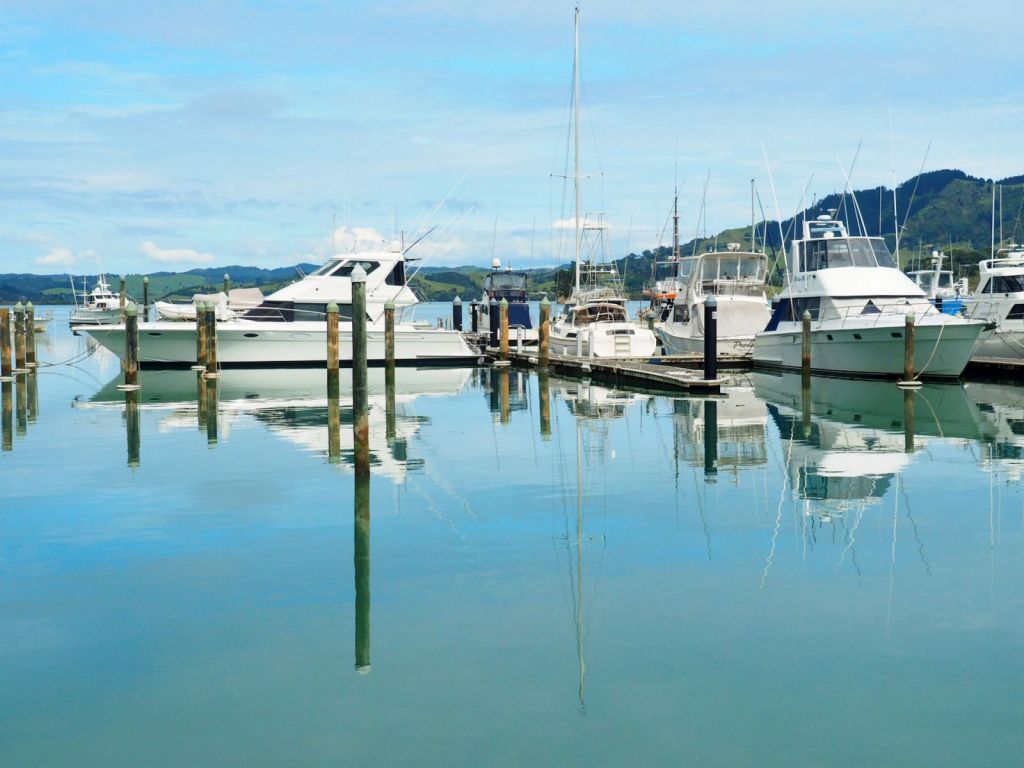
On this page:
Cheapest mooring locations in the uk, alternative affordable mooring options, key factors affecting mooring costs, comparing mooring prices of the available options, how to find the best mooring deals.
| Mooring Locations in the UK | |
|---|---|
| Leeds and Liverpool Canal, Rochdale Canal, and Huddersfield Narrow Canal | |
| Caledonian Canal, Forth and Clyde Canal, and Union Canal | |
| River Thames | |
| Grand Union Canal | |
| Monmouthshire and Brecon Canal | |
| Portsmouth Moorings, and Littlehampton Marina | |
| Municipal harbours |
Canal and River Trust offers mooring sites for a variety of boat types
Inland canals and rivers in the UK, such as the Leeds and Liverpool Canal , Rochdale Canal , and Huddersfield Narrow Canal , are managed by the Canal and River Trust, which offers a range of mooring options for boaters, including long-term, short-term, and visitor moorings. These locations range from fully serviced marinas to simple spots alongside a canal or riverbank.
Prices can vary depending on the location, facilities available, and length of your boat, but they are generally considered to be more affordable than traditional marinas.. Annual fees for long-term moorings can range from around £1,000 to £5,000 or more .
Scottish Canals manage moorings for budget-conscious boaters
These moorings managed by Scottish Canals are scattered across Scotland and provide various levels of service and amenities. Some of them even offer free mooring for the first few days. Be sure to research the specific location you're interested in, as prices and facilities can vary.
Scotland has a number of affordable mooring options, particularly along the canals and rivers in the region. The Caledonian Canal , for example, offers a range of mooring options for boaters, with prices ranging from around £1,000 to £3,000 or more . Other canals in the region, such as the Forth and Clyde Canal and the Union Canal , also offer affordable mooring options.
Northern England has a number of affordable mooring options
These moorings are found along the canals and rivers in the region. The Leeds and Liverpool Canal , for example, offers a range of mooring options for boaters, with prices starting at around £1,000 per year . Other canals in the region, such as the Rochdale Canal and the Huddersfield Narrow Canal , also offer affordable mooring options.
Southern England has a mix of affordable and more expensive mooring options
London also has a range of mooring options available , with prices varying depending on the location and facilities available. The River Thames offers a number of mooring options, with annual fees for long-term moorings ranging from around £2,000 to £15,000 or more . Some of the more affordable options can be found in less popular areas, away from the main tourist spots.
The southern Midlands region of the UK, which includes cities such as Birmingham and Oxford, also has a range of mooring options available. The Grand Union Canal , which runs through the region, offers mooring options for boaters, with annual fees for long-term moorings ranging from around £1,000 to £5,000 or more .
Portsmouth Moorings , located on the south coast of England, offers a range of mooring options for boats of different sizes. Prices can vary depending on the location and facilities available. Annual fees for long-term moorings can range from around £2,000 to £10,000 or more , depending on the size of your boat and the facilities available.
Wales also offers mooring options starting at £1,000 per year
These moorings are found along the canals and rivers in the region. The Monmouthshire and Brecon Canal , for example, offers affordable mooring options for boaters, with prices starting at around £1,000 per year .
Private marinas offer mooring fees starting at £2,000
Some of them offer competitive pricing and flexible options. For example, Littlehampton Marina in West Sussex prides itself on offering reasonable rates for their moorings. Annual fees for long-term moorings can range from around £2,000 to £10,000 or more . Make sure to compare fees and services to ensure you're getting the best deal for your needs.
Municipal harbours offer moorings from £1,000 a year
Lastly, municipal harbors controlled by local authorities can be a more cost-effective option for mooring your boat. Some of them offer cheaper mooring rates compared to private marinas. Be on the lookout for harbors with lower fees, and keep in mind that facilities may be more limited than what you'd find in a private marina.
Municipal harbors in the UK offer mooring options for boaters, with prices varying depending on the location and facilities available. Annual fees for long-term moorings can range from around £1,000 to £5,000 or more .
In this section, we will explore swing moorings, visitor moorings, and winter moorings as potential alternatives that might suit your needs and budget.
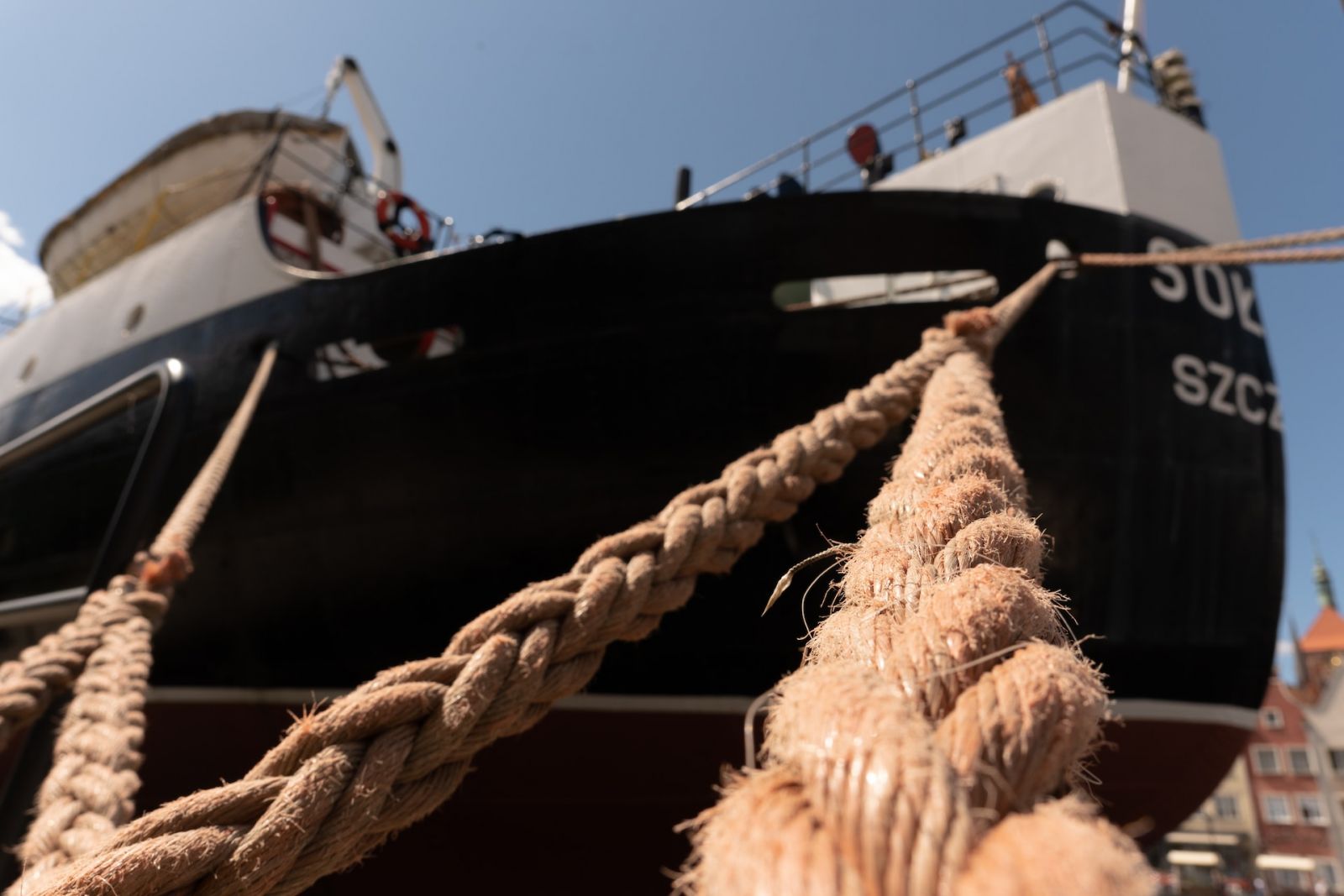
Swing moorings can be more affordable compared to marina berths
They usually consist of a buoy or anchor attached to a chain that allows your boat to swing with the tide and wind. To find a suitable location, browse for options on forums such as the YBW Forum . Prices will vary depending on the area, but swing moorings are generally cheaper than a full-service marina.
Visitor moorings are specifically designed for short-term use
If you're just passing through an area or need a temporary place to moor your boat, visitor moorings can be a cost-effective option. These moorings are specifically designed for short-term use, usually ranging from 24 hours to a few weeks. While not intended for long-term stays, they can provide a convenient and economical alternative when needed. Prices will depend on the location and facilities available, but visitor moorings are usually cheaper than a permanent berth.
Winter moorings can be your option during the off-season
As demand for moorings often decreases during the winter months, many marinas and mooring providers offer discounted rates for long-term stays. This allows you to keep your boat securely moored at a lower cost while also freeing up space in the marina during the busier summer months. To find winter mooring options in the UK, check out websites like the Canal & River Trust for available locations and pricing.
Now, let's explore the following factors that will influence mooring fees in the UK : the size of your boat, the location and demand, and the amenities and services of the marina.
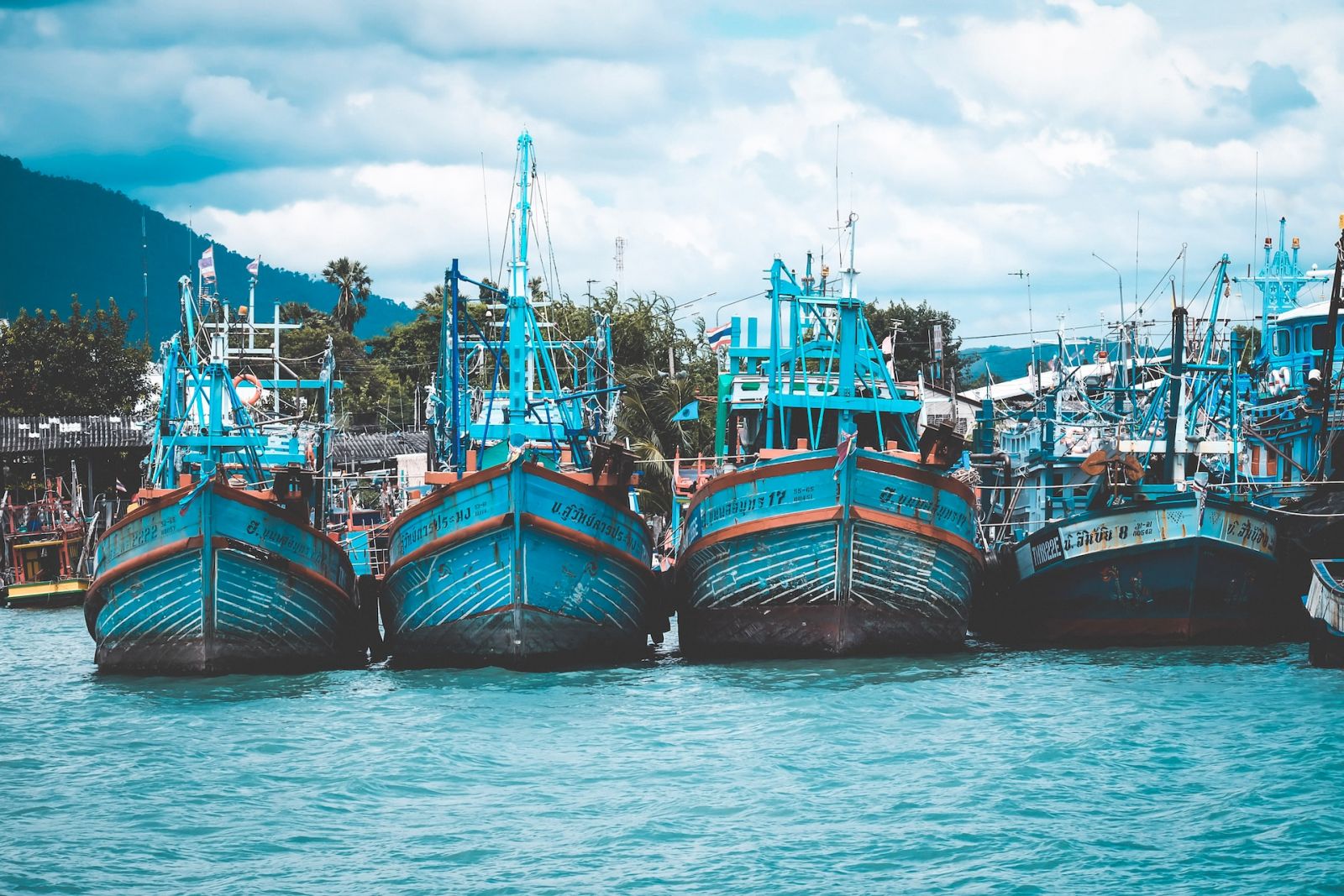
Length and width of the boat : The size of your boat, including its length and width, is a significant factor in determining the mooring fees you'll be charged. Most marinas and mooring facilities charge fees based on your boat's dimensions. The larger and wider your boat is, the higher the mooring fees will be. Be sure to consider your boat's size when comparing mooring costs.
Location and demand : Mooring fees can vary significantly based on location and demand. Popular boating areas or locations with limited availability tend to have higher mooring costs. On the other hand, locations with lower boat traffic or more mooring options may have cheaper fees. When searching for a more cost-effective mooring option in the UK, consider lesser-known areas or those with less demand.
Amenities and services : The facilities and services offered by the marina can also affect the mooring fees. Marinas with more comprehensive amenities and services tend to charge higher fees. These amenities could include wifi access, fuel services, waste disposal, security systems, and onsite maintenance services.
In this section, we'll discuss the differences in price between long-term vs. short-term moorings, marinas vs. private moorings, and residential vs. non-residential options.
Long term vs short term mooring fees
Long-term mooring fees are generally priced according to boat length and the popularity of the area . Demand may result in higher prices in the south, where land prices are highest, and sites with more sophisticated services command higher fees.
On the other hand, short-term mooring fees can vary depending on the location and services offered . While it is generally more cost-effective to go for a long-term mooring, make sure to consider your specific needs and how often you'll use the mooring before making a decision.
Marinas vs private moorings
Marinas provide a range of services and facilities that may result in higher fees compared to private moorings. However, it's important to consider what services you require, as private moorings may lack the conveniences you desire.
| Marinas Services and Facilities | Private Moorings Services and Facilities |
|---|---|
| Enhanced security | Lower costs |
| Onsite facilities and services | More secluded locations |
| Social opportunities | Fewer restrictions |
Weigh the pros and cons of each type of mooring to find the best fit for your budget and needs.
Residential vs non-residential
Residential moorings are designed for those who live full-time on their boats, and these fees usually include utility usage and additional amenities. Non-residential moorings offer a lower-cost solution for those who only need a mooring for recreational purposes. However, you should be aware that residing on a non-residential mooring, even temporarily could result in fines or eviction from the mooring site.
In this section, we'll explore some methods for finding the cheapest mooring fees in the UK, with a focus on online platforms, networking with other boaters, and contacting local marinas and harbors.

Use online platforms to compare mooring fees and services
The internet is a treasure trove of information when it comes to finding affordable mooring deals. Use online resources, such as boats.com , to compare mooring fees and services across different locations in the UK. Don't forget about social media groups and forums dedicated to boating, where fellow boaters may share their experiences and recommendations for cost-effective moorings.
Network with boaters to gather information about mooring options
Nothing beats word-of-mouth recommendations from experienced boaters. Network with fellow boating enthusiasts, either in person or through online forums like Canal World . By connecting with others who share your passion for boating, you can gather valuable information about hidden gems and the most affordable mooring options.
Contact local marinas and harbours to inquire about mooring fees
Reaching out directly to marinas and harbors is another effective way to find the best mooring deals in the UK. By contacting these establishments, you'll be able to inquire about their pricing, available services, and any special discounts or promotions they may have. In certain cases, you may even be able to negotiate a better rate for longer-term mooring agreements. Keep your options open and always maintain a friendly, professional tone when inquiring about mooring fees.
Leave a comment
You may also like, what's the cheapest mooring in london (3 surprising places).
You might be surprised to know that there are a few hidden gems around London that offer some of the cheapest mooring rates in the city. In this article, we'll …
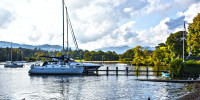
How Much Is It to Dock a Boat in the UK? (5 Boat Types)
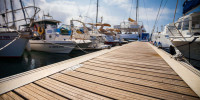
How Much Does it Cost to Dock a Boat for a Year?

Average Cost of Buying & Owning a Catamaran (With 4 Examples)

How Much Sailboats Cost On Average (380+ Prices Compared)
Why Book With Us?
Competitive prices, Exceptional Service
ONLY Professional Charter Fleets
Rated 4.9/5 on Feefo
Super-low 25% deposit
Berthing / mooring fees in Croatia and Greece
How much does it cost to spend the night in a marina in Croatia, Greece, the Med and the Caribbean? We give you the lowdown!
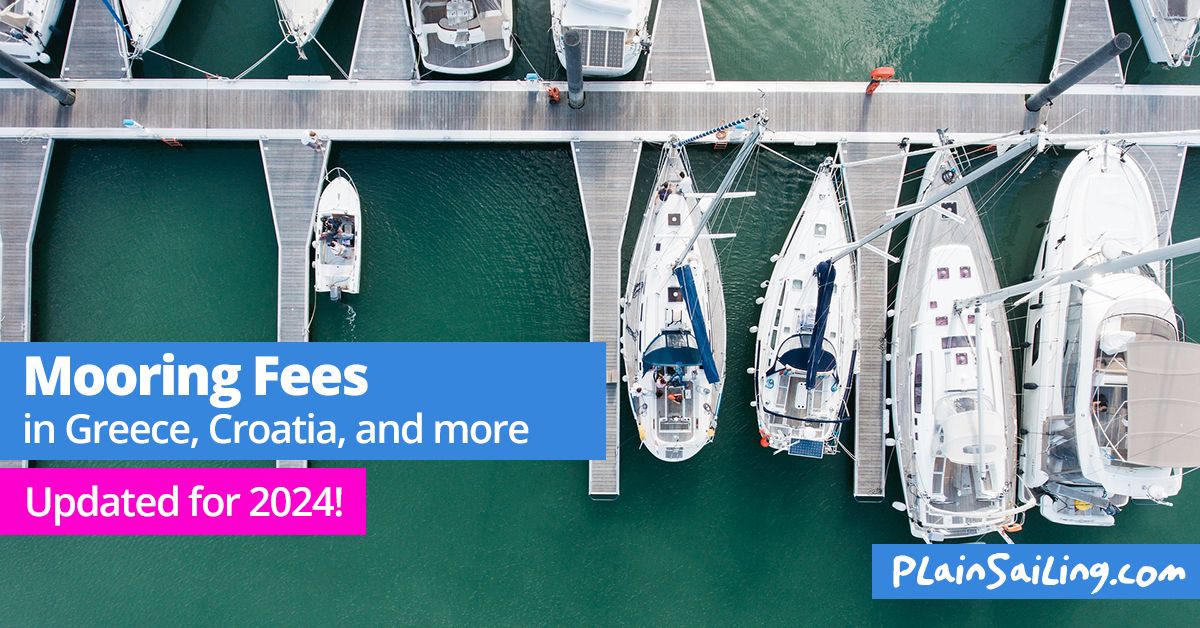
Last updated: April 2024
One of the things you’ll have to pay for during your charter is mooring or berthing fees – which are fees for staying in a marina or harbour overnight, and connecting to their electricity or using their water supplies, toilet facilities, ropes and pontoons.
Unfortunately, there is no easy answer to ‘how much will it cost us in berthing fees?’ because it depends upon where you are chartering, what you are chartering, as well as where you choose to stay, and prices vary massively - but what we do know is below.
The first and last nights of your stay will be at your home marina, so you won’t need to pay anything for these. Likewise, you can stay in anchorages for free (but obviously you won’t have access to electricity) – though be aware that they may charge you for a National Park pass if you overnight in one of a national marine parks - particularly in Croatia.
We also include some useful links for pre-booking your berth in the marinas online, which is a growing phenomenon - there is no real market leader at the moment, but things will improve in future years. Often it is best to search for the marina directly to see if you can book a berth online, or if it explains how or if you can book.
Be aware that marina bookings are often not cancellable or refundable, so it is potentially worth waiting until you know what the weather will be like before you spend the money and make a booking.
Click for more about berthing or mooring fees in Croatia , Greece , Italy , France , Malta , Montenegro , Spain , Turkey , England , Scotland , or the Caribbean
Berthing fees in Croatia
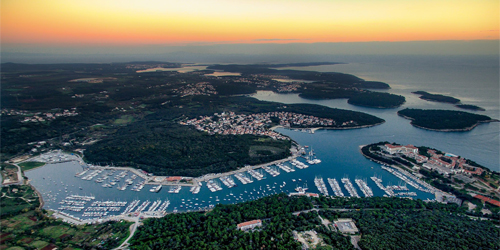
Since sail-tourism is still relatively new in Croatia, marinas are generally privately owned and reasonably modern. ACI - who, with 22 marinas, operate the largest chain of marinas in the whole of the Mediterranean, and covering much of the Croatian coast – were once owned by the state, but have since been sold to privatise investors.
ACI's relative monopoly (and recent investment or development costs) means that they drive the pricing in the market though, and you’ll find that prices in Croatia are substantially higher than in Greece.
SAMPLE COSTS
Mooring fees are charged by the night, and prices change depending on your location, the time of the season, and upon the length of your boat in metres (in the case of Catamarans, they also charge a supplement of up to 50-60% for the additional width of your boat).
The table below gives an idea of daily berthing prices for low and high season across the country. These are sample prices for 2024:
| Boat Length | Boat Length | |||||
| 35’ / 10m | 45’ / 13m | 55’ / 16m | 35’ / 10m | 45’ / 13m | 55’ / 16m | |
PRE-BOOKING A BERTH IN CROATIA
The Croatians are ahead of the game when it comes to pre-booking berths, and they better understand how marina-hopping sailing should work. However, most of their marinas are also pretty vast, so pre-booking isn’t essential (particularly outside of high season), and beware of booking too far in advance, as most pre-bookings have no cancellation policy, so you won’t get any refund if you can’t make it to the right marina.
Almost all marinas will allow you to pre-book a berth (to guarantee it is there for you at the end of the day) – many give the option to book online if you google their websites, including the ACI marinas website . Many marinas are also now listed on Marinareservation.com and there are a growing number of marinas which are click-and-bookable on the Navily App .
You can also use the new ‘My-Sea’ to book yourself a berth at any of the ACI marinas (or plenty of others in Croatia) from your smartphone browser or via their App – the prices seem to be about the same as if you go direct.
Berthing fees in Greece
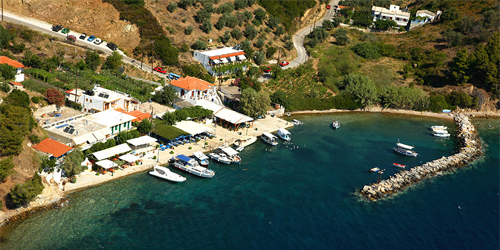
Marina and harbour facilities in Greece are different from Croatia because, with more islands and being further from the mainland, sailing is much more a part of the normal way of life on the Greek islands, and because things have built up over the years.
Whereas the Croats are seeking a return on their investment in developing the marinas over the recent years, the Greek infrastructure has been in place for many, many years, it serves locals as well as tourists, and they place greater value on the benefits to the local economy that a yacht in the marina can bring (with likely spending at the local shops, tavernas and bars) – consequently, the amount you’re charged for a berth with electricity and water is lower, and sometimes even free.
At the moment, whilst the Greek islands do have internet, there isn’t a great deal of information out there about marinas, what they offer, and how much they cost. Many of them – particularly the ones on the islands - are either free or there is a token charge of €20-30 a night. Of the larger marinas, here's some guide prices for mooring fees in 2024:
| Boat Length | Boat Length | |||||
| 35’ / 10m | 45’ / 13m | 55’ / 16m | 35’ / 10m | 45’ / 13m | 55’ / 16m | |
PRE-BOOKING A BERTH IN GREECE
The prevailing wisdom at the moment seems to be that people have been sailing in Greece for centuries and that they never needed to pre-book then, so you don’t need to pre-book now. Consequently, the Greeks don’t go out of their way to make it easy to pre-book a berth. Countering that, though, they will always try to find a space for you in their marina - even if it means tying onto another yacht - so pre-booking isn’t always necessary.
Online booking still isn't very big in Greece, but some marinas do now have websites, or if you can find a number to call, it’s probably best to phone the marina direct to try to pre-book.
Berthing fees in Italy
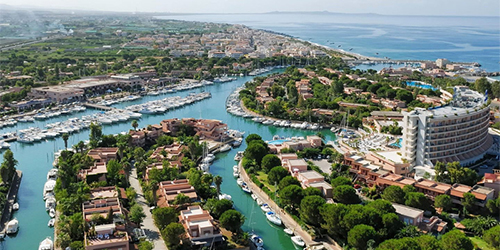
Italy has been undergoing something of a renaissance over recent years, and many of the marinas here have been evolved into grand coastal developments, boasting all the latest mod cons – including baby-sitting services, courtesy hire-cars, swimming pools and tennis courts – as well as myriad stunning marina-side apartments, with shops and leisure facilities open all year round for their wealthy owners.
As a result of all this investment, whilst the marinas are certainly much nicer places to stay, they’re also on the expensive side of the market. Of course, you would expect key marinas around the Amalfi coast, Capri and Ischia to be expensive, but even the smaller marinas on distant islands seem to charge premium rates.
Mooring fees below are charged by the night, and catamarans can expect to pay a surcharge for the extra width that they take up on the pontoon. The bigger, renovated marinas have excellent information online, but the table below gives a good sample of 2024 rates:
| Boat Length | Boat Length | |||||
| 35’ / 10m | 45’ / 13m | 55’ / 16m | 35’ / 10m | 45’ / 13m | 55’ / 16m | |
PRE-BOOKING A BERTH IN ITALY
The majority of Italian marinas have an online presence and it’s usually possible to book or request a quote online before you arrive, but they are almost all independently operated (so you have to go direct to the marina website), and there isn’t currently one single place to go to get berths booked - though there are a growing number of marinas which are click-and-bookable on the Navily App .
Berthing fees in France
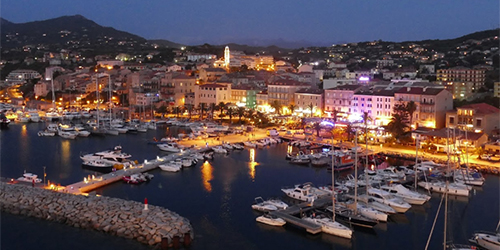
The set-up of marinas in France is markedly different to the rest of Europe, as the coastline is controlled by local regional councils, so, whilst there are huge private marina developments with five-star services, in most towns you will also be able to find a municipal marina, probably in not quite as glamourous a location, but for much more reasonable overnight fees.
Obviously the experience is slightly different, but it does make sailing more accessible and means that, for example, you can sail to Cannes and berth there for under €40. There seems to be no upper limit on how much you can expect to pay for the biggest boats in the best and best-located marinas, and F1 week in Monaco will set you back €1,500 a night, but you have to stay there for the full week, so you’re looking at €10,500 for 7 days.
We’ve gathered prices in the table below as minimum mooring fees per night. If mooring fees are an issue, it is worth shopping around and researching which marina to head to – many of the towns on the French Riviera have as many as five different marinas, all charging their own prices. These are some sample 2024 rates:
| Boat Length | Boat Length | |||||
| 35’ / 10m | 45’ / 13m | 55’ / 16m | 35’ / 10m | 45’ / 13m | 55’ / 16m | |
PRE-BOOKING A BERTH IN FRANCE
Similar to Italy, you can find most French marinas online, and the majority will allow you to send bookings or enquiries to the harbourmaster. There isn’t an over-arching one-stop-shop for berths in France (yet), so it’s worth contacting the marinas direct by email or telephone once you know where you would like to go.
Berthing fees in Malta
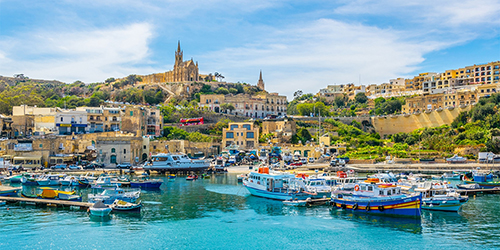
There aren't a vast number of marinas around the islands of Malta and Gozo (but there are plenty of beautiful anchorages), and whilst they are busier in August, they never get to the same level of 'busy' as the most popular marinas in, say, Greece and Croatia - in fact, most boats boats clamour for the best spots in the anchorages, like the blue lagoon instead of the marinas.
The prices below give an idea of the mooring fees per night in some of the marinas the area. Marina fees are not generally published online, but you should be able to contact the marina directly to get their latest rates. These are some sample 2024 rates:
| Boat Length | Boat Length | |||||
| 35’ / 10m | 45’ / 13m | 55’ / 16m | 35’ / 10m | 45’ / 13m | 55’ / 16m | |
PRE-BOOKING A BERTH IN MALTA
Similar to Italy and France, you can find contact details for many Maltese marinas online, and the majority will allow you to pre-book a berth by contacting them directly (but there is no over-arching app or website which will allow you to do this easily).
Berthing fees in Montenegro
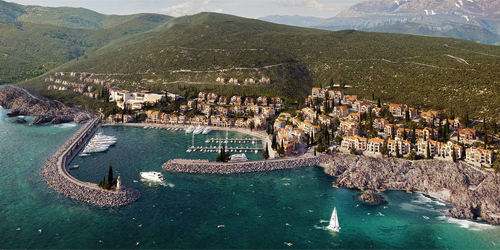
Montenegro is the new kid on the block as far as sailing goes. It only really started to take sail-tourism seriously within the last decade – but it really is taking it seriously: there are already four multi-billion-euro marina developments in construction (and more planned) to maximise the outstanding natural beauty of the area, and to build upon the increasing adventurousness of people who have now sailed in Croatia for a few years now.
To entice super-yachts, they have the world’s longest marina berth – capable of taking a yacht over 250m in length – and one of their marinas has a whole brand new village, town centre, six star hotels and even a golf course. At the moment, the marinas are more modern than those in Croatia, but priced cheaper to try and get people to try them out, on the basis that once you’ve sailed in Kotor bay, you won’t want to sail anywhere else.
The table below shows 2024 overnight rates at some of our favourite marinas in the country, including the mega-marinas of Porto Montenegro and Lustica bay. Catamarans can expect to pay a surcharge of 50-75% on top of this:
PRE-BOOKING A BERTH IN MONTENEGRO
There is no sole owner of all these marinas, so there is no single place to go to book yourself in. For the bigger, newer developments, you can usually book online, but the smaller, older marinas like Herceg Novi, Budva and Bar still largely rely on telephone calls to make a reservation, if you can make reservations at all.
Berthing fees in Spain
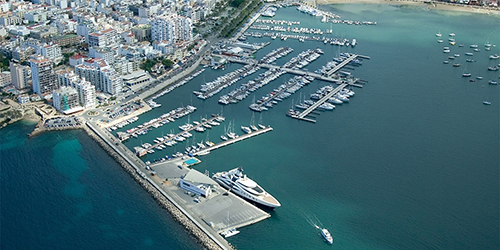
All boats are charged based on their square meterage (calculated as the length of the boat multiplied by the width or beam, and then all multiplied by a price per square metre) - so catamarans can expect to be charged an additional 80% on top of the prices for a yacht below.
Marinas are usually modern and comfortable, and now almost all have floating pontoons, which means that you don't have to wake during the night to tighten or slacken off ropes attached to the land in line with the latest tides.
The prices below give an idea of the mooring fees per night in some of the marinas in each area. In addition, there may be surcharges or meters for calculating water or electricity use. These are some sample 2024 rates:
| Boat Length | Boat Length | |||||
| 35’ / 10m | 45’ / 13m | 55’ / 16m | 35’ / 10m | 45’ / 13m | 55’ / 16m | |
PRE-BOOKING A BERTH IN SPAIN
Some Spanish marinas are now online, but the vast majority are not, and you will need to telephone or VHF them to ask about availability and to book a space. Most marinas are small independent marinas which are run by local sailing clubs, though some of the larger ones (particularly in the Canary islands) are operated alongside the town harbour (where they deal with ferry and cruise traffic as a priority).
Berthing fees in Turkey
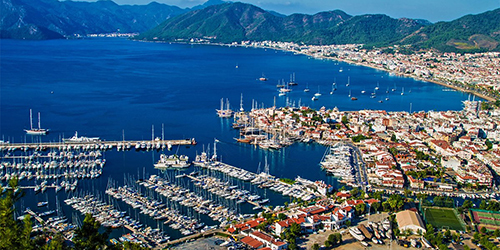
The prices below give an idea of the mooring fees per night in some of the big marinas in each area. These are some sample 2024 rates:
| Boat Length | Boat Length | |||||
| 35’ / 10m | 45’ / 13m | 55’ / 16m | 35’ / 10m | 45’ / 13m | 55’ / 16m | |
PRE-BOOKING A BERTH IN TURKEY
Most of the bigger marinas are online and will gladly take bookings either online, via email or over the phone. Restaurants will also accept bookings (usually by phone, unless they are particularly tech-savvy) - be sure to ask what time you need to be there by, as they do tend to try to fill up their berths and will only wait so long for you to arrive.
Berthing fees in England
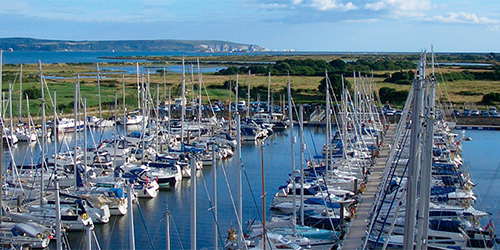
The prices below give an idea of the mooring fees per night in some of the marinas in each area. Most are calculated as a price per foot of length. These are some sample 2024 rates:
| Boat Length | Boat Length | |||||
| 35’ / 10m | 45’ / 13m | 55’ / 16m | 35’ / 10m | 45’ / 13m | 55’ / 16m | |
PRE-BOOKING A BERTH IN ENGLAND
Most marinas are now bookable online - just google the name of the marina you would like to stay at and book direct (there isn't a one-stop shop to book all the marinas in England, though there are now a number of marina chains which manage or run a number of marinas in the area, which makes things a little simpler).
Berthing fees in Scotland
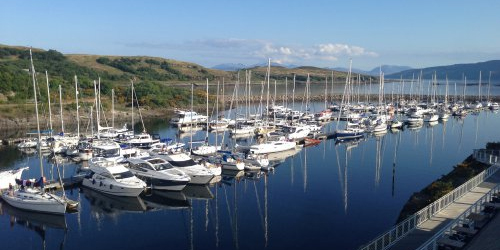
The prices below give an idea of the mooring fees per night in some of the marinas in each area. These are some sample 2024 rates:
| Boat Length | Boat Length | |||||
| 35’ / 10m | 45’ / 13m | 55’ / 16m | 35’ / 10m | 45’ / 13m | 55’ / 16m | |
PRE-BOOKING A BERTH IN SCOTLAND
The bigger, more commercial marinas are now bookable online, but smaller and more remote marinas - such as those in the outer Scottish islands - are more likely to accept bookings by telephone or email. Most like to know you are coming, but pre-booking is not usually necessary, as there is usually plenty of space for everyone.
Berthing fees in the Caribbean
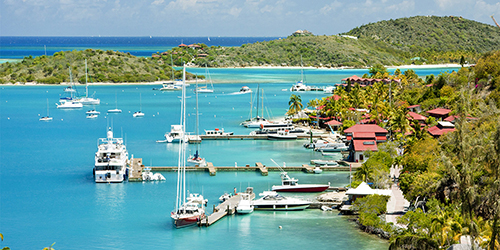
There is no set policy on pricing: whilst some remote marinas - such as Carriacou in Grenada - see their remote-ness as a reason to lower their prices (to encourage cruising sailors out to them), others - such as Hope Town in the Abacos - see it as giving them a natural monopoly, and inflate their prices accordingly.
Similarly, the standard of berthing facilities range from fairly basic to luxury, so it is worth doing a little research to check that you are heading to the sort of place and facilities you want to head to, and that they will charge the sort of prices you would like to pay.
In very high-season (December and March / April) it is usually worth pre-booking a space, and even mooring buoys can be pre-booked online.
We’ve gathered prices in the table below as minimum mooring fees per night. These are some sample 2024 rates in Antigua, the Bahamas, BVIs, and Grenada:
| Boat Length | Boat Length | |||||
| 35’ / 10m | 45’ / 13m | 55’ / 16m | 35’ / 10m | 45’ / 13m | 55’ / 16m | |
PRE-BOOKING A BERTH IN THE CARIBBEAN
As you might expect, Caribbean marinas are a mixed bag and can be difficult to book. Whilst some are bookable online, others are difficult to find even contact numbers for you - including the ones in big resorts, where the marina can often be there mainly as something for the holiday-makers to enjoy having views over or condo's nearby, as opposed to operating as a marina in its own right. In the BVIs, you can pre-book mooring buoys with Boatyball.com .
Tags: Marina fees Croatia; Marina fees Greece; Marina fees Italy; Marina fees France; Marina fees Malta; Marina fees Montenegro; Marina fees Spain; Marina fees Turkey; Marina fees England; Marina fees Scotland; Marina fees Caribbean; Berthing in Croatia; Berthing in Greece;


IMAGES
VIDEO
COMMENTS
An average sailboat costs between $800 - $1,800 per year. The price depends on location, season, and length of the boat. On average, a dock slip in the US costs anywhere between $12/ft per year to $240/ft per year, with an average of roughly $50/ft per year. Renting a spot at a marina is called 'renting a slip' or 'renting a berth'.
So for example, a 20-foot boat should usually have at least a 100 pound mushroom mooring to be safe, whereas a 35-foot boat may required a 350-pound mooring to be safe. It is best to consult the harbor or marina where you are placing your mooring for advice when choosing the weight of your mooring.
Miami, Florida. $5/ft. $23 to $24/ft. $42/ft. Even docks in the same city have different fees. For example, docking a boat in Yacht Haven Marina in Los Angeles is $10.50 to $12.95/ft a year. On the other hand, Marina del Rey in the same city will charge $192 and $240/ft per year. The same is overseas.
In Croatia, yacht berthing or mooring fees range between €435 - €1050 / m per year (€145 to €350 per ft.) for a high season contract. Greece annual fees are between €225 - €525 / m per year (€75 to €175 per ft.). Monaco is one of the most expensive destinations. A berth in Monaco costs about €1500/ m per year. Country.
A 180-foot superyacht and/or mega yacht costs a minimum of $4.75 million per year to operate and maintain. Kitty McGowan of the US Superyacht Association estimates an annual budget of $1 million for maintenance and repairs, $350,000 for dockage, $240,000 for insurance, $400,000 for fuel, and $1.4 million for the crew.
Taxes Cost: Varies. 5. Mooring (Keeping Your Boat in The Water) Mooring costs fluctuate fundamentally based on geographic location, the size of your boat, specialized boat care, proximity to restaurants and other facilities, etc. If you want a premium marina with round the clock security and incredible scenery, then you're going to pay ...
Mooring involves securing a boat to a fixed structure such as a wharf, buoy, or jetty. It is essential to understand the basics of mooring and the different techniques and types of anchors to use. Choosing the right mooring spot is crucial to ensure the safety of the boat. Factors such as water depth, wind, and current should be considered when ...
Private docks in Fort Lauderdale for a 45' catamaran will typically run $800 to $1000. In Fort Pierce the rates are more likely $600 to $800. Mooring balls are typically the lowest cost option - in the ballpark of $200 to $300 per month. A mooring ball with adequate swing room can usually fit a monohull, catamaran or powerboat equally well ...
Conclusion. In the vast tapestry of maritime adventures, mastering the art of boat mooring emerges as a beacon of skill and responsibility. This guide, spanning the spectrum from fundamental basics to specialized techniques, equips seafarers with the knowledge to navigate the waters with confidence. Understanding the nuances of boat mooring ...
Mooring and Boat Storage While the exact cost of mooring changes by the region and the nature of the marina, fortunately, with a little bit of legwork you can nail down exactly how much this will cost you each season. Slips can range from a couple hundred dollars a month for a runabout kept in a municipal marina, to a thousand or more dollars a ...
Mooring is going to cost you plenty. Fortunately, it's a fixed cost from year to year, and that makes it easy to plan for. Decide where you'd like to be based, get a quote, and do the math. But don't forget to include off-season hauling and storage costs, if you live in an area where boats come out of the water during the winter months.
The cost of mooring varies from location to location, and boat mooring rates are determined by the facility, amongst other factors. The prices of these moorings are determined by various charges. Such charges include license fees, mandatory insurance payments, mooring fees, and additional costs. ...
Yes, I would like to Opt-in to receive communications and offers from Moorings Yacht Ownership Download pdf Moorings 403PC View Boat Get Quote ... In our Guaranteed Income Program, you pay 100% of the yacht cost at the start and receive the title and a payment each month. You can choose to buy with cash or finance the yacht purchase.
At the lower end of the market, it's possible to get third-party-only cover from under £100 per year, while a standard fully comprehensive policy for a yacht worth £100,000 can be as little as 0.5 per cent of its value. Moorings are often the biggest annual cost of boat ownership. The more convenient the location and facilities, the more ...
Yacht Ownership. Experience the joy of owning a first-class yacht and sailing in some of the world's best cruising grounds, all while receiving guaranteed monthly income in our charter yacht management program. Or, buy a new or used boat from us for private use. The Moorings Yacht Sales offers 3 ways to buy and enjoy the finest performance ...
Many costs, such as moorings and boat yard lift outs / storage, tend to vary with the overall length of the boat, including appendages. The exception is some Mediterranean marinas that charge on the basis of the area the boat occupies - i.e. length and beam. This means costs increase roughly with the square of the overall length.
The costs of mooring a boat in the Caribbean vary depending on the island, location, size, and type of boat. The cost ranges from $0.65 to $4 per foot per day. A 40ft boat will cost between $26 and $160 per day and between $780 and $4800 per month without any discounts. On the other hand, anchoring is in most places free of charge.
Summary. Mooring fees in Europe can range from €10-€160+ per night for a 10-meter boat, depending on the location and season. Mooring on inland waterways in the UK is the cheapest option, with rates ranging only from £6-£15 per night for a 10-meter boat. Next to the waterways, marinas and ports in Bulgaria and Turkey offer the ...
The yearly cost of docking for regular sailboats starts from $800 to $1 800. A dock slip can cost from $12 to $240 per foot every year. The average is around $50. Docking fees for boats vary due to their length, location, and season. Learn more of the crucial details by reading this article.
Whatever your needs, The Moorings is sure to have a yacht that is right for you. Choose from a fleet of monohulls and catamarans ranging from 37 to 58 feet, with 2 to 6 cabins. ... we suggest an average of 15-20% of the total charter cost for Crewed Yacht Charters, and 15-20% of the daily Skipper fee for Skippered Bareboat Sailing or Power ...
Private marinas offer mooring fees starting at £2,000. Some of them offer competitive pricing and flexible options. For example, Littlehampton Marina in West Sussex prides itself on offering reasonable rates for their moorings. Annual fees for long-term moorings can range from around £2,000 to £10,000 or more.
Water, Ice & Fuel*. The Moorings sailing yachts are delivered with a full water tank, full fuel tank (excluding the Mediterranean), and 2 bags of ice in your cooler. Complimentary water and 2 additional bags of ice are available from any Moorings base. A full tank of fuel is included in the price for all The Moorings sailing yachts.
Berthing fees in Croatia. In Croatia, yacht berthing or mooring fees range from €70 per night for a smaller yacht in low season, to €200+ per night for a larger yacht in high season. Catamarans can expect to pay an additional 50-60% on top of that, too, meaning marina fees of €200 per night. Since sail-tourism is still relatively new in ...